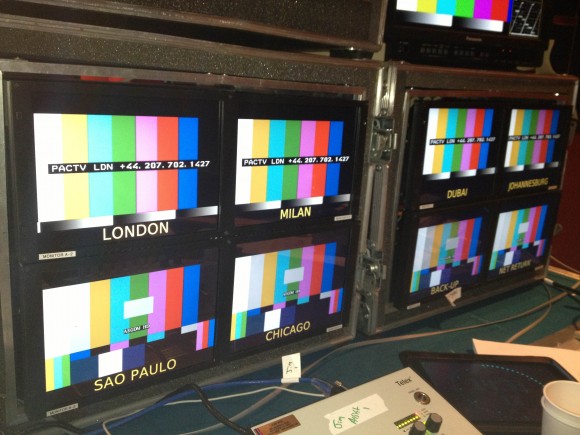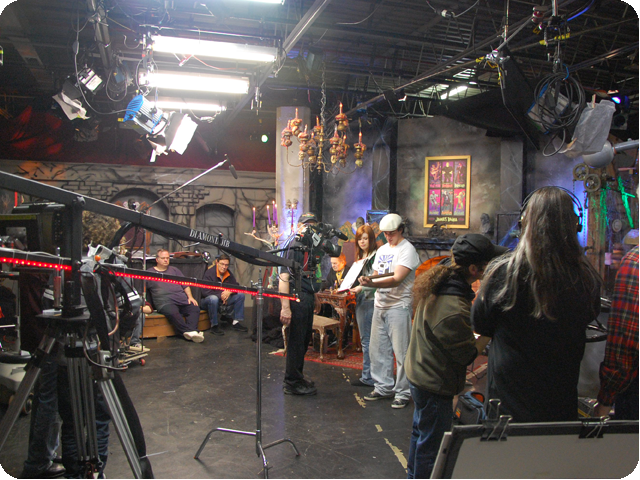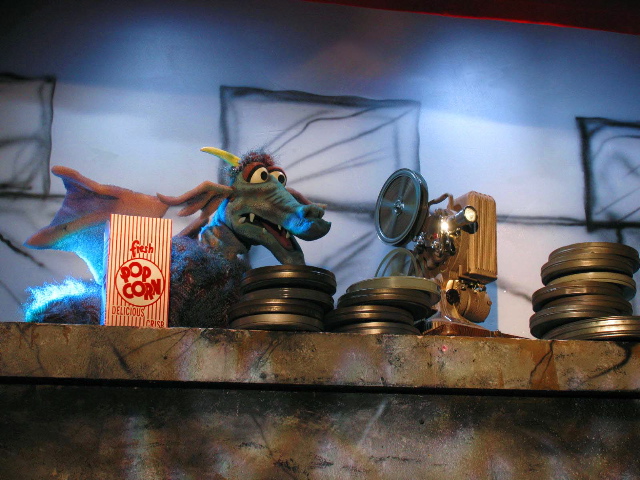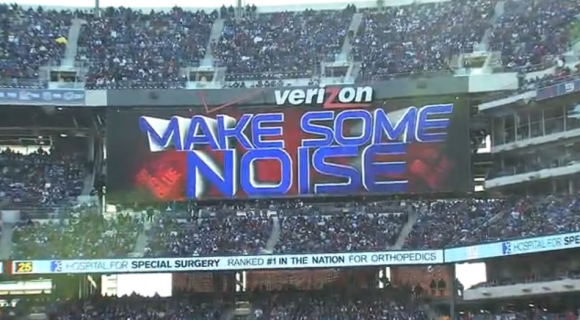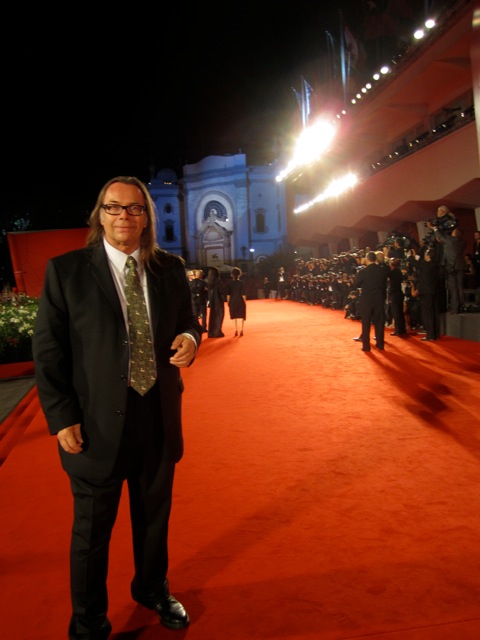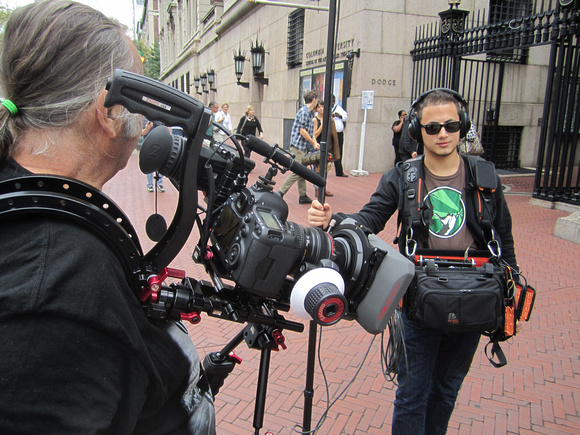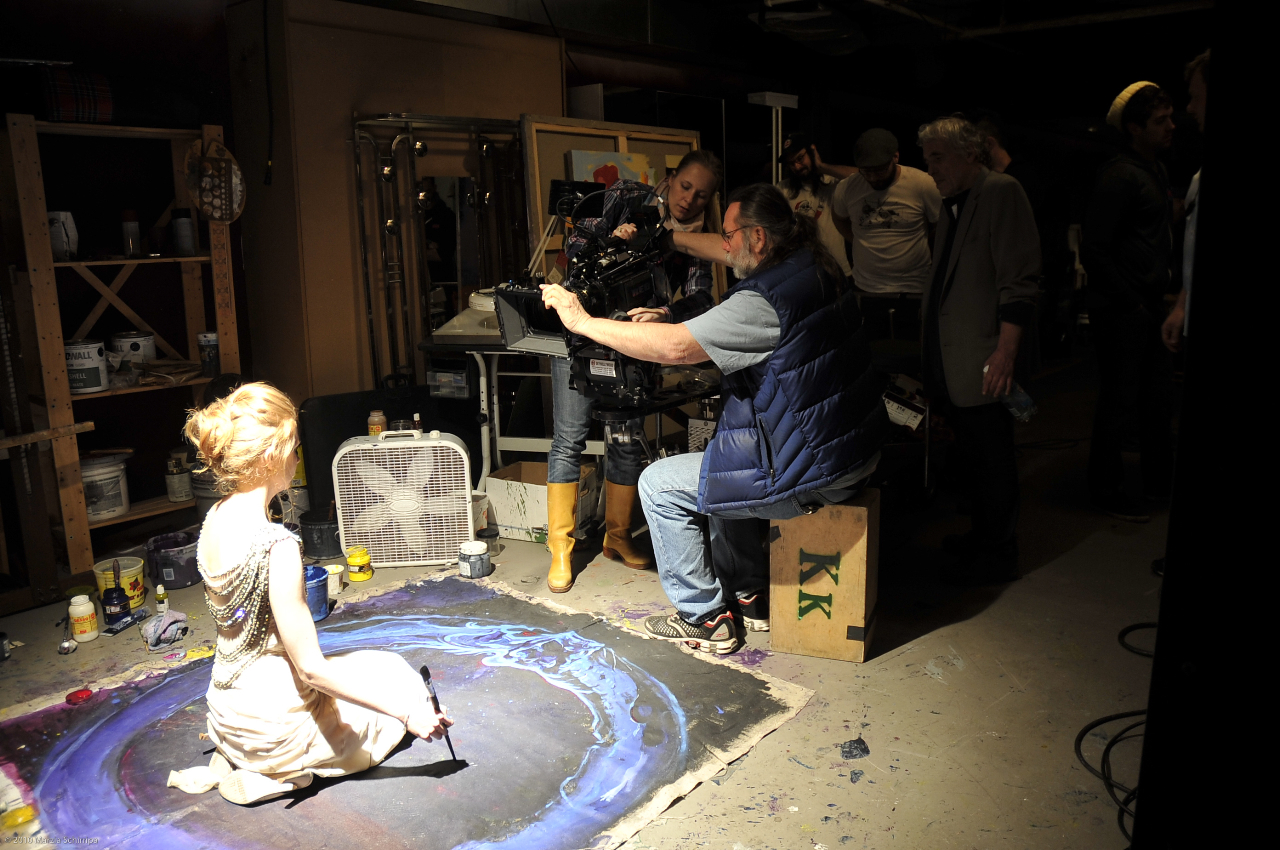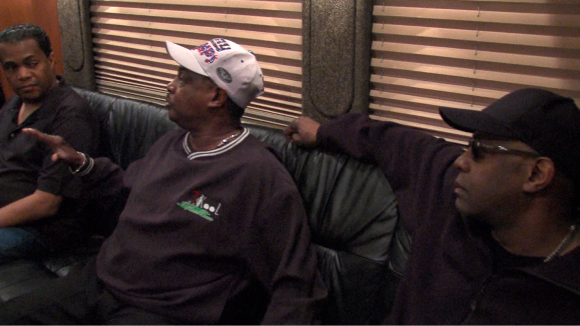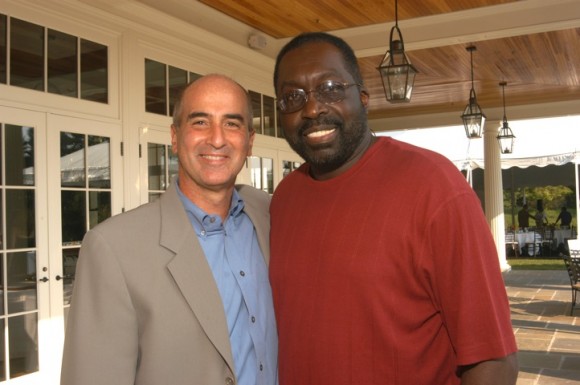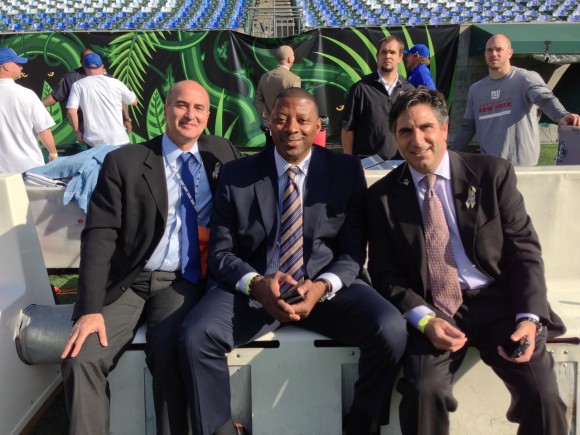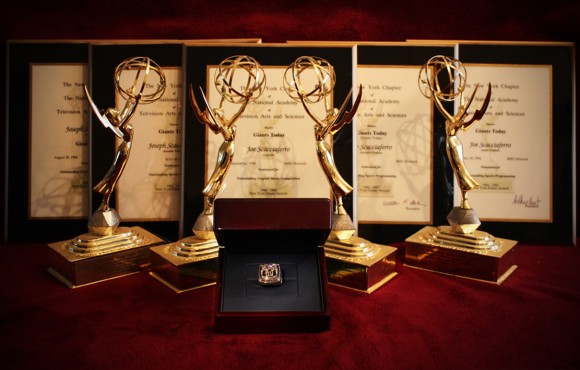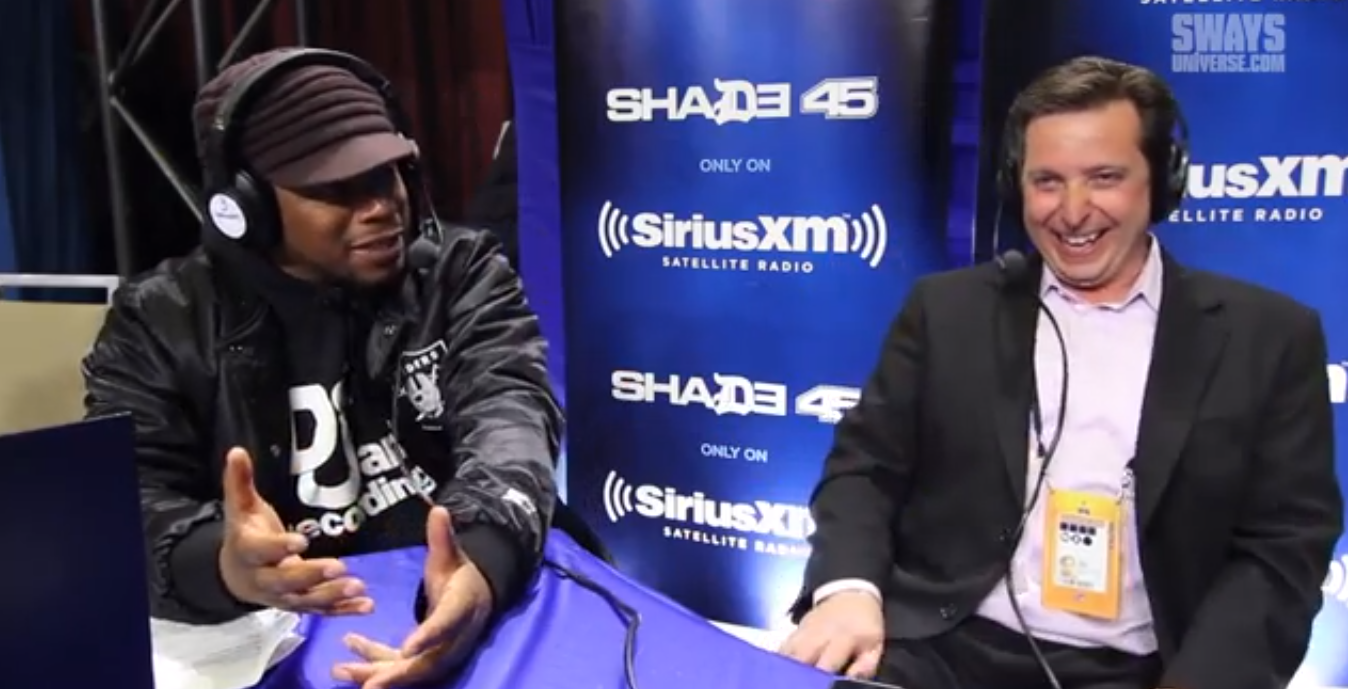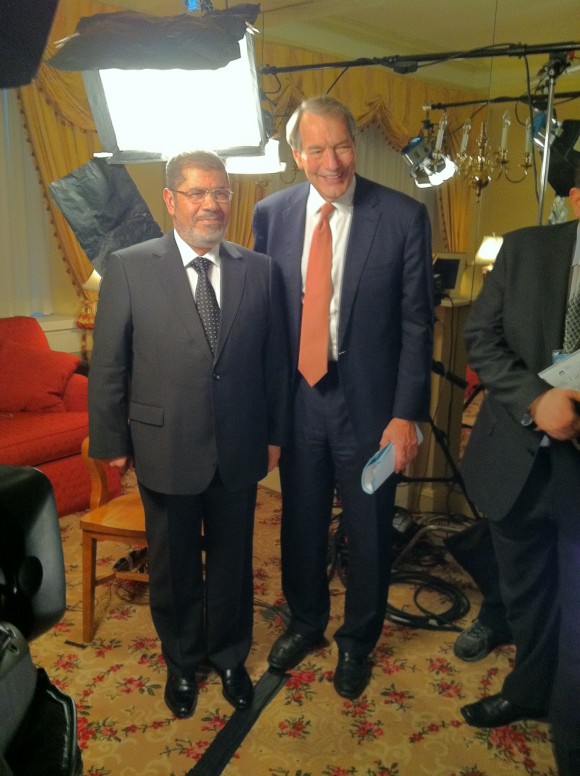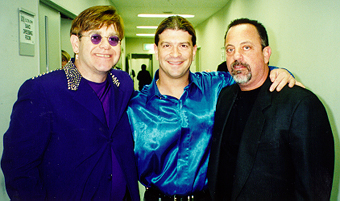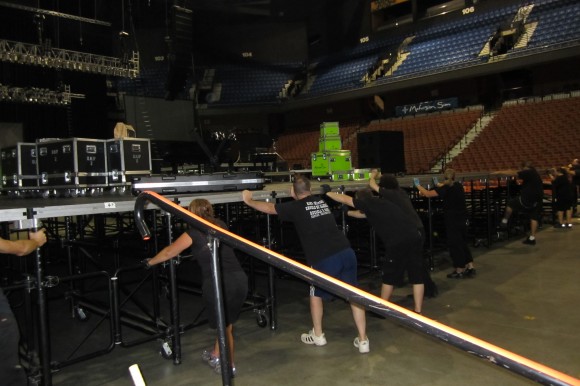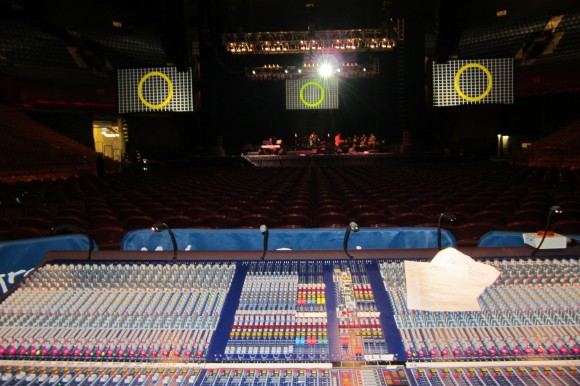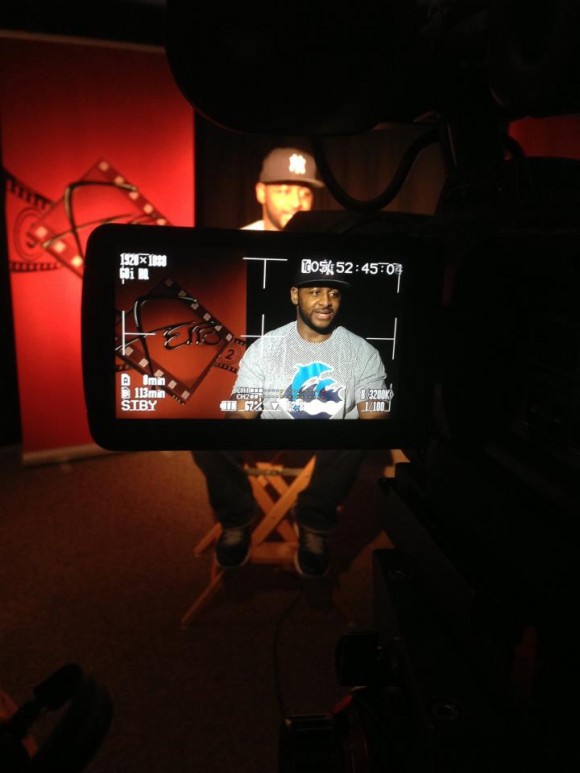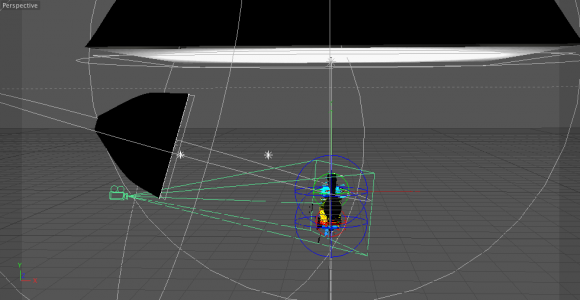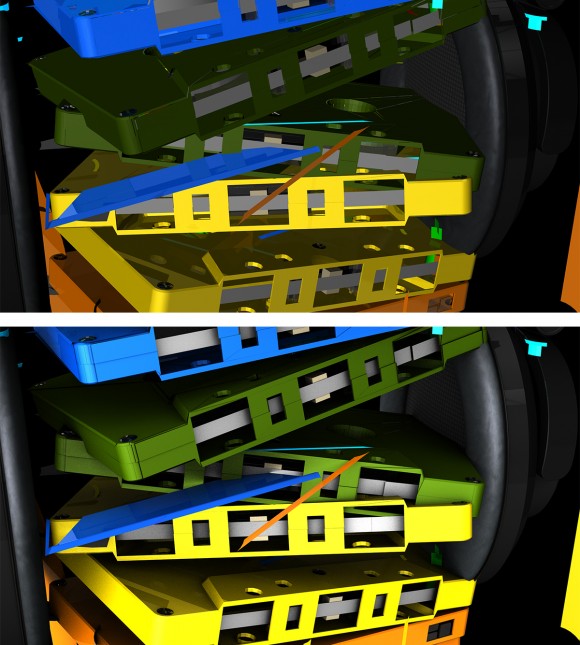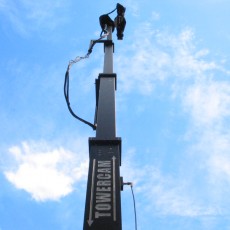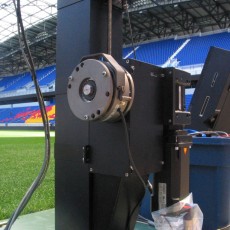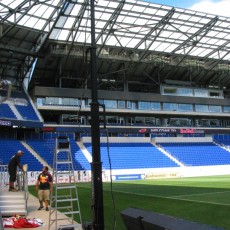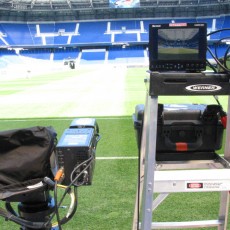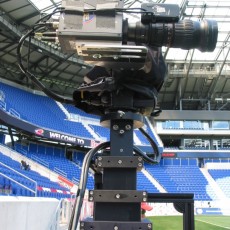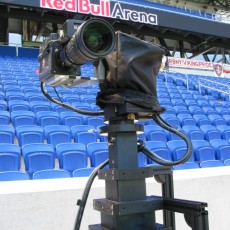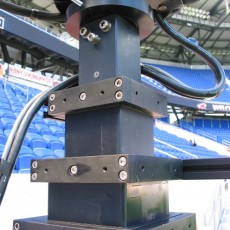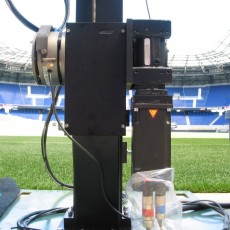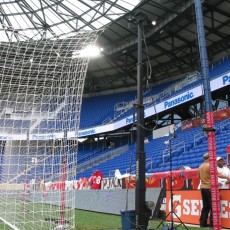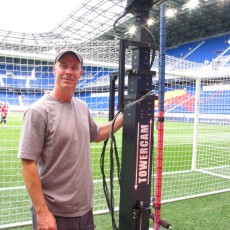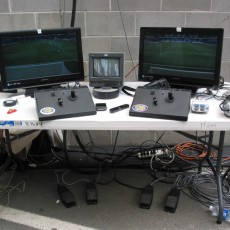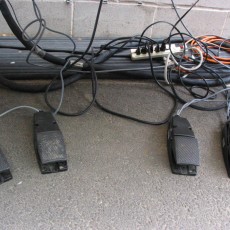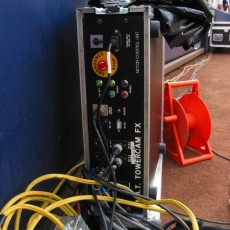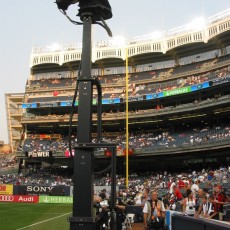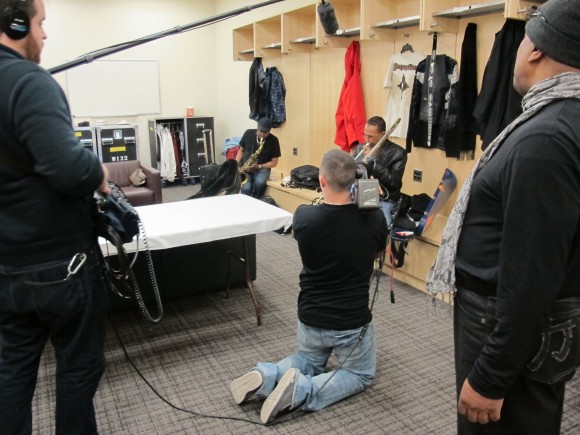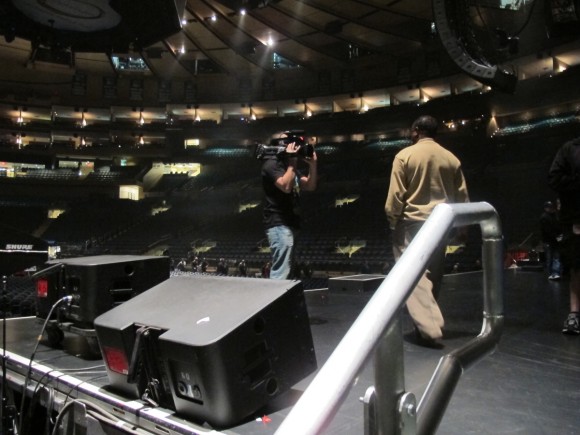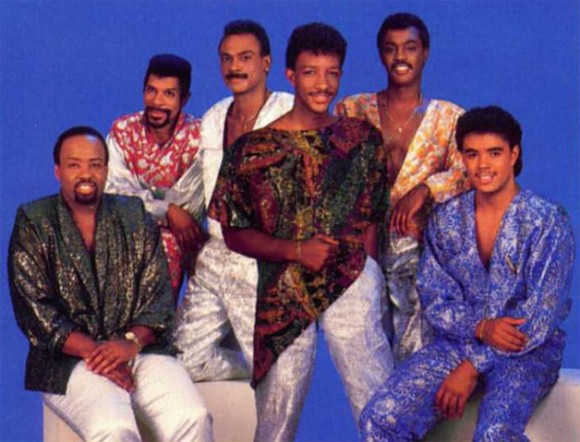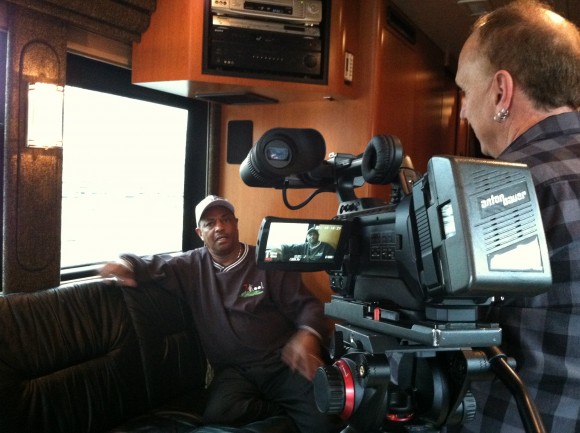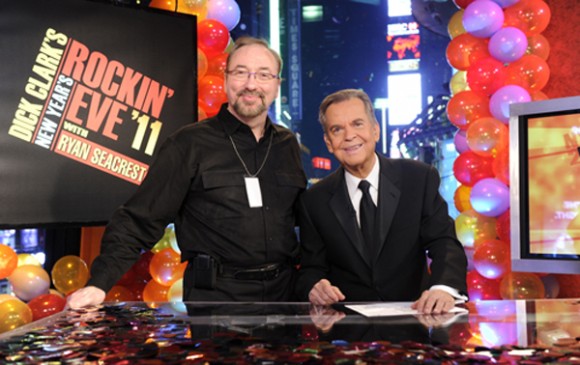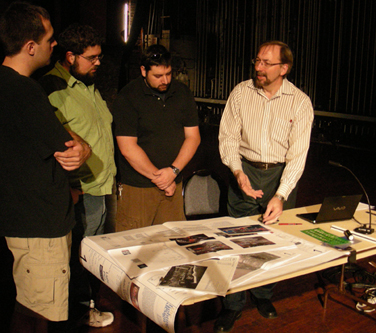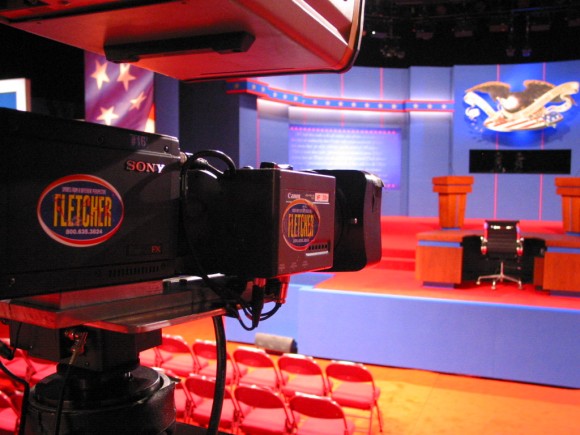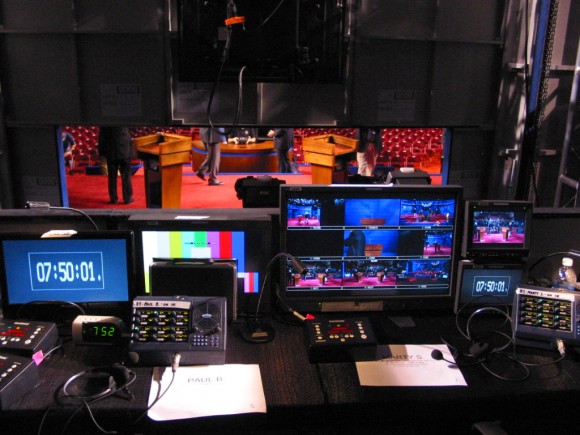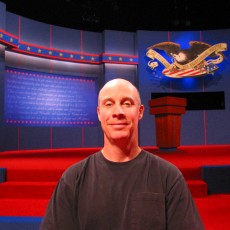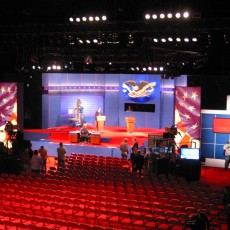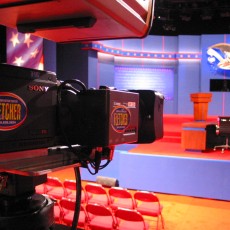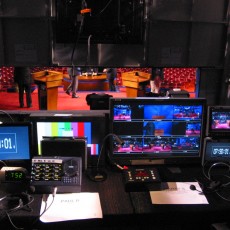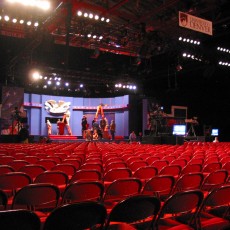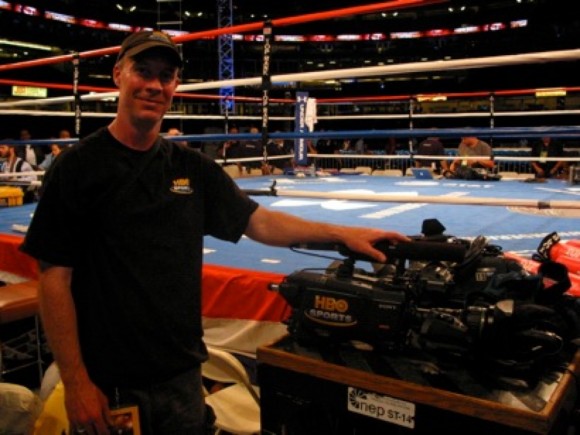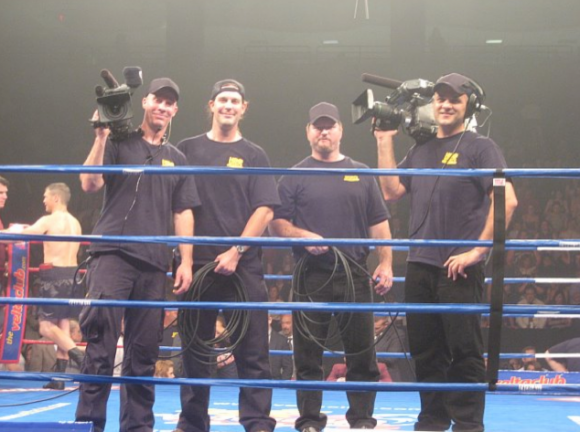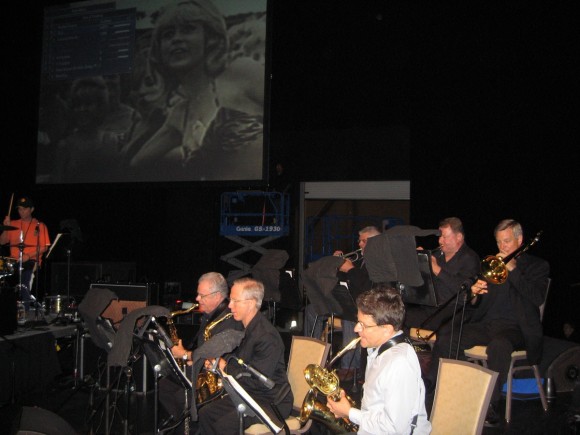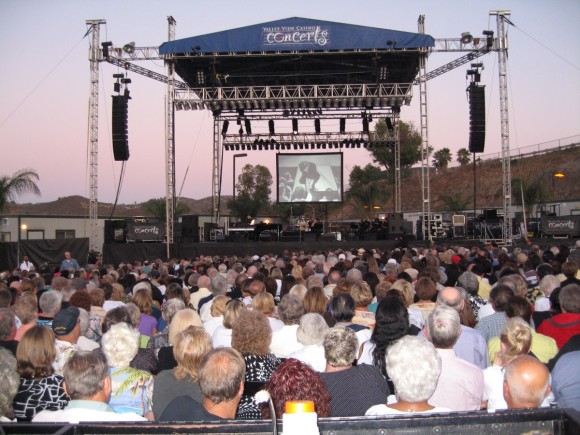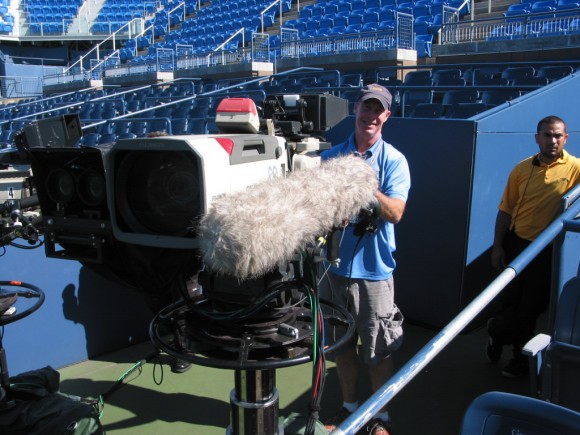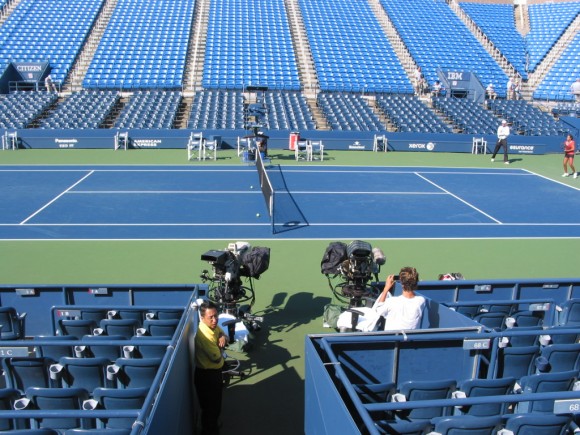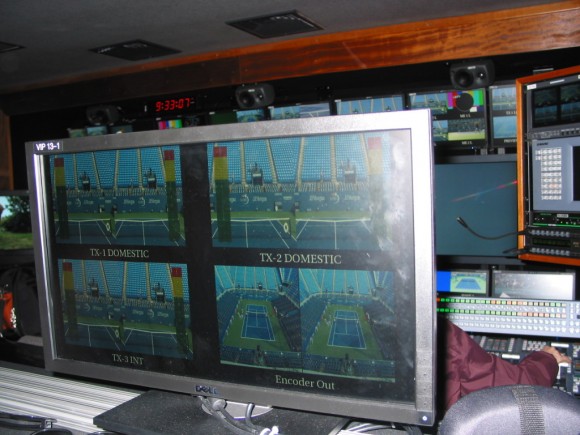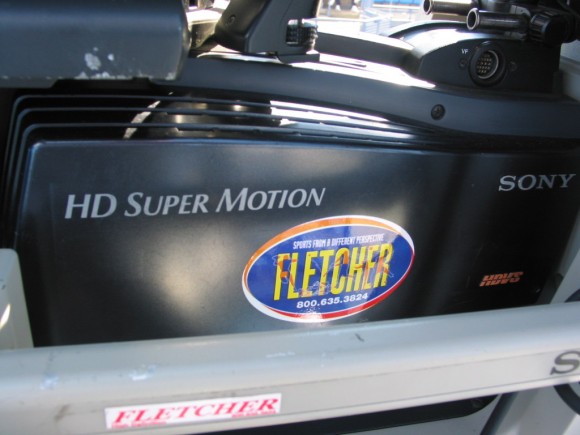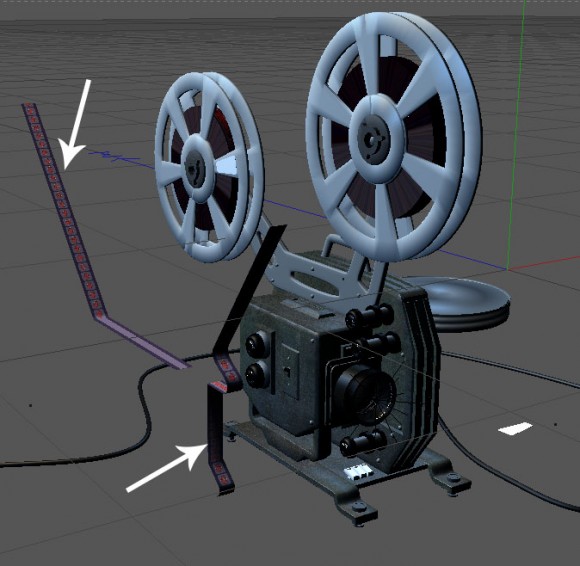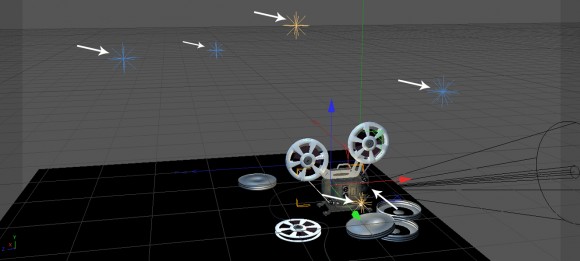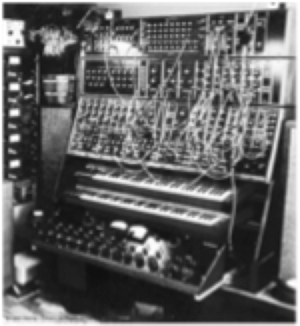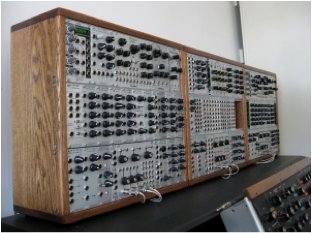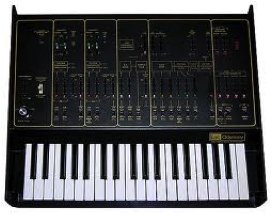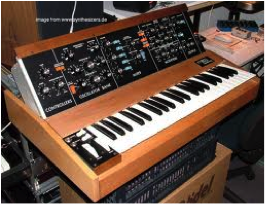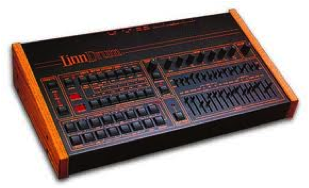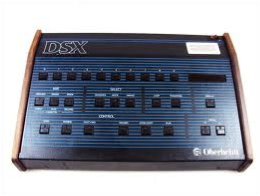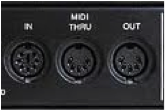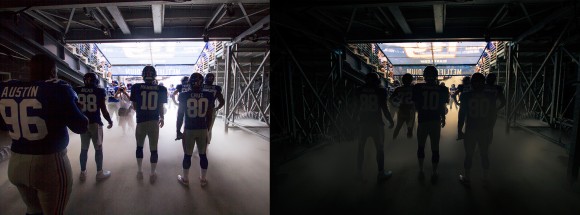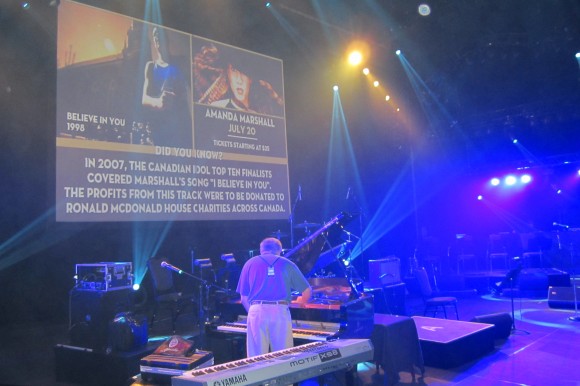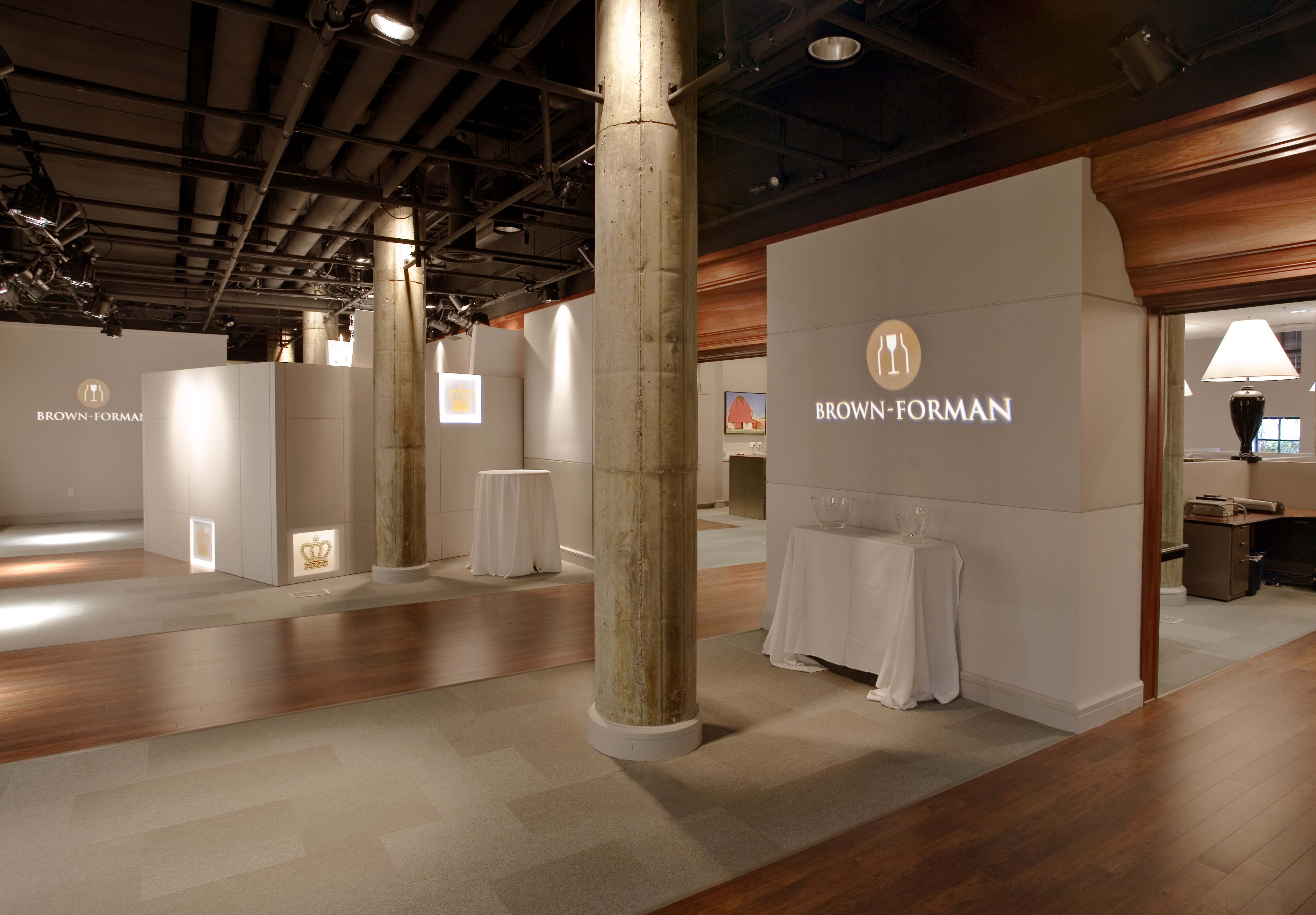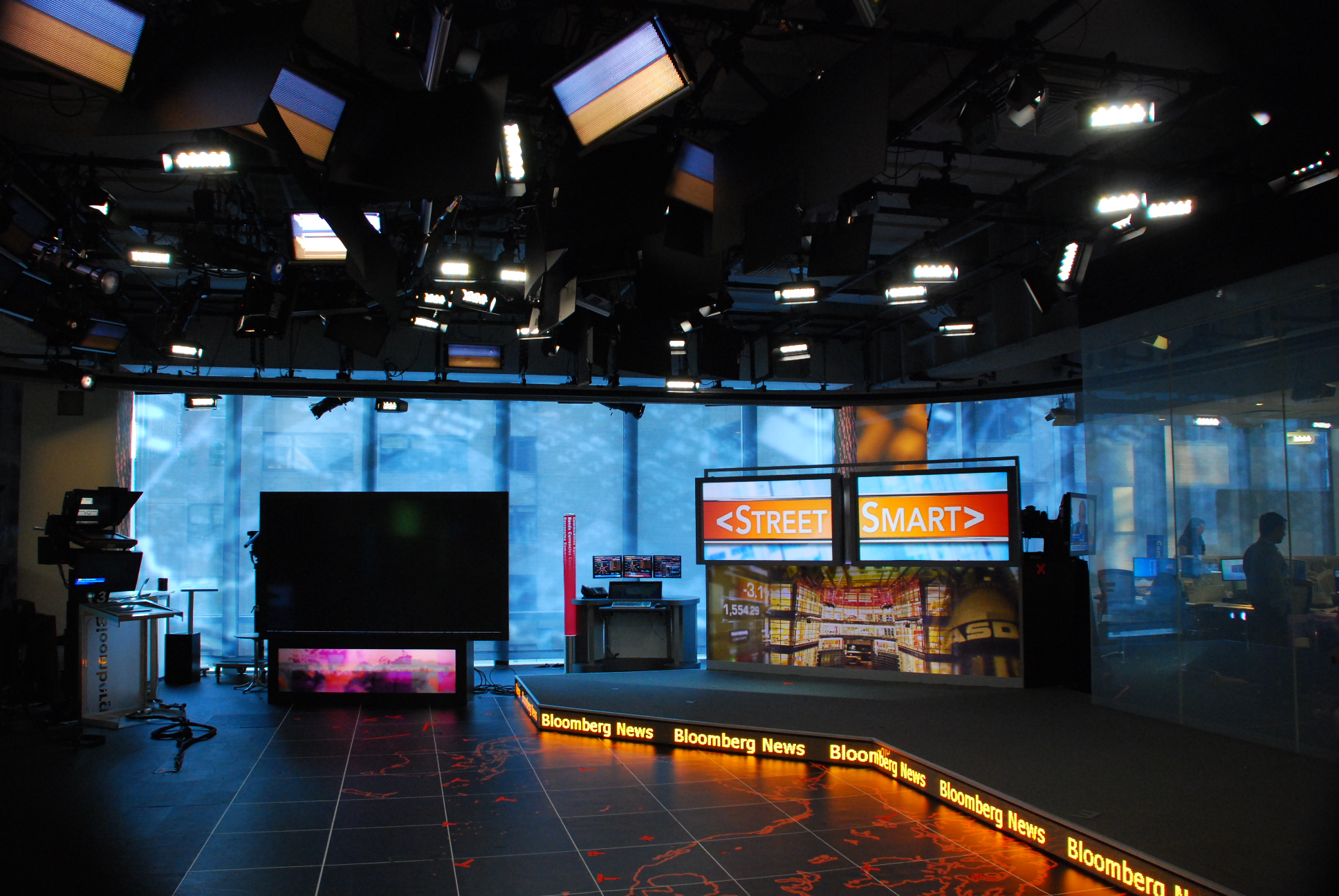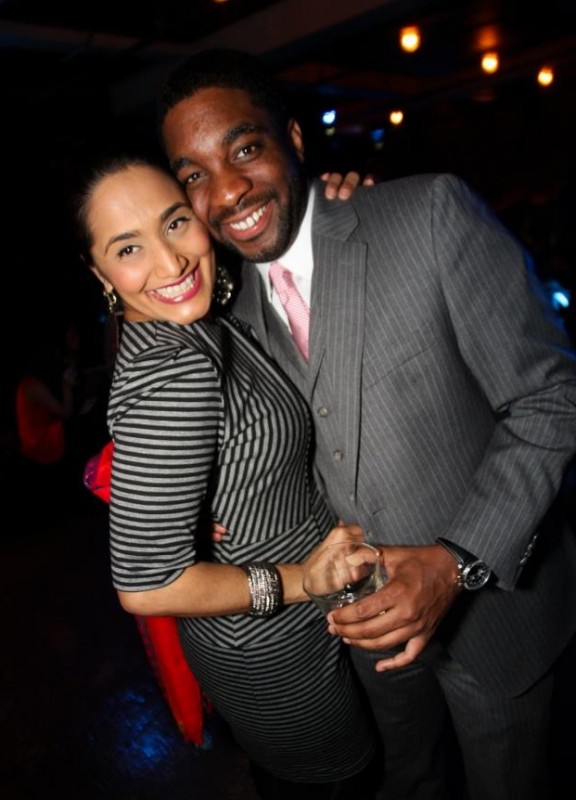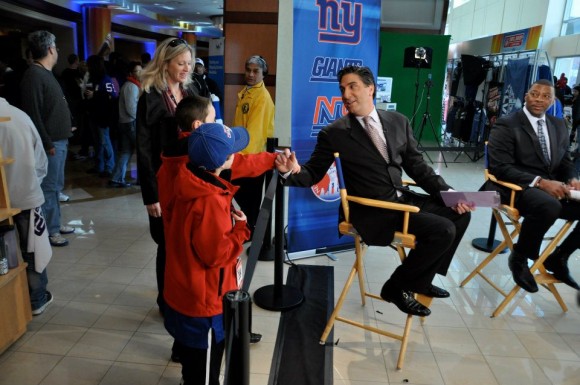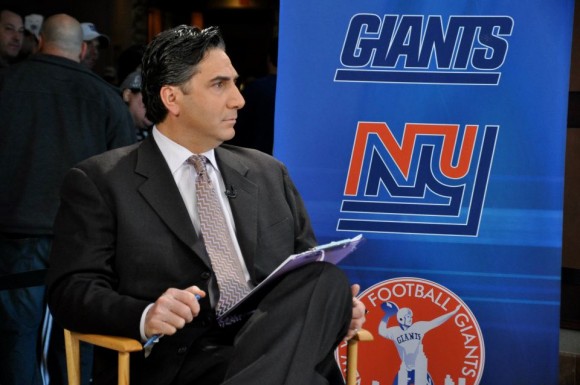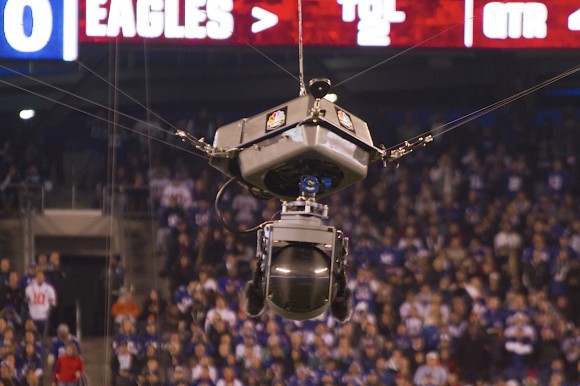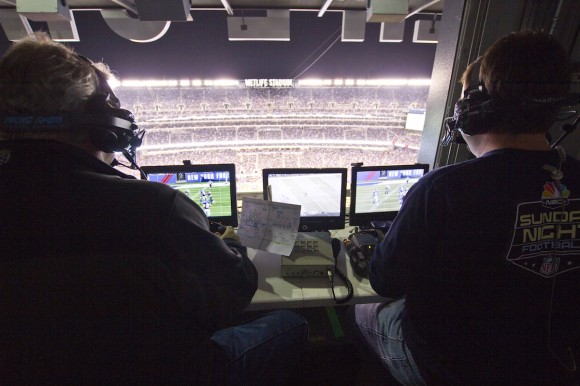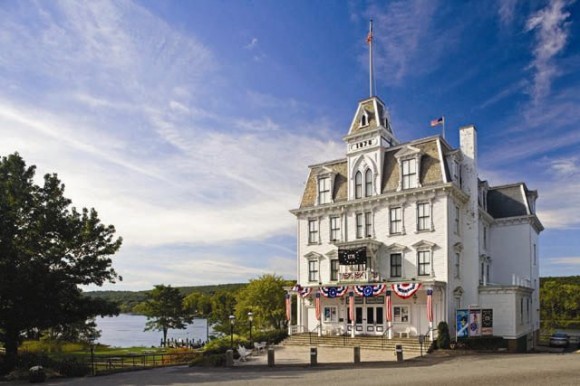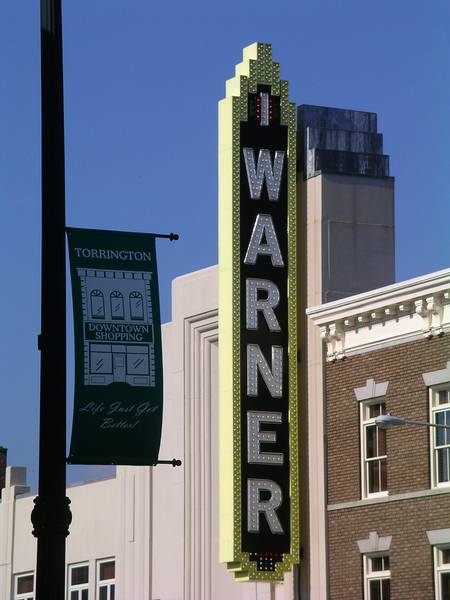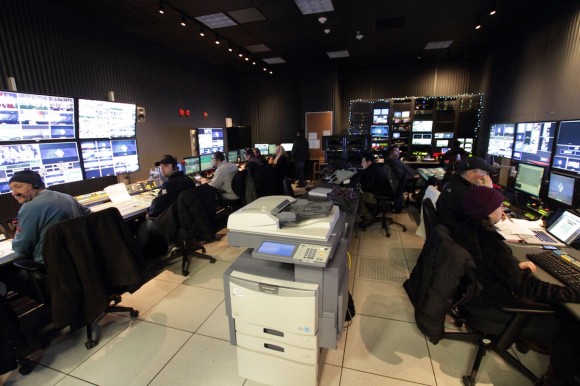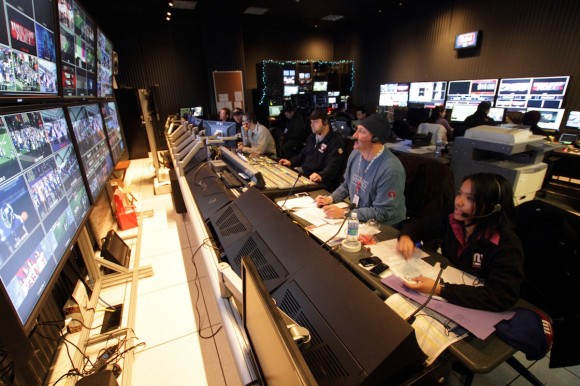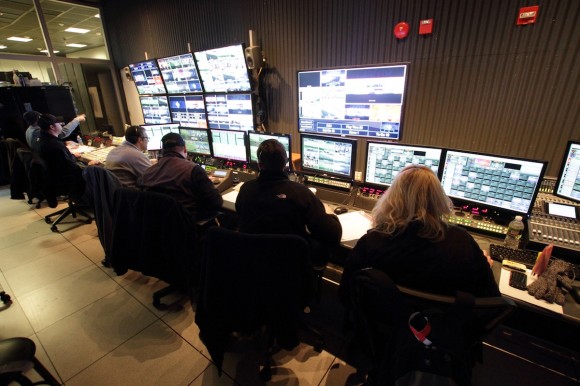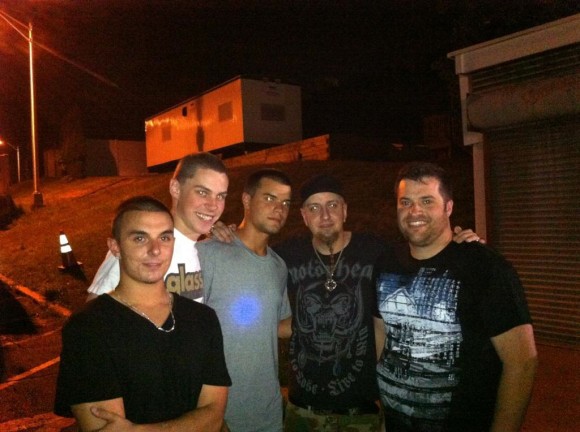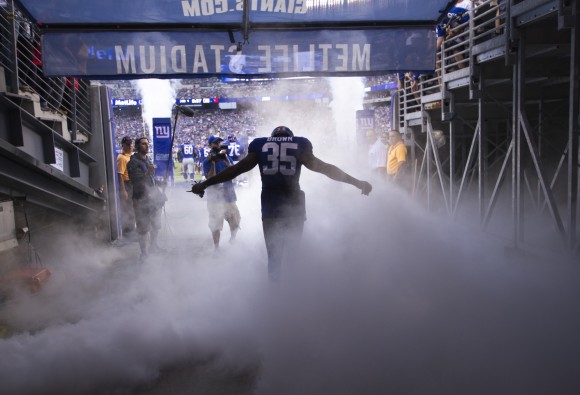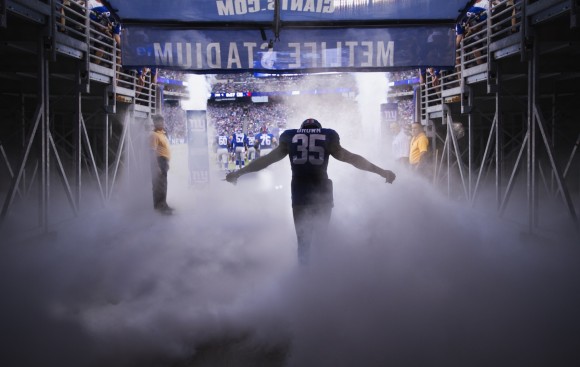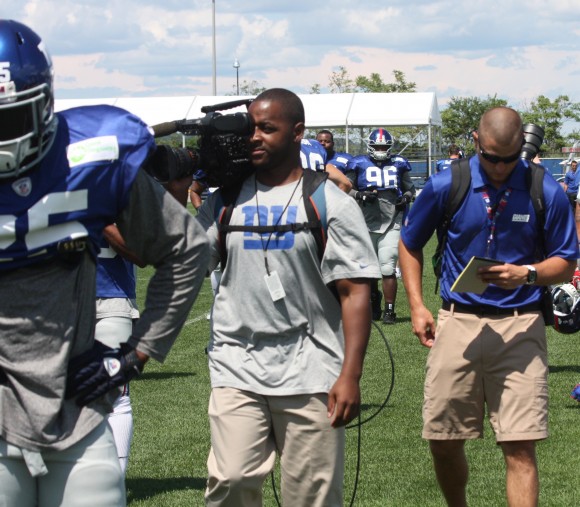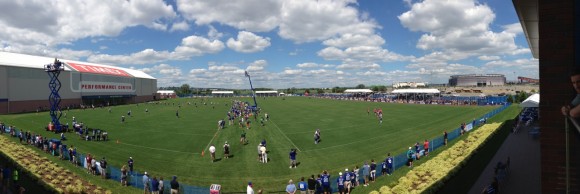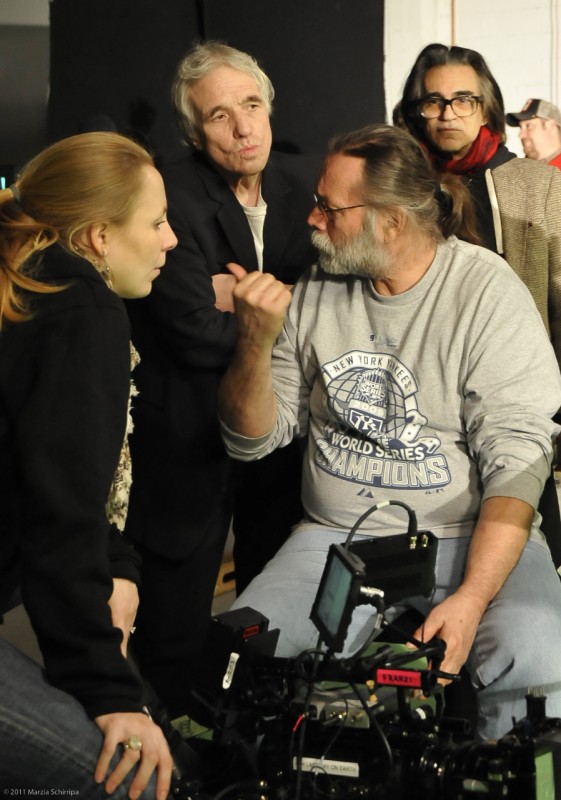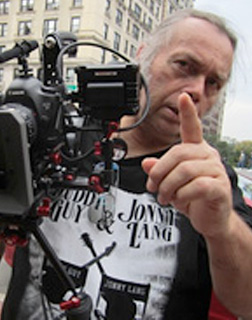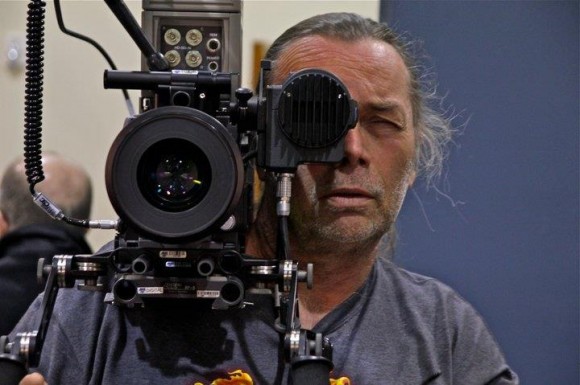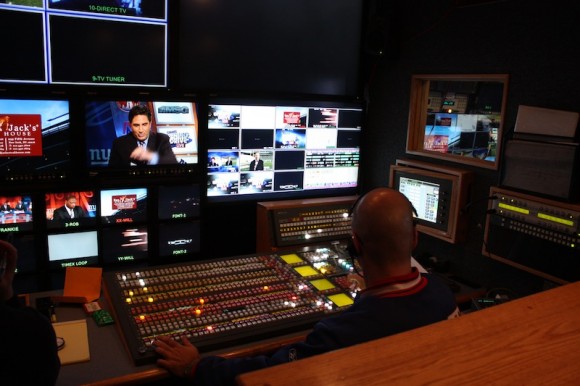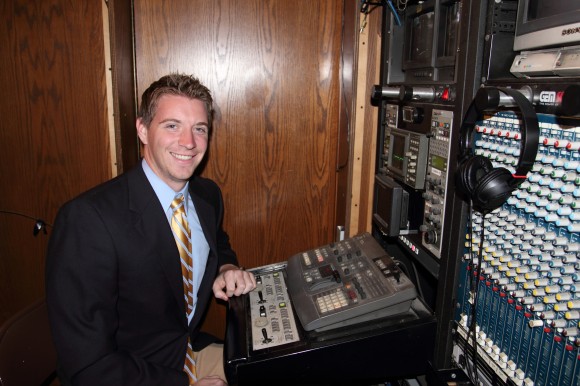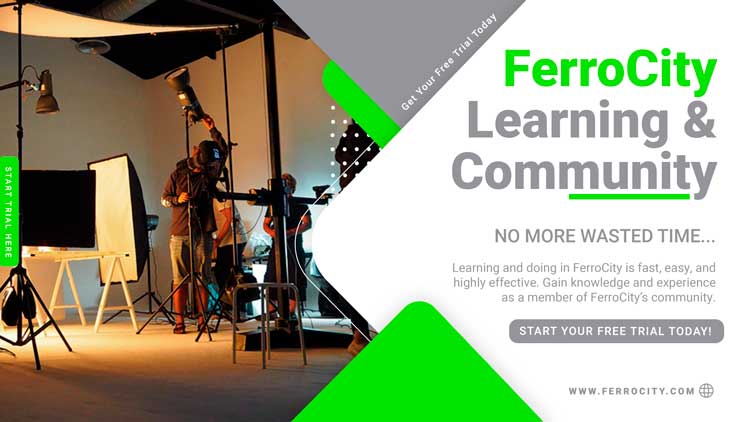Directing Multi-Lingual Television
Every once in a while I get a chance to flex my foreign language skills. Sure it does come in handy when you’re ordering from the menu of a Portuguese or Spanish restaurant, but in this global TV market being multi-lingual is a great plus.
Because of that, I’ve been able to work with many international networks and production companies. Brazil’s Globo, Mexico’s TVAzteca, MTV Tres, a Spanglish MTV network, and Argentine TV are but a few of those clients. I have also worked with Iranian, Pakistani, German, Turkish and Japanese networks, languages I don’t speak a lick.
Knowing the language is important but not imperative. I directed an hour long, rapid fire, Iranian talk show spoken in Farsi. I had no idea what they were saying, and I didn’t need to. Regardless of nationality, expression and inflection is basic to every language. An angry voice is angry regardless of the spoken tongue.
Facial expressions, head shakes, head nods are telling as to who agrees, disagrees, who likes who, who hates who or who has a question and is waiting for the opportunity to ask it. Visual and varying speaking volumes are cues as to where and to whom the conversation is going and being directed towards. I tend to keep an eye on the wide shot, looking for telling, subtle physical and auditory cues.
I was hired by Vision Quest Productions, a full-service provider for television production services, as a satellite coordinator on a global town hall meeting for a major investment industry client. Once a year the client brings together all of their major satellite offices from around the world. Dubai, Johannesburg, Milan, Sao Paulo, London, Chicago, were all set up for two way communication with New York, the meeting’s main origination. All sites were connected via satellite and/or fiber, with uplinks and downlinks at each individual location.
On a small scale, two-way communication can be served well enough with video teleconferencing, but when you’re globetrotting around the globe, a telephone line will not do the job. This job was big, so big that it took Vision Quest nearly 6 months to prepare for. They coordinated the satellite up and down links, location transmission, local crewing and any strategic parts associated with the production.
Each city had an uplink and a downlink for two-way communication between the location and New York City. Phone bridges were set up with individual locations for instant, pier-to-pier communication to dedicated lines for the Director, Producer and Engineer in Charge (EIC).
In addition to assisting in location satellite coordination, my main role in this production was to coordinate satellite services in Portuguese with Sao Paulo, Brazil, troubleshooting and remedying any potential problems that may arise. Milan, Italy was the only other location that had a dedicated person to handle any problems that necessitated an Italian speaking coordinator.
The only obstacle I encountered was the Portuguese nomenclature for broadcast terms. For the most part, basic technical terms are in English and understood by most international broadcasters, but when it comes down to specifics, like horizontal polarity, uplink and down link terms and individual’s titles, it can make you a little tongue-tied. English being such a widespread used language helps in situations like this where mixing English and Portuguese terms to get the message across sometimes is the only way to do it.
So after a seamless production and two days of flexing my language muscles, I once again put my multilingual skills into hibernation, and await the next call when I can blow off the dust and flex them once again.
How to “Never Grow Up” and Still Succeed
Have you ever had the thought, “Maybe I haven’t grown up yet?” For some, such a thought can be worrisome. However, it can be an acceptable characteristic in the minds of others: especially in the world of production.
Just ask Bill Diamond, the founder of Bill Diamond Productions, which is a creative production company where “anything you can dream or want to do for film, television, stage, or live events can be created in any type of medium possible.” And you can explore Bill’s world by clicking here.
Even the way Mr. Diamond describes his own company is happy-go-lucky and errs on the side of youthful mentality. So once again, how can the “kid” in us still remain lively as we pursue a successful career?
When Mr. Diamond was asked how it all started, he replied, “Well, the first thing was that I never grew up, and I didn’t know what I wanted to be when I grew up because I had so many interests.” He believes that his success and happiness is rooted in his myriad passions. From puppetry, to drawing, to television, to film, to acting, to photography, to lighting, to makeup, to special effects, Mr. Diamond planned to use his skills to undertake any assignment at any given moment.
“I always wanted to create my own place so I could do something different all the time,” said Mr. Diamond. “One day I could be a makeup artist, the next day I could write a script, the next day I could direct a film, and then put all of those elements together and bring talented people to the table to create almost anything.”
But more importantly, Mr. Diamond rationalized that being familiar with so many different tasks was advantageous for becoming a cultivated director/producer/creator. Learning all of the jobs beneath the more managerial and commanding positions would give Mr. Diamond the ability to properly direct each person in their respective job function. Sure, they could be better at doing the job than Mr. Diamond, but he needed a clear understanding of what they needed to do.
“I feel that if there are directors out there and they’re not well-rounded and they don’t understand the people working for them, i.e. the director of photography, audio, lighting, and costume personnel, etc., and don’t understand how all of that works, then how can they direct them competently?” Bill questioned.
But wait. You’re telling me that Mr. Diamond isn’t ‘grown up’ even with these enlightening perspectives? Yes, somewhat.
Bill’s ability to understand the niceties of running a successful creative business doesn’t mean his youthful imagination isn’t his driving force. Just ask Gorgo, a 300-year-old gargoyle; one of Bill’s inspired puppet-characters that is manipulated and voiced by Bill.
“I’ve been in the business for a long time,” said Gorgo. “You may think Bill is in charge, but he really isn’t. We just put his name on the front door to make him happy so he would clean the hallway or something.”
Gorgo is one of the monsters from Bill Diamond Productions’ Monster TV Network, which is an ongoing web show. The puppet monster characters run the entire program, with Boras Frankenstein (another monster character) as the head of the network. Bill created the Monster TV Network out of his “love for monsters” and because he wanted to create an avenue for young people to have a fun way of becoming familiar with actors, makeup artists, effects specialists, and other talented individuals making a living in the entertainment industry. Each monster has their own show or segment, there’s a monster news show, and various interviews are conducted with the monsters to give the viewers a comprehensive overview of what’s going on in the monster world. It takes a lot of work to keep everyone informed about the Monster World. So how is it all managed?
As for the monsters, Gorgo explains, “Well, you just tell everybody they won’t get dinner. With the monsters, you either electrify them or say ‘Do you wanna go out for Halloween?’ or ‘You wanna see a movie later?’ It really kind of works well.”
For the artists and production staff, there’s a process of bringing an idea to fruition and maintaining its delivery. That’s where Mr. Diamond and his team let their imaginations come to life while applying their skills, most notably with the Monster TV Network.
If there’s a certain project that Bill Diamond Productions wants to undertake, Bill begins with some thumbnail drawings of what he wants to see (that’s where his love of drawing comes in). “A lot of times it starts with a character,” said Mr. Diamond. “From there we kind of work out the theme, what the world would be, how it would work, and what medium we want to see it in.”
Once the idea is mapped out with the drawings and a setting is decided on, the process gets more hands-on. Bill and his team begin creating miniatures to see what the environment will look like. In the case of Monster TV Network, the environment was made up of castles. The production team essentially works on constructing a whole new world.
“How is it lit? How is it visually told? How fun could it be? We start assembling what we want to build,” said Bill. The environment could be comprised of a variety of layouts: miniature models, a stage setting, a full-sized set, a digital world being used on a green screen, etc. Like Bill had originally said, “Anything you can dream of.”
When the artists and designers finalize the creation of the characters and the setting, it’s now time to tell the story. Character development takes place, along with the script writing and the overall structure of the story. After that is completed and all of the elements can be put together, the filming begins and the project is eventually taken into post-production where it is perfected and ready for delivery.
Ah, delivery. So now after all this work everyone can finally rest; everyone except for Bill. He believes that just because you have one job doesn’t mean you’re limited to the one task you’ve finished.
“A lot of times this is what the schools don’t teach us,” he expressed. “Do it all. Experiment with all of it. Keep reinventing yourself. Realize that anything is possible.” Mr. Diamond has had such dissenting views with school ever since his early years. At the age of 15 he auditioned for a part in the school play and was told he “couldn’t do it,” which elicited an alarming response from Mr. Diamond. “Don’t ever tell me I can’t do something,” he said. So at age 15, he went ahead and started his own production company and never looked back.
3D Animation: Make Some Noise!
PROJECT: “MAKE SOME NOISE” Giants stadium scoreboard prompt used during Giants home games at MetLife Stadium on the 4 large video boards.
One of Ferro’s contractual responsibilities during the NFL season is to support the Giants “in– game show”. This includes videos and graphics played during time outs throughout the game. Some of those graphics include stadium prompts. These are used to motivate or direct the crowd to an action. This particularprompt was to have the crowd cheer or “Make Some Noise”. The prompt was to be based on the older version prompt, which was a simulation of a group of audiometers increasing with the level of the crowd noise. A few other design considerations were the project’s color scheme, which had to incorporate the blue and red of the Giants’ team colors and the enormous size of the stadium’s boards.

To ensure his design would scale the an enormous stadium screens of 28 ft. X 113ft. and accommodate the unique video formatting framing of those boards, Swen built a custom playback template in Cinema. Swen said his biggest concern was working at such a huge scale, “When your working with a monitor that is 23 inches X 14 inches you have to constantly remember that a 2” text character on your desktop monitor will be 2 ft on the stadium boards. That’s an insane ratio to be working in.
“When I think of audio meters I always think of the meters on an audio sound board /mixing board (see BEHIND THE WIZARDS CURTAIN Note: 1)
Like the ones found in music recording studios or at concerts.” States Ferro senior graphic designer and animator, Matt “Swen” Swensen. Swen started the project by researching different mixing consoles. He was looking for ones that had the “coolest style and looked realistic”. Swen ended up on the Turbo Squid site. There he found a model that he thought would work. While working on the design one of Ferro’s audio engineers saw his project file and mentioned that the model he chose was not a realistic console used in a stadium audio suite. Swen sarcastically asked himself, “Is it of value to have a diverse group of experts around all the time or is it a curse, because I’m sure the client would have never noticed?” In the world of Ferro Production, “Right is always right even if no one will ever notice.”

Swen finally landed on realistic console that had the perfect look and coincidentally the same color scheme as the Giants. Fortunately, the image was also a high-resolution large-scale overhead view, perfect for modeling.
CONCEPT:
Swen’s concept for the animation would have the faders on the console moving up while the bar graph VU meters would increase thereby simulating the crowd “getting loud”. To achieve an exciting animation he would simulate several different camera angles of the console and moving faders revealing the text “GET LOUD”.
“My first attempt at molding and animating the faders was a bust”, Swen admits. “What I attempted to do was bring in the entire flat image into Cinema and then animate new faders over the ones from the original image. After my first test I realized that when the faders animated / moved from their original position, it relieved the static faders from the original image. “ The genius of a genius is knowing there are several ways to achieve your goal.
Swen continues, “This was a trap I unintentionally set for myself. Usually, rushing through a project causes you to jump passed steps in your normal workflow, which always means more rework in the end.” That was exactly the case with this attempt. After abandoning his initial approach and rethinking his attack plan, he nailed it.
RESTART
STEP ONE: Prepare console for animated faders
Knowing that in the final animation he wanted the channel faders (see BEHIND THE WIZARDS CURTAIN Note: 2) to be moving, Swen had to find a way to animate the faders over the still image of the console. Swen recalls, “In order to move the faders the first thing I needed to do was separate them from the still model”. To achieve this he imported the 2D console image into Photoshop and removed each fader. This left him with a flat image of the console with no channel faders.
STEP TWO: Flat image to 3D model
He then imported the new faderless console image into Cinema (this is the program used for 3D modeling) and transformed the 2D console into a 3D model. (For details on this process please refer to Swen design blog) http://www.ferroproductions.com/reel-ferro-open-breakdown/
STEP THREE: Adding animated faders
“ Animating the faders without running into the same problem I approached things a little differently” Swen states. To replicate the faders he first had to make new faders. To do this he selected one fader from the original image, the one furthest to the left, and then applied the MoGraph > Cloner (see BEHIND THE WIZARDS CURTAIN Note: 3) to that fader. He tweaked the setting to CLONE (see BEHIND THE WIZARDS CURTAIN Note: 4) this one fader 11 times along the X– axis (see BEHIND THE WIZARDS CURTAIN Note: 5). In doing this he knew he could now control the positioning of each fader in relation to the console’s front panel and each adjacent fader. This would give him a perfect replication of the original image and still allow fader movement. He now had a perfect 3D model of the console with faders that he could determine their movement.
STEP FOUR: Camera angles and edits
“From the beginning I knew they wanted a highly stylized final piece.” Swen reveals. I knew I’d need several simulated camera angles timed with the movement of the console and meters.” He set camera one positioned at the back of the console angled to reveal faders moving towards camera. The second camera set on the same plan as the faders looking up to the VU meters.
STEP FIVE: Animating the faders
There are several key stages of animating the faders. The first was to place all faders to zero on the console channel image. Next he grouped (see BEHIND THE WIZARDS CURTAIN Note: 6) all the faders together. Swen shared a key design trick, “Since I had created the faders as a separate objects I was able to apply something called a RANDOM EFFECTOR (see BEHIND THE WIZARDS CURTAIN Note: 7), to all the faders on the Y– axis (see BEHIND THE WIZARDS CURTAIN Note: 8). This allowed me to simulate the faders moving up and down without having to adjust each fader with dozens of Key Frames.” (see BEHIND THE WIZARDS CURTAIN Note: 9) This approach not only made the process easier to produce, it saved hours of tedious time, placing and adjusting each fader’s key frames to simulate movement.
STEP SIX: Faders timing
Using the Random Effector, he set a single fader’s key frame at the zero position on the console’s image. Then he set the next key frame at the final “full up” console position. Between those to set points he allowed the Random Effect to establish the fader’s position and movement between those points. These settings were applied across 11 fader channels. The Randomizer will select and set key frames based on the SEED. (see BEHIND THE WIZARDS CURTAIN Note: 10) (The algorithm that decides the randomization of the key frames)
STEP SEVEN: Building and Animating Audio Bar Graph
The Bar Graphs and Bar Graph animation were all done in After Effects (see BEHIND THE WIZARDS CURTAIN Note: 11). Making it sound as routine as breathing, Swen explains, “I start with one rounded rectangle. Then filled the image with the color blue and multiplied that image 12 times in a vertical stack. From there I duplicate that stack 5 times horizontally and equally space each stack. Done!” Each blue bar of each stack can be turned on, off or partially on giving the effect of volume getting louder. The client and their knowledge of how the crowd reacts to board prompts determined the timing of the graph’s simulation.
STEP EIGHT: Camera Animation and final edit
“The cornerstone of every awesome animation is the placement of cameras and the moves applied to those cameras”, explains Swen. For this project Swen chose to use two cameras. Camera 1 was positioned at the edge of the console just below the faders. Camera 2 was an overhead close– up of a selected group of faders. Camera 1 movement went from its start position on the edge of the console, then pulls out wide revealing the entire board and the moving faders, pauses for a second and then pushes forward over the faders across the console up to a text graphic saying, “MAKE SOME NOISE”. “ From here I just quickly alternated between widening out to reveal the console with meters jumping and then pushing back to the text graphic. I used camera 2’s close up of the faders as a split screen simulation. I also threw in some spinning speakers to jazz up the pull-outs.” Swen explained.
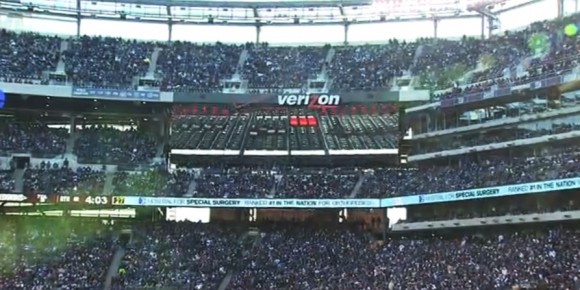
Mixer final product
BEHIND THE WIZARD’S CURTAIN:
NOTE 1: The unit that all audio signals plug into and are “mixed” together for a balanced blend of a single sound source.
NOTE 2: A device found on all sound mixers used to control the audio level from one sound source. i.e. volume control.
NOTE 3: Mograp
NOTE 4: When applied to a Cinema image this feature will reproduce the selected image exactly with all parameters and specs included in the reproduction. The user can select how many clones will be reproduced.
NOTE 5: The location of a 3D modeled image are referred to by 3 axis X,Y,Z. X is used to locate horizontal position. Y is used to identify the Vertical position and Z locates depth.
NOTE 6: In a multi-imaged graphic design this technique allows the artist to combine several individual graphic elements to become one element. This is very helpful in moving or effecting several elements with one move.
NOTE 7: Adding this effect to a MoGraph allows the computer to determine a random pattern of motion for the selected object. The designer must preset the path the object will travel.
NOTE 8: See note 5.
NOTE 9: These are points placed on any time line to denote an action will take place at that point. The action will be determined by the designer.
NOTE 10: This function is referred to by numbers. The numbers select an algorithm that sets a predefined “random” movement.
NOTE 11: A 2D animation program.
The Life and Strife of a Cinematographer
If you were to look up the word ‘cinematography’ in the dictionary, the definition would read, “the art of making motion pictures.” That is the essence of the word, but it doesn’t elaborate on any of the subtleties or responsibilities of the art. Don’t worry, Ferro is here to provide insight. And who better than Ken Kelsch, an award-winning cinematographer, to go beyond the textbook meaning for us.
Ken Kelsch has over 40 years of experience in the film and television industries. He has worked as a cinematographer on 49 film projects, including 31 feature length films. His most notable works include films Bad Lieutenant and Desert Flower as well as the NBC T.V. series Medium. Mr. Kelsch perhaps has one of the more improbable rises to success. It began when he was just a child, growing up in a family that was barely making ends meet. He then went off for a tour in Vietnam to serve as a Green Beret, only to come home and work full-time at Permacel (an industrial adhesive tape manufacturing company) in order to fund his graduate program at New York University’s film school (which he was attending while working). This long journey finally ended when Ken achieved the distinguished title of cinematographer. So when Mr. Kelsch is willing to share some insights on what it takes to become a dedicated cinematographer we make sure we are all ears … and eyes.
The cinematographer’s journey begins with a still picture; the physical location of the filming. It’s merely a picture without the touch of a cinematographer. The cinematographer’s job is to bring that picture or setting to life somehow. “You will never be drawn into a narrative,” said Mr. Kelsch. “The soul and art of cinematography is to help draw the person into the narrative and create a world of fantasy.” It’s important for the cinematographer to instill his/her “film eye” while capturing the shots and footage to provide ingenuity.
When Ken was in graduate school he watched ten feature films each week. When you’re more accustomed to viewing shots and pictures in a film, you’ll eventually understand how to achieve the liveliness and authenticity of your shot as a cinematographer. But watching film is only one of the many practices that help an individual master their craft. Ken recalls one of the most memorable moments of his life when he was in graduate school at NYU. John Cassavetes came to speak to his class and simply told them, “Grab a camera, go out there, and shoot. That’s how you learn. You learn by your mistakes.” Those words of encouragement arguably got the ball rolling for Ken’s career. From that point forward, Ken was doing whatever he could to bolster his resume.
“Hop on any shoot so you can learn empirically,” Ken expressed. “You have to get on each instrument in order to learn how to operate it. Cinematography is a multi-faceted field.”
After he finished up graduate school, Ken began working for as many DPs (directors of photography) as possible, on dozens of varied shoots and sets. He immersed himself in cinematography-related work. He grabbed every and any job that came his way. The only restriction he placed on himself was to never take a job too far beyond his skills; something he considered reckless because it could jeopardize the project or set. Many may think this is the behavior of a perfectionist, but many are also unfamiliar with the environment of a film or television set. The live-action atmosphere is very stressful, and shoots are typically at least 12-hour days depending on the project. There’s very little room for error and the nature of the business demands extreme precision and diligence. The more lasting impressions one can make, the more jobs will be thrown his/her way. And that’s what Ken strived to do.
“Whenever I would get a paycheck I would go buy something,” Ken said. “I never made a profit off of a film because I would always go and buy gear with my money.”
Mr. Kelsch is very adamant about lighting, a facet that he regards as the most important, as well as the “art and craft in cinematography.” And if you’re passionate about lighting, chances are you have a plethora of lighting equipment, which is by no means inexpensive. This can help explain why Mr. Kelsch doesn’t believe in “found lighting.” He recalls arguing with budget-oriented producers in the past regarding lighting. They would tell him that he didn’t need any more lights because the sensors on the camera provide the proper light.
“I light what I want to light, and my dark is just as important as the light,” said Mr. Kelsch. “They [producers] don’t get that. They think I can just get the shot ‘no problem.’ There’s no art in that. That’s just gathering information.”
Ken believes it’s important for a cinematographer to possess their artistic control when in action. He acknowledges that the work of a cinematographer is under the orders of the director, but it shouldn’t be limited by producers and budgets. “We see things way differently because it is our world,” said Ken. And if creativity can’t be expressed, then what’s the point?
But aside from having a discerning eye and a working knowledge of various types of equipment, Ken believes that a cinematographer must have superior work ethic, be a good communicator, and have the ability to get in and out of trouble. Basically, possess the willingness and wherewithal to do whatever it takes to create the best possible art.
“What are you willing to give up?” asked Ken speaking to one’s personal life. “A steady relationship? Because chances are it will be difficult to sustain one. Are you willing to make sacrifices for your craft?”
With all his successes and years in the business Ken still “suffers and sacrifices” for his art. It’s only easy if you’re not pushing the envelope. He has blended his appreciation of simple things derived from his difficult youth, with the discipline and team-first pledges of a Green Beret into his endless drive for perfection. This unique combination of experiences has allowed Ken to stand head and shoulders above the rest as well as provide us with a clear understanding that cinematography isn’t simply “the art of making motion pictures.”
To see Ken’s art in motion, click here to visit his personal reel.
Learn to Listen
A million years ago I spent my days designing and studying the creation of sound through the technology of analog and digital synthesizers. My nights were occupied by pushing audio faders and tweaking EQs as a Studio and Live Sound Engineer throughout NYC’s recording studios, clubs and concert venues. Without realizing it I was rewiring the way my brain processed audio signals. I was no longer hearing sound as a simple single source. Instead each “simple” sound possessed dozens of sonic elements, all combining to create a “simple” sound. In order to manipulate and create the properties of these sounds I had to first “hear” and identify what acoustical properties were present. If I was asked to synthetically reproduce a clarinet note, I needed to understand that that note was comprised of a light, uneven push of air from the musicians mouth traveling over a slightly vibrating wooden reed moistened by human saliva, a tiny click of the notes key switch as it opened, etc. Since there were no “recipe books” to look up what ingredients went into a clarinet note I had to listen, study and analyze all the elements present in the acoustical version of that sound. It’s the attention to those details that made all the difference in how I now hear and oddly enough see the world around me. Great chefs can taste a dish and identify 90% of the ingredients. World-renowned Wine Stewards can identify not only the ingredients but tell you where the ingredients were grown and what wood was used to make the barrels the wine was aged in. The exact same skill is necessary for
creating or blending sound / music or any visual.
Since most of you don’t have a lifetime to waste sitting in a studio listening to whining lead signers or fake producers telling you, “it needs to sound more RED” (no, really… that happened more then once) and getting paid in Happy Meals, I have developed some training techniques for both Ear and Eye development. They are easy. You can do them almost anyway at anytime. My only suggestion is you do them with out the assistance of the evil weed or other “enhancement” substances. They really will work against your development.
The first few times you attempt this I suggest you leave yourself at least 30 minutes of uninterrupted time. You must do these exercises by yourself and preferably in an area where you won’t be bothered. Find a park, wooded area, or another environment where it’s not unusual for a person to sit quietly by themselves, preferably with their eyes closed. Backyards or NYC rooftops work great.
Now… Sit down, close your eyes and listen. Okay, you are done! Told you it was easy. What’d you say? You do that all the time? I bet that’s not true. You may sit and hear but I bet you rarely sit and “listen”. The difference makes all the DIFFERENCE. Now close your eyes and LISTEN. Focus on a particular sound. Makes no difference what that sound is…Got the sound? Now in your minds eye create a visual of that sound. (I’m writing this in my yard. I hear a lawnmower. My mind creates a fat dude with a bad wife-beater-T on and a bad cigar, pushing an old rusty mower through tall weeds. UGH! Wait my bad. It’s not a fat dude. It’s the woman of your dreams… much better). Now back to the training. Where is the sound coming from? Left, Right, Front, Back, Above, Below? Somewhere in between? How far away is the sound? Is it moving? Is the volume changing? Does the sound change at all? In my case I noticed the mower’s motor seems to purr in “waves” loud, soft, loud, soft. It seems to be located in front of me, a few houses away. I hear it moving slightly from left to right. I assume she is cutting her front lawn. There are terms for all these sound “elements”; pitch, frequency, amplitude, volume, Doppler Effect, etc. I will not cover them in this writing but will in further teaching blogs. Right now we just need to understand LISTENING. Next, ignore the mower and focus on another sound. I hear crickets. Their sound repeats in a pattern. There is not a single source. They are surrounding me, primarily left side and right side. The left side seems to be physically higher, maybe in a tree. The more I focus on their chant and ignore all other sounds the higher the quantity of cricket voices I hear. Some seem closer and some out of sync with the others. The ones out of sync must be further away. Remember VISUALIZE everything your hearing and what your surroundings seem to be comprised of. Continue this until you’ve identified at least 5 different individual sounds.
Once you have identified each of the 5 individual sounds we now need to “blend” them together. Make your EARS big. Try and hear all of them together. Which sounds are louder? Where do the sounds exist in your sonic mural? Front ,Back, Left, Right, Above, Below. This is Natures version of surround sound. Yup, she invented it billions of years before we even thought it was a cool thing. This is the cornerstone of what you need to learn and apply. Your goal is to understand all the “ingredients” that Nature puts into her sound designing. From there it’s a small step to reproducing them as close as possible. That skill carries over to blending the instruments of an orchestra or mixing a sound track for a movie. A good chef would never mix raw garlic into icing of a cup cake unless they were looking to shock their guests. It wouldn’t make sense to raise the level of the sound track to the point that dialogue couldn’t be heard. When you learn to identify the sonic ingredients of sound you will understand what sounds mix well with others and what sounds will taste like garlic in a cup cake.
Kool and the Gang’s Rise to Success
Have you ever pictured yourself entertaining bystanders in the subway to earn some cash? How about not only picturing that, what about DOING just that as a young teenager? Well what better a band, than one called Kool and the Gang to handle such a daunting task? The crew’s open-arms approach to unconventionality was an integral step in their concrete “jungle boogie.”
“We started playing for sandwiches at the Café Wa, and later on put the pan out there in front of the 9th street path and collected maybe ten to 15 dollars to get back home,” said Ronald Bell, the tenor saxophone player and co-founder of the band.
Kool and the Gang, the legendary jazz, R&B, soul and funk band, was formed in 1964 in Jersey City, New Jersey. Their hits include “Jungle Boogie” (featured in Quentin Tarantino’s Pulp Fiction), “Get Down On It”, and “Celebration.” They still widely perform today, but only four of the eight original band members remain together: Ronald Bell, his brother Robert Bell (bass), George Brown (drums) and Dennis Thomas (alto saxophone). Unfortunately the other four original members have passed away over the years, but their legacies remain intact.
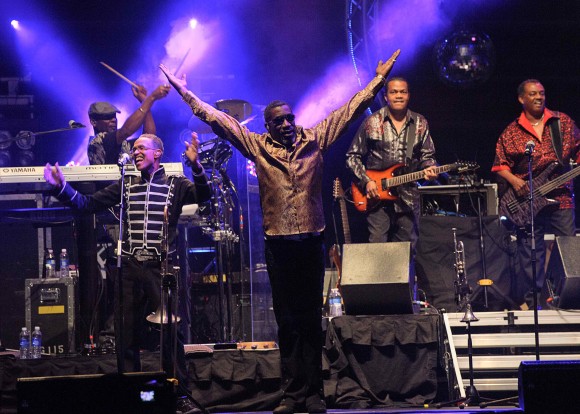 It all began for Kool and the Gang in New York City when they were just youthful teenagers. Thanks to its close proximity to their hometown, New York helped kickstart the band’s growth. As it turned out, their first shows in the Big Apple were also their first pivotal experiences as a young group. Their unwavering dedication to music has lifted the band from performing in subways and cafés to venues such as the Apollo Theater, Madison Square Garden, and other places across the world.
It all began for Kool and the Gang in New York City when they were just youthful teenagers. Thanks to its close proximity to their hometown, New York helped kickstart the band’s growth. As it turned out, their first shows in the Big Apple were also their first pivotal experiences as a young group. Their unwavering dedication to music has lifted the band from performing in subways and cafés to venues such as the Apollo Theater, Madison Square Garden, and other places across the world.
“We’re here in Dubai, we’re here in Australia, we’re here cause of song. From traveling so much I kind of got the connection that music is a universal language,” said Amir Bayyan, the band’s guitarist and the younger brother of Ronald and Robert.
Despite being on the road and having demanding lives at such a young age, Kool and the Gang have nothing bad to say about their extensive background of learning and performing–except for their views on Philadelphia.
“You can give those people free tickets, free food, free parking, and they’ll still have something to talk about. ‘Well I didn’t like the way his socks looked,’ mimicked Robert Bell. “It’s a tough crowd in Philly.”
Such exposure at an early age gave them the proper introduction to new learning experiences, good times, and most importantly, camaraderie: all of which would be renewed throughout the years as well.
Early on, after moving on to perform at weddings while still playing throughout New York City and New Jersey, the crew was invited to play at the Apollo Theater when they were only 16 and 17 years old. At first it seemed like an honor to play at such a venue, but Kool and the Gang was quickly roused by the other talent amongst them.
“We thought we had it all together … then this group called Willie Feaster and the Mighty Magnificents got up there … Oh man! They hit you with the vocals, the bass solos … they ran us back to Jersey City!” recalled Ronald Bell.
The young and talented are sometimes blinded by their surroundings, which seemingly was the case for the gang when they first hit the big stage at the Apollo.
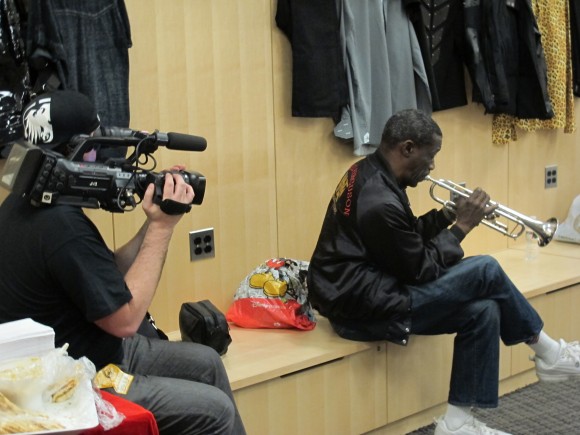
Ferro Camera-Op, Jamie Kiley, captures some Kool footage backstage at the Garden.
“We had to regroup. We thought, ‘Man, this is what we’re up against?’ But you know what, it helped us get our act together.”
A realization of that sort is a strong sign of maturity and growth, which can surely explain the illustrious history that the band has had (they have sold over 70 million albums worldwide). The pragmatic nature of Kool and the Gang has helped them bring their talent down to earth as well as maintain such great composure under various circumstances; even when an instrument caught on fire during a show in California.
“We’re playin’ and we get to [the song] ‘Too Hot’ … and I start to smell somethin’ … then I see people in the audience looking, pointing … and then keyboard caught on fire!” said Amir Bayyan.
However, maturity and growth did not always resonate behind closed doors.
When Kool and the Gang began to travel more and had to be on time for recordings and gigs, the boneheaded qualities of the boys began to surface more frequently, especially those of lead guitarist Charles Smith. However, these qualities were more of an amusement rather than a burden. Smith passed away in 2006, but his silly antics are still remembered by the remaining band members today.
“In my history of hangin’ with Charles Smith, a lot of people have called him eccentric. That’s the only man I know that made a limo back out the Lincoln Tunnel because he forgot something,” Robert Bell said while holding back laughter.
The band members recall waiting in front of Charles’ house for two hours as he dilly-dallied before coming out. Many times when they scheduled a recording session at the House of Music in West Orange New Jersey, the guys would all carpool there and they would typically find themselves sitting outside of Charles’ house for unreasonable amounts of time. On many occasions they would have to rush when Charles was finally ready, including one instance when they had to drive “90 miles per hour” straight down I-95 to make it on time for a gig in Atlanta.
One day Robert Bell was curious and decided to ask Charles’ son, “What does your father do in there?” Charles’ son replied, “Well, he puts his socks on then he plays his guitar. Then he gets dressed and plays his guitar. Then he starts making a phone call and he’s playing his guitar.”
Despite watching time wither away, the guys think that sitting there and waiting hours for Charles represents what being part of Kool and the Gang really is. Since day one, they have been able to stick together over decades and adapt to one another’s imperfections because of their lightheartedness and spirited dedication and loyalty. While they know how to joke around, they clearly are masters of their craft and take pride in their work and performances.
“You’ve got people that come out to see you. It’s not supposed to be their concern about whatever you’re dealing with in your life,” said Shawn McQuiller, the band’s lead singer since the ‘90s. “They paid their ticket and they came out to see a great show. So when we hit that stage, we got to give them what they paid for.”
Even if it means remaining “kool” when your keyboard catches fire.
Check out EXCLUSIVE VIDEO from the Kool Bus Tour by clicking here!
Don Sperling: Executive Producer
“Don’t ever miss an opportunity to make an impression. You never know who’s watching.” ~ DS
Prophetic words of wisdom spoken by Mr. Don Sperling. Keep reading and you’ll surely absorb the deeper meaning beyond the letters penned above. Letters turned into words, words become sentences and sentences become paragraphs, chapters and the ongoing story of an outstanding, career.
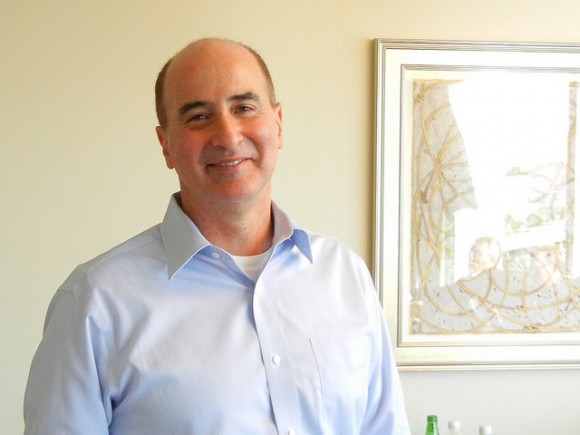 Don Sperling is the Vice President and Executive Producer of Entertainment for the New York Football Giants. Prior to accepting this VP and EP position, Mr. Sperling’s ambition and talent has propelled him through the ranks of the most notable “Three Letter” iconic companies, such as CBS, NBC, CNN, and NBA Entertainment.
Don Sperling is the Vice President and Executive Producer of Entertainment for the New York Football Giants. Prior to accepting this VP and EP position, Mr. Sperling’s ambition and talent has propelled him through the ranks of the most notable “Three Letter” iconic companies, such as CBS, NBC, CNN, and NBA Entertainment.
Ferro Productions recently had the privilege to sit down for an interview with Don, who is now approaching his seventh season with the Giants! We discuss his very impressive career path…put your seat belts on and ENJOY the ride!
Born and raised in Yonkers, NY, Don Sperling attended The State University of New York at Albany. He shares, “I didn’t have too many options. My Father told me I could apply to all of the schools I wanted, but it didn’t matter because I was going to end up at a state school anyway. It was all we could afford at the time.” UAlbany did not have television program at the time, which, by default, lead Don to a History & Political Science Major. However, he was writing for the school newspaper and doing some work for the school radio. In addition, every summer Don traveled to Miami to visit his aunt; an assistant news manager for WTVJ Miami, a local TV station. He had the honor of hanging out with the news crews, going out on shoots to Dolphins games, and watching how the whole production process took place. “It was really exciting. I was just a college kid and I got to watch these professionals work their craft. Being exposed to that behind the scenes atmosphere ultimately lead me to my first gig with CBS” Don explains.
Upon graduation, the twenty-one year-old Sperling got a gig with CBS news, working as a production assistant in the film library. He was pulling footage for the nightly news, for 60 Minutes, and more. While working at CBS News during the week, Don was also freelancing at NBC Sports working as a tape logger and highlights coordinator. These entry-level positions proved to a solid foundation for Mr. Sperling’s career. “I did well at CBS and NBC, but there was only so much room for furthering my career. I looked around at the crew one day and I realized it was going to take me a very long time to work my way up this ladder here. That’s when I reached out to CNN.” CNN? Hmmmm…. ATLANTA?
Don explained that making the move from New York to Atlanta was one of the most difficult of his young life but he realized that there was a great opportunity ahead of him with this NEW 24-hour network, called CNN. Mr. Sperling was working with a group of people from all over the
country who gave up their secured jobs back home to be a part of CNN. “It was the best thing that ever happened to me, going to Atlanta. I quickly made my way to segment Producer, which is something I would have never accomplished at CBS.” He was thrown right into the fire and he did not burn. As previously mentioned, he earned the role of segment Producer and then ultimately made the switch to Sports Producer. For two-and-a-half years Don helped mold what is now considered to be the most highly recognized news network in the nation, all the while gaining invaluable knowledge, experience, and lifelong friends.
Why did Don only stay at CNN for 2-and-a-half years? Well, the NBA was starting up their own Entertainment department, housed in New York City and shortly following an interview with commissioner David Stern, Mr. Sperling found himself in-charge of NBA Entertainment. Don was the Producer, writer, and editor and he was putting his heart and soul into the new company. They started out by building an infrastructure and foundation; keeping an archived library on EVERYTHING NBA, producing Features for the USA Network and
CBS, producing fifty-five halftime Features, and also getting involved in community relations and home video. With the birth of NBA Entertainment brought the birth of an all out NBA frenzy. The 84’ Finals pitting Larry Bird against Magic Johnson, Michael Jordan getting drafted (GIANTS of the game – no pun intended), jersey and ticket sales now through the roof… everything was blowing up.
With all of the media spotlight, the small crew of six guys that was NBA Entertainment, quickly evolved into a crew of two hundred. “We created NBA Inside Stuff which was on the Saturday morning lineup on the NBC network. We created the “I Love This Game” campaign. We did it all. We were even the first in the industry to make the switch from analog to digital. We digitized our whole library. We made the NBA relevant again. We made it hip. Everything we did was innovative, and I’m proud to have been a part of it. ”
After fifteen years, Don left his roll as Senior Vice President at NBA Entertainment, started his own company for production and consulting, and eventually landed a job as the Vice President and Executive Producer of Entertainment for the New York Football Giants. It is his job to construct a story each week, starting on Monday and culminating on game day on Sunday, building an emotional relationship between the fans and the organization using all the tools at his disposal aka “Giants Entertainment”. Giants Entertainment includes TV, Radio, Web, Social Media, and Game Day presentation.
Decades of passion and perseverance have brought Don Sperling to the pinnacle of the Television community. The man with such an outstanding career shares with us that his current role with the Giants is nothing short of a “dream job” and all of us here at Ferro Productions are sure that you will also agree, a very well earned and deserved “dream job” that through Don’s talent, timing, travel, tenacity, trials and tribulations, turned into reality. REMEMBER THIS… “Don’t ever miss an opportunity to make an impression. You never know who’s watching.” ~ DS
A Producer’s Role
The term “Producer” is as broad and varied as the industries they service. In theater and film the Producer is the dealmaker. Usually their responsibilities are:
Find a project. Secure financing. Hire the major players; Director, leading actors, support staff, etc. and manage the team to a profitable conclusion. Their part is primarily that of a CEO of a large corporation.
In broadcast and video production a Producer’s role is much different. Although they are involved in the deal process, their primary responsibilities are in the story telling and the creative process, similar to that of a Director in film and theater. During my career I have found producing broadcast or video demands a wider skill set then in other mediums. That is not to say theater or film producers lack skills, quite the contrary, raising millions of investment dollars and keeping marque talent and huge egos focused on the finish line takes an amazing set skills. I think the way broadcast / video technology has evolved and budgets have been down sized, todays broadcast producers have to be proficient in speaking and understanding a wide variety of disciplines while blending their talents seamlessly. It is this multi language skill set that is the key difference in Video Producers.
For a simple analogy of a Producer to a broadcast project is to compare him to a GC (general contractor ) of a construction project. In construction the GC is the bridge between the client’s architect and the team of contractors that must bring these drawings to life. The GC must understand the vision and purpose of the drawings. He must be aware that many architects do not work in the field therefore their vision maybe a little unrealistic. He must then meet with and hire the most appropriate carpenters, electricians, plumbers, masons, roofers, finishing carpenters, etc., etc. He must layout the timing of material deliveries to coincide with the build process. He must allow for inspections and modifications from both the client and inspectors. He has to be aware of the weather and have ready a fallback plan in case the elements effect is building timeline. The list goes on and on till the project is complete.
Now substitute the title GC with the title Producer; exchange architect with network development team. Replace carpenter, plumber, electrician, etc. with Camera Operator, Editor, Lighting Director, Audio Operator, etc. and you have just descripted the video production process. It is easy to understand that if your GC has swung a hammer, wired a house or worked as a plumber assistant he would have a have a greater appreciation of those crafts and will possess the ability to speak to those craftsmen in terms they understand. He will be aware of their limitations and be able to provide intelligent workarounds when problems arise. If he is truly confident in his abilities and wise in his experience, he will ask them for their input and be open to their suggestions. Production as in construction is a team effort. The GC or Producer ate there to keep the team focused and moving down the field. They are both coach and QB. And sometimes they must even carry the water.
These simple yet critical abilities create a motivated team. A team that feels respected and willing to go the extra mile. A team that feels you’ve earned the right to lead them. You have taken the time to understand their job and appreciate what it takes to do that job well. When all is said and done its usually not just money that moves people to do their best work. Its mostly respect. Respect for their talents, their opinion, and their contribution.
Creativity is a Team Sport
Production or producing is a team sport. Or have we forgotten that fact, given the advent and advancement of new technology? With the advancement of technologically creative tools and their inexpensive price points, we straddle the fine line between “because we can, does that mean we should.” My point is this, just because technology allows us access to each phase of a project, independent of other artists, should we accept that as a positive or better approach? In the Thirty something years I’ve been bouncing through both the music and television industries, I have concluded the answer is an emphatic, NO!
There is no arguement that access to pro gear at an entry level price has allowed many, who would never have been heard from, now have a voice and I believe that’s GREAT! I am a strong proponent of the notion that everyone possesses talent. For some it lies on the surface, for others it’s buried and needs to be mined like a precious metal. Regardless of where that talent resides, creativity and its expression needs to be nurtured and cultivated, bringing me to my main point.
Never create in isolation. That is not to say the genesis of an idea MUST be the results of collaborative efforts, although it may well be if it naturally took that course. Regardless of which, bringing that vision to life will always have a better chance of soring beyond your expectations given a blend of creative specialists.
Imagine for a minute going to a concert to hear your favorite band, you arrive and instead of the 5 experienced musicians who have all mastered their instruments, you see a single unknown keyboard player on stage using an array of synthesizers simulating the performance of the missing musicians.
He may be able to reproduce every note in their songs but the X factor, soul and personal interpretations of those musicians will surely be missed. Each artist brings a lifetime of mastering and passion woven together by their day-to-day, year-to-year experiences. No single person can duplicate those artistic impressions. I see each of us as a “flavor” or an ingredient to be combined to produce the perfect meal. No satisfying meal ever came from a single ingredient!
When you hear about of an actor who decided to go out on his own to write, produce and direct his vision, he still has an army of experts collaborating on that vision.
When a musician breaks away from their band to do a “solo” album, they still rely on the talents of others to create their solo vision.
With a deep sense of humility, I can say I am quite comfortable at most phases of production in both music and video. Even with that comfort zone I would NEVER assume responsibility of all aspects. Nothing I am proud of came to life solely by my talents. To this day it remains embarrassing for me to be referred to as an Emmy award-winning Producer. Those Emmys belong to everyone on those productions.
These words I speak are not just the words of a humble acceptance speech, they are fact.
The most AMAZING creations are the ones that come from a perfect combination of “FLAVORS”.
How an Internship Can Launch Your Career
Motion pictures, television, music, radio, theater, and live performances are all aspects of the ever-growing entertainment industry. These businesses heavily rely on internships and other employment programs of little-to-no-cost because of their highly competitive nature. It’s hard to break in, but these positions just below the entry-level provide an avenue for the unknown to make a name for themselves and prove their worth. But all of this shouldn’t be an issue if you have a college degree, right?
“The thing that bothers me most is when somebody sends me a resume and says, ‘I want to come work for you,’ and I look at the resume and there’s nothing on it that tells me they were a part of broadcasting,” says Steve Cohen, the Senior Vice President of Sports Programming at Sirius Satellite Radio. “Then I say, ‘You want to apply for a job, but you have no experience?’ and they reply, ‘Of course I have no experience! I just graduated college!’’
Mr. Cohen has spent years working hard and burnishing his skills, especially prior to graduating college. He doesn’t buy the whole “I have no experience” excuse that many recent college graduates seem to promptly pull out of their left chest pocket. He has endured an arduous road before earning his coveted position of influence at Sirius Satellite Radio. But just exactly how did Mr. Cohen arrive at this point of his career? It would only be appropriate if we outline (a few) of the myriad jobs and experiences that led to his success.
It all started for Steve Cohen on an airplane. Shortly after the plane took off he became airsick and had to seclude himself from the other passengers. This wasn’t a passenger airline. It was a small prop plane. Cohen was on an interview assignment for his first internship during his college years at the University of Arizona. KTKT radio, an AM talk news station, sent Steve out on a mission with Arizona State Senator Dennis DeConcini and his crew to track drug dealers coming across the border of Mexico. So Steve went and sat down by himself when his feelings of nausea arose. A few moments later, Senator DeConcini approached him with concern and asked, “Son, are you all right?” Mr. Cohen picked up his head, looked at the Senator and replied, “Yeah. But while you’re here, can I asked you a couple of questions?” Since then, Cohen’s career took the inside track and left the others in the dust. (Literally. He also started the NASCAR channel on Sirius Satellite Radio.)
Mr. Cohen will be the first to admit that the path to following your aspirations is less than gratifying. One might be unsure of where they want to be, remain stuck somewhere for too long, or perhaps feel under-utilized. But none of this should cloud judgment, especially if one is active prior to entering the post-college workforce. Internships and student-oriented work programs can provide an opportunity to ask questions, learn various jobs, find out what made current employees successful, discover what needs to be done to get ahead in the business, and last but not least, build your resume. Mr. Cohen believes that internships prepared him for what was to come in the daunting and competitive workforce, so when the time came he knew when and how to ask questions as well as how to get ahead, which ultimately would help him work harder and separate himself from the crowd. And if he was able to go from intern to Senior Vice President before the emergence of modern technology, young adults could be at an even greater advantage today.
“We didn’t have the Internet. We weren’t on computers checking scores or on our iPhones or any of that,” said Mr. Cohen. “If you needed to know a score, you picked up a phone and called the press box to find out what the latest score was.”
How’s that for some perspective of the time period? Imagine that you were traveling for the day and had no access to find out what was going on with your favorite team. Maybe you would find a payphone at some point and call the press box only to be devastated when you found out they got crushed. Nowadays, if your phone’s battery is at 20% there’s an onset of lightheadedness, followed by an aimless scramble to find your charger. This reliance and obsession with various forms of technology has led Mr. Cohen to identify some potential communication disadvantages in the modern day workforce. Despite being able to effortlessly contact people and find almost anyone’s information, technology can sometimes act as a veil and inhibit the development of relationships; especially personal relationships that are essential to advancing your career. E-mails, for example, are usually read as a monotone message devoid of any personality, which can greatly influence interactions with others.
“You don’t build relationships texting and emailing people,” asserted Mr. Cohen. “You build relationships talking to people, seeing people, meeting people, hearing their voice, feeling their vibe, engaging them in conversation. Today everyone is communicating through texts and e-mails. It’s nameless. It’s faceless. There’s no emotion to it.”
With technology being such an integral part of today’s society, members of the workforce, especially the youth, must be conscious of how to properly communicate with work connections and superiors. It’s imperative to make an impression once granted the opportunity to do so. Nobody wants to be remembered as a thread of texts or a trashed email. Which is why Mr. Cohen cherishes who he has met as well as the manner he was able to meet these people.
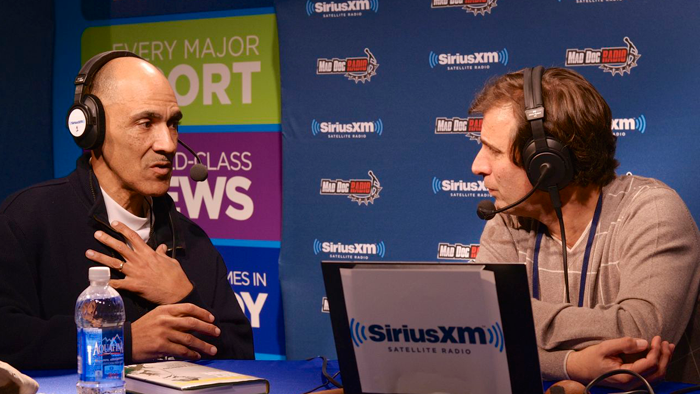
Mr. Cohen wasn’t lying when he assured “expert talk radio.” Tony Dungy is on the air with Mad Dog Radio.
He recalls his “big break” during the summer of 1986 when he was interning at WNBC for the Joey Reynolds Show (Note: another internship). He was granted autonomy in various respects; he was writing comedy and movie reviews (among other things that were going on the air), he got a glimpse into the world of producing, and he established relationships with people who would be part of his career as well as his personal life. One person in particular was Mike Breen, who today is the lead announcer for the Knicks on the MSG Network and he’s also a play-by-play sports commentator for the National Basketball Association on the ABC Network. Back in 1987 Mike was doing overnights at WNBC and sleeping in the office; doing whatever he had to do to stay afloat in the business. Steve kept him as a connection after meeting him at the Joey Reynolds Show.
A year later, Steve graduated from the University of Arizona in 1987 and got his first full-time job at KGUN TV, which was the ABC affiliate for channel 9 in Tucson. After spending some time there, he was unsure of what he wanted to do and where he wanted to be. His next move was taking a sixty-day leave of absence to return to New York to figure it all out. And whom did he call for some advice? His old buddy Mike Breen. “Mike told me they were starting an all-sports radio in Queens,” Steve recalled. “’All sports radio?’ I thought to myself. ‘That would never work!’” (Funny, right?) Nonetheless, he took the information Mike gave him and called the director to inquire about any open positions. And just like that, Steve was granted an interview and got hired as a board and tape operator. But perhaps even more significant was the fact that before being interviewed, Steve sat in the office for three hours while he waited for his interviewer to arrive back from a lunch date. He was waiting on a couch alongside a man named Joey DeFazio who was also interviewing for a position. After a few hours of speaking with Joey, Steve found a future producer and friend of his, who is currently working with him at Sirius.
Through that single internship experience, Mr. Cohen was introduced to the post-college workplace environment along with the various assignments that came with it. He developed skills he never thought he could wield. He made connections, and they helped him officially begin his career, which led him down a path to make more connections. His first job and his connections’ connections helped him obtain another job at WFAN radio network. A 17-year career at WFAN had him working inside the locker rooms of the New York Giants and the New York Jets and gave him the exposure that he needed in the sports world to comprehend what it took to successfully and creatively operate a sports radio station. Additionally, his close interaction with radio hosts Mike Francesa and Chris Russo on the “Mike and the Mad Dog” afternoon drive sports radio program guided him toward new heights as a producer, which included booking guests, screening live phone calls, and monitoring the show’s commercials. And finally, his career at Sirius Satellite Radio has been a pioneering effort, where Mr. Cohen helped build a team to establish a multitude of sports radio channels (NFL, MLB, NBA, NHL, PGA, NASCAR, and more) with an expert-talk theme. Each channel now features a professional, a former professional, or anyone at the front lines of the business who can provide meaningful insight from their perspective. He began his career at Sirius in 2004 as the Director of NFL Programming and soon became Senior Vice President of Sports Programming; a position that allows him to oversee the entire sports department and make decisions regarding new sports programming initiatives.
It’s never too late for you to begin seeking out opportunities to create a foundation for your experience, and Mr. Cohen can assure you that it’s certainly better than lamenting about your lack thereof.
Creative Set Design for Broadcast
As the modern history of the USA grows each and every year, so too does it’s peoples euphoric fascination with professional sports. The multi-billion dollar a year industry, that is pro sports, collaborates with another multi-billion dollar industry, the production industry, which further fuels the fire of the sports media frenzy. So exactly what is it that has turned these friendly children’s games into full-blown Hollywood features? Perhaps it’s the skill level of the athletes? Or maybe it’s the beautifully orchestrated in-game productions presented by the television networks? Or could it be the never ending, 24/7 analysis and opinion provided by the experts on networks such as ESPN, NBC, MSG, etc… Whichever it is they all demand the highest level of production both in content and presentation. One of the top style designers and presenters for the industry is a unique prop house in CT.
Earlier this year our crew traveled to Chesire, CT, home of Creative Dimensions. As mentioned on their website Creative Dimensions is a “state-of-the-art facility… with dozens of skilled, specialized employees and a national reputation as a top broadcast, exhibit and signage design and manufacturing company.” In other words: These guys design and create Broadcast desks, sets, and signs for some of the most reputable names in the industry. Ferro’s Executive Producer and President, Joe Scacciaferro, had the privilege of sitting down for an interview with both, Joel Roy and Bill Violette, the Co-Founders of Creative Dimensions.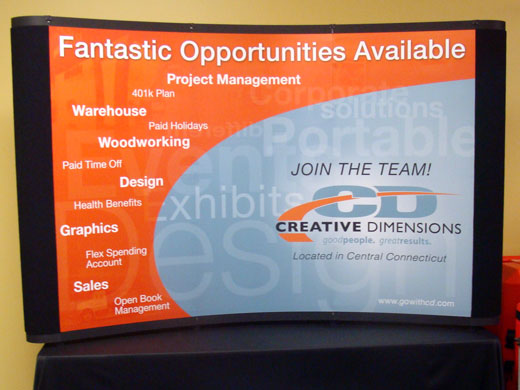
Bill Violette spent the early years of his career working as a foreman in a kitchen cabinet shop. Eventually he got bored with his daily routine of building 7-10 full kitchen cabinet sets, and after a recommendation from a friend, Bill began working in the warehouse of an exhibit company. ”Eventually I worked my way up to a skilled builder, building exhibits. I was traveling all of the country and setting up these massive displays for companies like Gulfstream Aerospace and Pratt & Whitney. I was putting together actual jet engines and fuselages at these exhibits…These things were literally bigger than your house and had to be set and ready for viewing in just 3 short days.”
Bill had fallen in love with the exhibit lifestyle and was learning invaluable information and skills at a rapid pace. After just eight years in the industry he ventured out and started up his own business. “I didn’t have all of the finances for in-house services such as graphics and painting, so I outsourced for that stuff.” It turns out that Bill’s initial lack of funds would subsequently introduce him to his fellow co-Founder of Creative Dimensions, Joel Roy.
Mr. Joel Roy went to college for graphics design, although, once he graduated from school he ended up working for a sign company. “In college I envisioned myself designing logos, magazine adds, posters, that sort of stuff. Once I started looking around the industry I realized that there was a lot more going on out there.” Joel spent his days at the sign company learning how signs were made: What materials they were made with, how electricity was involved, how colors played a key role, and how signs were installed.
Mr. Roy recalls a drastic change in the industry during the 1980′s when “everything went from manual to computer”. Joel was now using a Gerber 4b automated computer to make a living rather than using his bare hands.
Ultimately (25 years ago) Joel and his father created their own sign and graphics company. It was at this time that Joel Roy and Bill Violette became familiar with each other. ”We did a lot of freelance work for Bill, mostly signs and graphics. After about seven years of collaboration we decided to join forces. Carpentry, design, sales, and administration were all now blended into one company, and it was called Creative Dimensions.”
The company started off small; Seven people, all pitching in and multi-tasking in order to reach one common goal. During the early days Mr. Violette remembers receiving phone calls from people asking about haircuts, but, “eventually people got to know us as an exhibit company.” Little did he know, however, the exact extent that people would recognize them as THE exhibit company…
Creative Dimensions is located in Northwestern Connecticut, and ESPN is also located in Northwest Connecticut, so it seems like these two companies were destined to do some sort of business together over the course of time. Approximately fifteen years ago ESPN did indeed reach out to Creative and requested the design and creation of a flat sign for a set piece. “One of our talented designers wanted to jazz it up and put some dimensions on the sign, rather than having it be so flat and boring. ESPN loved it. They came back for more…and more…and more. Before you knew it, we were making signs for the Super Bowl” shared Mr. Roy.
The partnership between ESPN and Creative Dimensions was not stopping there, rather, it was simply ramping up to the next level. ESPN was so pleased with the signs being developed for them by Creative , there was a request to start making them broadcast desks. Considering the combined knowledge and experiences of Mr. Violette and Mr. Roy, it comes as no surprise that they did indeed develop a beautiful broadcast desk for ESPN that was “Up to exhibit standards and looked brilliant on HD Television.” And just like the signs, ESPN was now hooked on the masterful broadcast desks being made by the Creative Dimensions team.
Today, Creative Dimensions is responsible for nearly everything you will see on the set of most major networks sports shows or a sporting event. Signs, Desks, Walls, props… you name it, they designed and created it. A lot of their partners from ESPN have moved on to other networks, which has led to even more business with more companies… a true snowball effect that has catapulted the small group of hard working designers and laborers into the most prestigious name in all of television when it comes to set design.
Ferro Productions would like to give a monumental “THANKS” to everyone at Creative Dimensions for granting our crew access to their facilities and for their utmost hospitality and professionalism.
Shooting an episode of Charlie Rose
The day begins very early, because of the extremely high level of security screening. The location is The Waldorf Astoria and we’re here to tape an interview with the new President of Egypt, Mohamed Morsi. We load in half a cube truck of video, lighting, engineering and grip gear, then we’re given a small two room suite.
One of the fun things about working as a camera operator is getting to opportunity to work with other gifted DPs. This day it’s Paul Koestner, the DP of the Emmy award winning show “Louis”. The lighting set up is very simple, but elegant. Two Diva lights for keys, over the head of each person with two 300 watt backlights a few feet behind them. In the next room, an interpreter’s booth is built, along with the video city. We’re shooting with two Sony PDW-F800 disc camcorders. The show is switched live and also recorded in iso at the cameras. Once we’re set up, we move out and the Secret Service comes in and does a sweep. Then Egyptian security does a sweep. Once everyone is happy, they bring in the President and he meets Charlie for the first time.
The interview lasts about a half hour and goes well. Then comes the long process of tearing down and repacking the gear. The long wait to load out after that is because of the even tighter security screen that follows our own leader. President Obama is in the building.
It’s challenging and exciting working on these jobs, because of all the protocol and politics. The security screenings can be annoying, but they’re in place for good reason. As long as you remember that they’re in charge and you’re a guest. At the end of the day, what matters is that we get the show on the air.
Keys to Success: The David Rosenthal Story
David Rosenthal’s illustrious talents and ambitions have propelled him to the pinnacle of the modern music world since his graduating from Berklee College of Music in Boston. Top Ten Singles, Grammy Nominations, and World Tours with names like Billy Joel and Elton John, Bruce Springsteen, Enrique Iglesias, Robert Palmer, Cyndi Lauper and many others. For most folks, a dream of unobtainable proportion and for Dave, well, merely a few “BUCKET LIST WISHES” he’s been able to check-off on his Keyboardist, Orchestrator, and Synth Programmer’s to-do list.
David also shares his passion for music through education; giving lectures at universities and music industry seminars, and more recently, the release of his DVD, “Building Your Music Career.”
One might argue that David Rosenthal has done it all in terms of professional achievements, and in the opinion of Ferro Productions, that argument would hold up in even the highest court of law. That being said… let’s take a look at where it all began. How does a young boy with an interest in music end up touring the globe with Billy Joel on the world’s biggest stages? Let’s rewind the clocks and take an exclusive behind the scenes look at David Rosenthal’s path to success…
“I started playing when I was seven. I asked my parents for a piano, I don’t know why. They told me no, that pianos were too expensive. Weeks passed and I continued to ask my parents everyday for a piano, but still the same response. Finally I decided to start saving my allowance money. Eventually, after eight weeks, I had saved two dollars. I went back to my parents and asked ‘Will this help?’ They were so moved by my passion that they went and wrote that check for the piano, minus two dollars, and I gave the guy the rest of the money in my allowance quarters,” shares Dave.
At this point in time, a young David began taking piano lessons just like any other child would. Unlike any other child, however, David was progressing at a rapid pace. Mr. Rosenthal recalls his old piano teacher sitting down with him after a lesson and asking him how he was learning these songs so fast; insisting that there must be some sort of external source that would justify this phenomenal progress. In his truest, most sincere fashion, David responded, ” I don’t know. You tell me to play this, so I play it. I don’t think it’s that hard.”
A few years passed and David started “getting more serious” and studying Classical Music. Along with his astounding interest in the Classical genre, the twelve year old David was interested in Pop and Rock music, much like other adolescents. Although, unlike his peers, David was now playing in a band… with a group of seventeen and eighteen year-olds. He was so young that his parents wouldn’t let him hang out or even practice with the band at any location other than their own home. Nevertheless, David was jamming and loving life, all-the-while continuing on his quest to fulfill that burning desire in his heart to learn music.
Coming out of High School it was very apparent that David’s love for music would be punching his ticket to the future. As previously mentioned, Mr. Rosenthal attended Boston’s Berklee School of Music. While enrolled at Berklee, he completed an intricate, unimaginable TRIPLE MAJOR in Audio Recording, Electronic Music, and Piano Performance. As if David’s list of accomplishments wasn’t monumental enough by the time he graduated, he was about to make his resume sexier than he ever thought possible. In fact, he was about to join the club where there are no resumes needed, just sheer talent and reputation…
At the start of the 1980′s, Rainbow, headed by lead-guitarist Ritchie Blackmore, was one of the biggest names in Rock n’ Roll. Mr. Blackmore happened to be mutual friends with a guy that David Rosenthal was a friend of, so when the band was auditioning for a new Keyboardist in 1981, David sent Ritchie a tape of his cover band and some classical piano pieces and subsequently received an invitation to try-out for the band.
Mr. Rosenthal recalls showing up for the audition, not knowing what to expect. “I showed up and Ritchie wanted me to play his equipment. I had never played any of those keyboards before, but we just jammed, and I did well. When I got the call back saying it was between me and one other guy and that I had to come in for another audition the next night, I quickly found a Sam Ash in Long Island with a Mini Moog and I played around with it all day until I went to the audition. I wanted to get an edge any way I could, so I figured if I got to know the synth better I could go to the call-back and be able to do more with it than I had the day before.” Needless to say, the twenty-year-old David got the gig and the rest is legitimate music history.
It’s always a pleasure working with a true professional like David Rosenthal. David, like many others in the entertainment industry, always had a deep desire to keep learning and keep creating. Remember: It’s not about the fame, or the money; rather, it’s about the love and the passion.
“Music chose me, I did not choose music. There was no shade of grey for me. This is what I do, period. It all worked out for me but whether it did or didn’t work, I would still be doing what I do, and that is music.”
Managing on the Road
Since 1985 my company has done the production for Dick Fox’s The Golden Boys starring Frankie Avalon, Fabian, and Bobby Rydell. Acting as the Tour Manager, Road Manager, Production Manager, Lighting Director, and Video Director has provided me with some of the most memorable experiences of my professional career, and furthermore, my life.
Just recently our show completed a five city swing from Canada to Florida. Each day a new city and inevitably, a new challenge: Arrive in city –> set up for show –> rehearse show –> perform show –> strike the set and load for travel –> travel overnight on the bus or hop on an airplane –> wake up in a new city and do it all over again. This craziness, for the most part, is organized and executed all by one man…ME! This includes (and is not limited to) thousands of dollars worth of equipment and dozens of crew members as well as hotel/travel accomidations, transportation for crew, food for crew, the actual HIRING of the crew, ETC…. and the list truly goes on…
My most memorable night during our Canadian tour was at the Caesars Windsor. I’ve been apart of
productions at locations such as Carnegie Hall and Madison Square Garden and I’ll tell you what… This venue ranks right up there with the best. On this night we put on quite the show. We had a full television set-up including a seven man video crew, a five man lighting crew, and a five man audio crew. Some notable pieces of equipment used were the Yamaha Digital PM5D Audio Mixers at all monitors and FOH, as well as the breathtaking 600 fixture lighting rig.
After a long night the show came to a conclusion. I must thank all of my crew members for such a flawless execution and performance as this was truly an extravagant evening of show biz. I’ve come to learn over the years that a successful and smooth production really relies on the amount of pre-production put in before the actual performance.
At the conclusion of a quick “break” from production, our show heads back out on the road for another tour. Make sure you come check back for more insider stories and pictures and don’t forget to follow Ferro Productions on Twitter and Facebook for even further behind the scenes content!
More stories/videos on Art:
Up-and-Coming: Michael “Horse” Becton
What does it take to succeed? Furthermore, especially when all the odds are pointing in the other direction? How does one find the courage and the motivation to soar above and beyond the status-quo, in order to reach higher ground? Ferro Productions unveiled the answers to those questions during our most recent Up-and-Coming interview, featuring Michael Becton… Enjoy!
Michael Becton is a talented twenty-six year-old from Brooklyn, New York… Brownsville to be exact. A neighborhood in Brooklyn certainly NOT short of notable native born talent that ranges across the board to include the names and brilliant careers of the GZA, RZA, Andrew Dice Clay, Aaron Copland, Arnold Greenberg (co-founder of Snapple), Larry King, Willie Randolph, Otis Wilson, Mike Tyson and many many more. Similar to the majority of young males in America, Mike always had a warm spot in his heart for music and sports. His favorite sport: Football. His favorite music: Hip-Hop… and how fitting, if you consider that New York City is notorious for not only birthing some of hip-hop’s most renowned artists, but for birthing the genre of music itself.
“It’s the roughest neighborhood in New York. I decided at an early age that I was going go to college and provide my mother and grandmother with the lives that they deserved.”
After graduating high school Michael fulfilled that dream of his and began classes at Morgan State University in Baltimore, Maryland. Initially enrolled as an Electrical Engineer major, he quickly decided that a change was needed. Mike ultimately made the switch to Television Production because he felt it would not only allow him to work towards a career where his creativity would flourish but it would also give him an opportunity to work in the Sports and Entertainment industries that he loved so much.
In the early years at Morgan State, Mike recalls hanging out with a few friends at a local recording studio and laying down some verses. After that first trip to the studio Mike began writing music of his own but strictly as a creative hobby…
By senior year the Brooklyn native got his first big break into the TV industry, working as a production intern with the Baltimore Ravens Broadcasting Department. He was part of a small crew that was responsible for portraying the Ravens to the media in interesting and exciting ways. Whether is was TV shows, commercials, or stadium presentations, Michael was thrown right into the mix and as he shares, “It was amazing. I was mixing sports and television and I was only twenty-one… I loved it.”
Following a job-well-done with the Ravens, Mr. Becton immediately landed a job with the Baltimore Orioles Broadcast Department where he was a game-day camera operator for the stadium presentation, as well as a contributing editor for their local programming. It was now beginning to become apparent that Michael was well on his way to earning his stay in the television industry.
Michael graduated college while working the Orioles. It was at this same time that he came across a Tweet (Twitter) that would forever change his life. A person affiliated with the New York rapper, 50 Cent, sent out a tweet informing the public that they were looking for an editor to contribute to the website ThisIs50.com. Mike immediately sent over his resume and, you guessed it, he landed the gig. “They saw that I had been around celebrities before. They saw that I could operate a camera and I could edit, and they saw that I was a local New York kid.” Needless to say, the music lover in Michael made the executive decision to move back to NYC and take the gig with G-Unit and ThisIs50.
Mike’s first day on the job was one that he will never forget. He sat down with 50 Cent, who was, “ Very professional and very encouraging. He treated me with nothing but respect from day one. I can’t say I wasn’t a little star-struck at first though.” Shares Mike. Although it was a dream job for Mr. Becton, it turned out to be short-lived. After four months of shooting and editing interviews for ThisIs50.com he got a call from the New York Giants Broadcasting Department, who ultimately offered him an intern position after a successful interview. He left the job with 50 Cent, but not before making a lot of great connections in the music industry. Michael was still very interested in music…
“TV and Video was something to pay the bills. The whole reason I went to college was to land a job that would help me pay the bills and provide for my family. I always had music in the back of my mind though.”
Upon completing his first season with the Giants, Mike was offered a full-time job as an Associate Producer. All of his hard work, all of his dedication, all of his perseverance… He now found himself with that full-time salary job that he always wanted. A goal that he decided at an early age he was going to obtain…
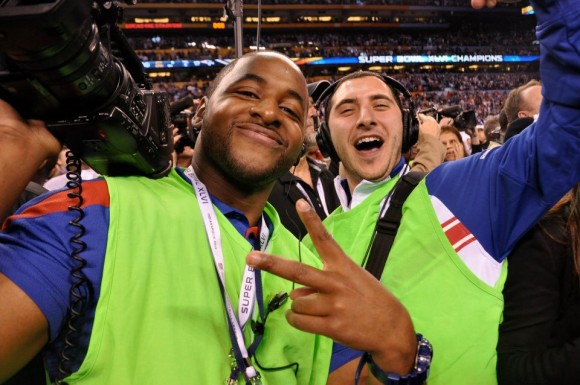
The second greatest moment of Michael’s life: Celebrating on the field after the Giants victory in Super Bowl XLVI.
Mike now finds himself in his fourth season with the Giants Broadcasting Department. He is traveling to a new city every weekend, he is using his creativity and passion as a means to obtain income, and he even got to experience one of the greatest moments of his life. “Shooting camera at the Super Bowl was the second best moment of my life, behind only the birth of my daughter. I remember sitting on the bench during the pre-game and just having that moment of clarity where I got the chills and everything. I looked up and saw my mother sitting in the twelfth row and I just smiled. I knew I had done something right in my life.”
In the midst of a hectic schedule, the young and accomplished associate producer put some of the connections from ThisIs50 to work and has since recorded two rap albums. The EP’s feature some club songs, some songs for his daughter, but mostly songs that tell a story about Michael’s life. “Although I write my own lyrics and find my own beats, I can’t consider myself a rapper nor a producer. You’ve got to earn your stripes for something like that. I’m just putting my creativity to work in a hobby, much like some people do with video games or something. Unlike video games though, I think that this has the potential to turn into something big.”
We hope that Mike’s story serves as a means of motivation to all of those aspiring to make
..
http://mississaugatransmission.com/echgn/why-pay-for-dating-sites/
..
http://mississaugatransmission.com/echgn/hot-young-teens-webcams/
it in the industry; as it certainly has inspired all of us here at Ferro. When we asked Mr. Becton what trait he possesses that enabled him to arrive at this exact point in his life, he said, “ Aside from hard-work and all that, I think you always just have to stay humble. There is absolutely no room for ego in my life, or anyones life in my opinion. Where I’m from, all the people with egos, are now dead or in jail.”
Interested in listening to some of Horse’s music? Click here and enjoy!
The Trooper
By Joe Scacciaferro
Original Design spec:
The client needed a print and static web AD for their new headphones that were offered in multiple florescent colors. They wanted the ad concept to include the headphones, audio cassette and florescent colors.
Execution Begins:
They began by developing the look and style of the images called out in the Original Design Spec (see above). At this point Swen decided to start the design with the audio cassette. He began with a 3D model rather than modify an existing image or pic. 3D imported the model as “spline” frame (see BEHIND THE WIZARDS CURTAIN Note: 1)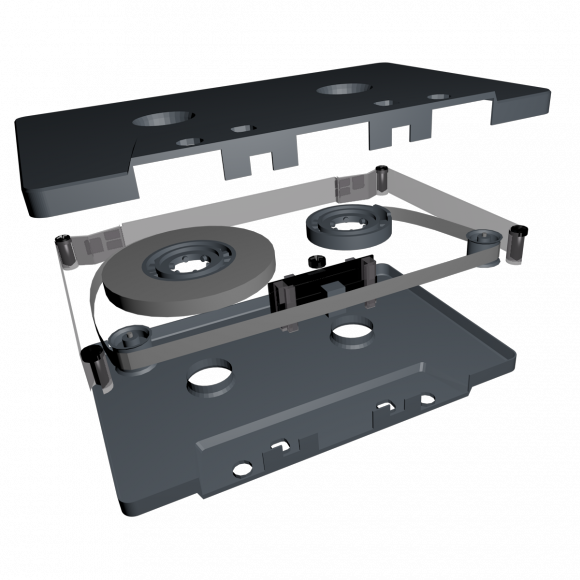
The headphone element came from a CAD drawing used for the actual product development. (see BEHIND THE WIZARDS CURTAIN Note: 2) After bringing the cassette model and headphones to life, they began experimenting with several combinations of elements. The client and Swen finally landed on the concept of an exploding cassette with music and sound elements busting through the walls of the cassette. Although, this exact concept could not be developed to the client’s approval it did lay the foundation for the ad in its accepted and present form. Swen recalls, “After several tries I couldn’t get the look real enough so instead we went with a stack of cassettes that were falling apart.”
Swen duplicated the cassette model over and over; changing the florescent color and randomly stacking the cassettes. After those elements felt right he added an “explosion” effect that created the particles / cassette pieces blowing out from the stack. (see BEHIND THE WIZARDS CURTAIN Note: 3) From there the headphones were laid over the cassette stack.
The final touch, as always for Swen, is lighting. Swen explains, “Lighting in 3D is the same as in real life. The light spray, wash, direction and intensity all come from their placement and fixture type just like in reality. Its crazy how cool they made these lights; even the diffusement used on the lights are similar to the lights found on most film and video sets.” Here Swen used one harsh light coming from upper left. (his “key” light).
There is another fixture on bottom left place far from the cassette stack and finally a small fill and a backlight. Where 3D leaves reality is on the actual cassette cases. Each cassette had a “luminance tag” on them.(see BEHIND THE WIZARDS CURTAIN Note: 4)zWithout the tag the colors would be affected and react as they would in the “real” world. With the tag the color will not react to the external lights. Shading is generated by “ambient inclusion”. (see BEHIND THE WIZARDS CURTAIN Note: 5)This is an effect is applied to the entire scene and creates all the shadowing details based on light placement. This effect always extends the render and should be used only as needed. In this case it worth it.Designers final notes:“This particular concept evolved rather then having a defined visual from the outset. This was a perfect example of concept following execution realities.”
BEHIND THE WIZARD’S CURTAIN:
NOTE 1: Purchased a 3D model from TurboSquid.com for 60 bucks. Imported the model into Cinema 4D as a *spline frame. The model came as a “transparent” cassette exposing all the inner workings of the cassette. Removed the inner workings of the cassette Model. Having all those parts visual made the model to complex for this concept. Cinema being so cool, will calculate all images or parts of an image then add shadows and hightligts on every piece of the model. This is done in an effort to ensure the final render will look as real as possible. The more complex the image the longer the render time. For the purpose of this add that feature was not necessary and would add a considerable amount of unnecessary time to the final time budget. (this is key to keeping a client happy)
*spline is a term used to describe the 2D framing of an object. Wireframes are usually added to these frames to begin the detailing process.
NOTE 2: Since the Computer Added Design (CAD) used the same extrusion points it allowed for ease of texturing and lighting.
NOTE 3:
Color shader: Once a color is selected and set it will be affected by lighting.
Luminence shader: Selecting and placed it will generated its own “lighting” and ignore all external lighting.
NOTE 4: Ambient Inclusion calculates the objects shadows by all natural parameters distance Point of View (POV) of viewer.
Broadcast Innovation : Jack Kestenbaum
“I don’t know what you’re going to do, but someday down the road, you’re going to be a great curtain puller.”
Those words, spoken of a man who would forge onward to an illustrious 42-year television career, much of which just so happened, behind the curtain. His accomplishments are more than worthy of the title “pioneer and innovator” in broadcast television.
Thank you Mother Kestenbaum for penning those prophetic words and thank you Jack for all you’ve done for television above and beyond ‘curtain pulling”.
Jack’s contributions are part of the moving force that developed and refined the technologies that gives us the television experience we all enjoy today. Whether it’s hearing the play calls from a quarterback, the sounds of horses jockeying into the gates, a skater’s blade cutting through ice or making sure the President doesn’t get egg on his face all happened because of Jack Kestenbaum. Quite literally Jack stepped up to the requests made by some of the most famous names in the TV Broadcast industry, and created, from their lips to our ears, the technology to make it all happen.
Jack is presently the Director of Technical Operations for the Yes Network, home to the New York Yankees, Manchester United, Nets and other award winning programming. YES’s coverage is touted as one of the country’s top regional sports network. His current success was not served to him on a silver platter, rather it was the result of decades in the entertainment business perfecting his craft.
Jack’s journey began in 1968. After a stint with the Army’s Signal Core where he acquired a solid background in electronics, he found himself in Poletka, Florida, selling advertising for a local paper.
The manager of one of his account offered him a job in a new venture, and as fate would have it, this new venture was called cable television. He wore many hats while there. He produced, directed, audio engineered various programs including a show whose format was borrowed from an unlikely place, church bingo.
His gained knowledge and experience landed him a job at WTLV, a NBC affiliate station. Once again sporting several technical hats. Soon an audio engineer position appeared, an opportunity that would lead him to the role that would eventually define his career.
After 18 months at WTLV, and after the birth of their first child, Jack and his family returned home to New York City. The valuable time on the front line he acquired in Florida, made him a hot commodity in the New York broadcast industry, landing him a job at ABC.
“The guy that was doing Chanel 7 Eyewitness news in NY was about ready to go on vacation, and they didn’t have a qualified person. They snapped me right up.” Jack recounts.
During his first three years at the network he worked on several shows, including the $10,000 Pyramid with Dick Clark and Good Night America with Geraldo Rivera.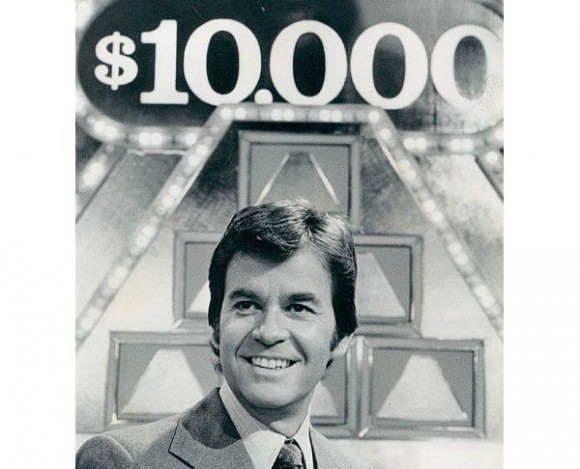
In 1976, Jack took part in a variety show called Saturday Night Live with Howard Cossell. The goal was to make Cossell the next Ed Sullivan, and with such high goals, comes high expectations. Necessity would be a catalyst for innovation, adaptation, and would tap into the resourcefulness of the minds given this challenging task that seemed improbable due to the limitations of the technology at the time.
Let me reiterate: Improbable, not impossible.
For the show’s maiden voyage, ABC wanted to have talent and guests outside the Ed Sullivan Theater on Broadway for part of the show, a feat unheard of at the time. They faced the challenge and improvised. Using available Yagi antennas, they extended the wireless range of the widely used Swintek-Vega wireless microphone from 50 feet to hundreds of feet.
Jack spent the next three years working on College football as an audio assist. During that time, he was fortunate to work alongside many seasoned professionals. He credits the mentoring of industry veterans like, Jimmy Davis and Jack Hughes, as an important influence in his career.
“Those two guys taught me my craft.” Jack says with humbleness and pride.
Skills, resourcefulness, real world experience and a benefactor of decades of industry knowledge, made him a prime candidate when ABC Sports was on a search for a senior audio engineer. In 1981, his reputation of stepping up to the plate and getting things done, landed him a career maker role on ABC’s highest grossing show, Monday Night football.
“Monday Night Football was the crème de la crème of sports.” Jack said.
Under the leadership of Executive Producer and Vice President of ABC Sports Ronne Arledge and Julio Barnathan, President of ABC Broadcast Operations, there was a standard that strived for perfection, professionalism and accountability.
“It didn’t matter if you were an utility person, or the senior audio person, or senior technical director, a truck driver, there was such pride and ownership. The term ”seasoned professionals” told you who was there.” Jack said proudly.
His first Monday Night Football game was at Foxboro Stadium, the home of the New England Patriots. There he was introduced to the legendary director, Chet Forte. His leadership, contributions and strife for perfection, was the driving force behind the show’s success and popularity. Chet Forte was considered by many as too demanding and difficult to work with, but he was also known for bringing the best out of his crew.
“Monday Night had the success it did because of Chet forte. No doubt in my mind. “ Jack reflects with great admiration.
Preparation for a Monday Night Football show was never quite the same. Tech setup would usually begin on Sunday, Saturday if it was a west coast game. The television production trucks plugged in, powered up and established connectivity. A survey of the preexisting camera and audio cables determined their functionality. ABC, CBS and NBC would usually install their own cable and leave it, removing them was not cost effective, but it didn’t make life any easier either.
Setup was a constant adventure. The choice of camera cables could’ve been either Tri-X’s or TV 81 cables. As for audio cables, there were three different standards, each network had their own. Once the cabling needs were addressed, the web of audio cables figured out, the cameras were put into position. The tape machines, microphones, communications, IFB’s were all checked. A full rehearsal under the same game time conditions was next.
“Chet insisted he wanted to see the cameras, and do the rehearsals under the lights. He wanted to check everything.”
The production truck he audio engineered his first MNF was equipped with a Gates 16 fader console. Borrowing from the available technology, Jack used M67 Shure mixers to sub-mix numerous sources that would then be fed as one source into one input on the board. Jack’s adaptations, modifications and creative reengineering helped get the job done. A challenging environment was what he was built for.
“Necessity is the mother of invention”
Much of what was developed was birthed from necessity. There were often requests where the technology did not exist, and needed to be conceptualized and built.
“Chet Forte came to me and said, I don’t know why I can’t hear the quarterback? He didn’t take into account there were 30 to 50 thousand people screaming in the room and he wanted to hear the voice of one guy”, Jack laughs.
CBS laboratories had developed a parabolic reflector, which they used during their football game coverage. Jack tapped into his industry connections, and was able to borrow one. Then, with the help of a mathematics professor, developed a design that increased the reflector’s range. Using CBS’s ineffective design, modifications brought the diameter down to 22 inches, increased the depth to 11 inches and changed the focal point to 3.
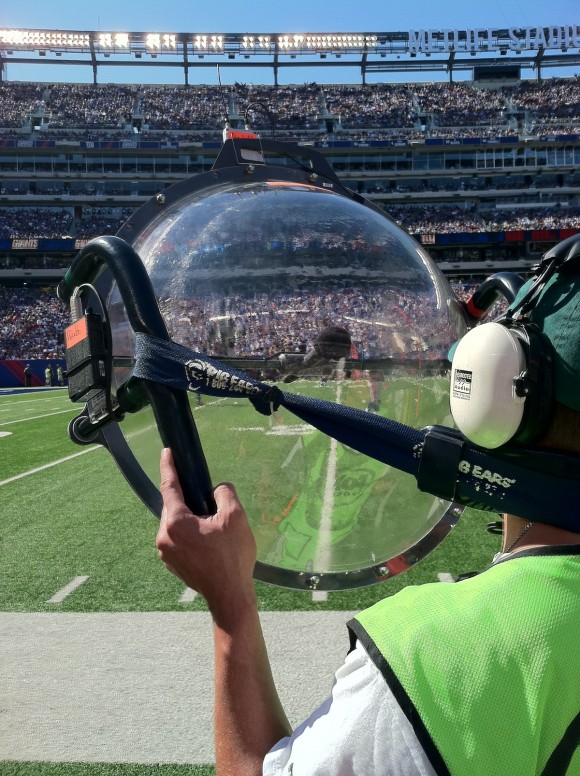 ”We ended up with the best dish on the planet.”
”We ended up with the best dish on the planet.”
It’s first practical application was at a San Diego Charger’s game at Jack Murphy Stadium. The parabolic was working; its design brought the sound of the action into the living room and intensified the viewer’s experience.
“Somewhere after the 4th play of the game, Chet Forte turned to me and said, can you turn down the sound of the quarterbacks, they’re too loud.” Jack humorously recalls.
Refinement of technology is difficult enough, but another of Jack’s biggest challenge came in 1986, at ABC’s coverage of the Belmont Stakes. Curt Goudy Jr., legendary sportscaster, led Jack down to the start gate and told him to listen to the sounds of the racetrack. Jack recounts, “Did you hear that? I never hear that on television, and I want to”.
Jack needed to capture the sounds, but had to make sure that what he did would not affect the race by spooking the horses. Since it didn’t exist, he had to create it. He built an audio harness of XLR cables that lead to each of the lavaliere mics that had been placed near the hinges on the gate and one by the bell. The cables were carefully hidden in the superstructure, connected to battery powered Shure mixers, sub-mixed, the output sent to a wireless microphone transmitter, eventually transmitting the signal to a receiver, which fed an input on the audio board.
“You would hear hinges creaking, horses whining, you would hear every single sound of the start gate. Never existed before.” Jack recounts with pride.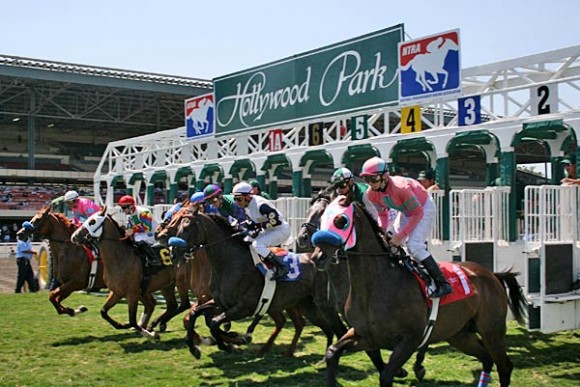
During ABC’s coverage of the National Figure Skating Championships, Curt Gowdy once again took Jack for a stroll, this time down to the ice. Gowdy pointed out the sounds of the skater’s blades scraping and cutting the ice. He wanted to hear that too.
Jack turned to a new technology called PZM’s, Pressure Zone Microphones that had been developed by Crown. They were too expensive so he took a walk to the neighborhood Radio Shack, and bought six of their inexpensive PZM’s. He then secured the mics to the rounded corner boards on the rink wall. Using the mics and the rink’s curved corners, he effectively recreated parabolic reflectors. Jack’s resourceful adaptations and innovation brought the sounds of the ice to the viewers at home.
“Around the second pair that came out, Curt asked for less ice noise, I was burying the announcers”. Jack laughs.
One of his greatest challenges had Presidential implications.
The NFL was to have President Ronal Reagan officiate the coin toss from the Oval Office at the White House for Super Bowl 19. President Reagan was to be heard by the officiators and the viewers, and he needed to hear the officials. It was imperative that this two-way communication went flawlessly. The fear of failure to do so in front of millions of viewers could not happen. The President’s image was not to be tarnished. So after one blown rehearsal and the rattled nerves of the White House people, Jack was asked to step in, and make it happen. And he did, flawlessly.
“That scared the life out of me!” Jack laughs, “That was a sleepless night.”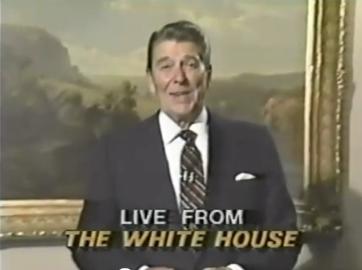
These are but a few of Jack Kestenbaum’s experiences and contributions. His presence and influence during the maturation and advancement of television lent to the experience we all enjoy today.
Jack experienced black and white, color, high definition and 3D television first hand, so what new technology does he see in our television future? While attending a recent 3D seminar, that included some of the technologies top experts, he caught a glimpse of what’s in store. When asked what’s next, one of the experts claimed that the technology exists, and that holographic television is the future and only 15 years away. Incredible to imagine, but then again at one time 3D also seemed impossible.
“You get a holographic projector, place it in the middle of your living room and it produces this holographic look of Yankee stadium. You can walk around it, sit behind home plate, be out there with the bleacher creatures, sit behind the dugout, you can move wherever you want to go because it’ll be 360 degrees, a complete holographic representation.”
The future is indeed within our grasps. Jack believes whole-heartedly in mentoring the young, because the future of broadcast lies in their hands. His four decades of experience lends to priceless, professional advice. Desire and willingness to learn are key elements in the advice he shares.
“Kids would say to me, how do you get into television? I would tell them very simply, I would take off the back and crawl into the set, that’s how I got into television. “
A simple enough question answered by priceless advice.
He also adds, “You have to pay your dues. You can’t have 10,15,20, 30 years of experience until you have 10,15,20,30 years, so don’t come in here and tell me you’re the best thing since sliced bread. You have to find something that floats your boat, you have to prepare yourself to do something rather specific.”
Success comes from hard work, but family is from where it grows.
During 11 years of Monday Night Football, Super Bowls 19, 20 and 25, Olympics, golf, horseracing, years where 220 days of which were spent on the road and kept him away from home, he was grateful that his wife was at home.
“My wife did a heck of a job raising my two kids.” Jack beams.
During all his years, all his experiences and stories, Jack recounts one that resonates deeply. One of his sons wanted to get into the TV business, so he asked him if he had any contacts he could reach out to.
“I said yeah, I got a couple, but you need to send me a resume, which he did, and the resume begins,
“I pride myself on being a second generation broadcast professional”. It almost brought me to tears.”
One short, sweet and meaningful phrase sums up a lifetime of achievement and hard work.
He stepped up to the plate, and got it done.
Operating the “TowerCam”
I’ve worked with tons of different cameras, lenses, mounts, robotics, jibs, dollies, just about anything related to capturing images, so when a new technology comes along, and I have the chance to work with it, I jump on the opportunity.
The director for ESPN soccer games, who I’ve worked with for years, wanted to add a different dimension to ESPN’s match coverage in the US. Most soccer matches here take place in football stadiums, where real estate is not a problem and there’s plenty of room for a jib, but in European stadiums, room is very limited, so the use of the Tower Cam is common.
The Tower Cam is a vertically, telescoping camera mount that rises and lowers via two operator-controlled foot pedals. It’s similar to the jibs’ up and down motion but without the arm’s sweeping range. But what it lacks in that department, it makes up in ease of set up, break down, smaller footprint and reliable, remote operation.
And when the towers’ movements are complimented by the robotic cameras’ zoom, tilt and pan, an extra dimension of composition is added.
The director was on the hook in making ESPN spend all this money to rent this new piece of technology. The tower cam guys were hoping ESPN would like it, and result in landing a juicy contract. There was a lot riding on this. The director wanted it to look good, the tower folks wanted to look good, I wanted to look good, it was absolutely nerve wrecking! This was my first time using it. I’ve done robotics for years, but never had to use my feet at the same time. And to add more fuel to the fire, I had to operate two of them, one behind each goal!
The Director went over what look he wanted to achieve. He was looking for a downward motion as the player taking the shot, approached the goal. He wanted the tower to telescope down, the camera to widen, so when the shot was taken, the camera would be right behind the goal, a similar shot you would get from a jib, but much more stable and controllable.
I sat down on a swiveling chair, the best way to spin between the foot pedals for each tower and robotic controls for each camera. The pedals control how high and how low the tower telescopes. Applying different levels of pressure to each pedal can control the rate of speed. The softer you push down, the slower it rises or lowers. I felt like the Wizard of Oz working his levers, spinning wheels. The whole thing was absolutely insane.
The game started, and I quickly got the hang of it. Controls were very responsive, and the hydraulic and pulley system ran very smoothly. Its hefty base made the whole structure extremely stable. Following the game action was no problem at all, I know the game pretty well and I know when the action is culminating into a shot-on-goal or when they’re about to rip one into the goal.
When the players are on the offensive, running towards me, they’re passing the ball back and forth, I have the camera up high, and as they get closer, about to take a shot, I bring the tower cam down so it’s now behind the goal net.
When the goalie had the ball and was about to kick it, I would do the opposite, start the camera low behind the goal, the goalie would be head to toe in my frame. As he ran to kick it, I would raise the camera and zoom out at a medium speed, showing not only the action of kicking the ball but the expanse growing as the ball sailed across the field. I would then spin in my chair and take control of the opposite tower cam, raising it high, and then lowering and zooming in as the action approached. This back and forth went on for the whole game, with only a break at halftime. That’s 90 total minutes of game play. Crazy, intense pressure!
All the extra movement in the scene, the up and down, the camera zooming in and out, it all looked really cool, and when you got the timing right, it was some amazing stuff. It added a whole new dimension to shot composition. It wasn’t just about keeping the subject in the frame; it was all this other action taking place around, and because of the subject.
Everyone seemed to be happy. It was important to me that this trial go off without a hitch. I wanted to save the directors ass, and do good for the company. That was a lot of responsibility on my shoulders, no wonder I was exhausted! But it was all well worth it.
_________________________________________________________________________________________________________________
Here are some pics I took during my time working with the TowerCam…
- The “Tower” of the the TowerCam
- Telescoping Motor
- TowerCam position at Red Bull Arena
- HD output of the camera
- Robotic Camera mount on TowerCam
- Robotic Camera pan and tilt motor
- TowerCam extension sleeves
- Telescoping Motor controls
- TowerCam fully extended
- Rick and his TowerCam
- Operating station: Pan, Tilt, Zoom, and Focus controls.
- Foot Pedals to operate the Tower up and down
- TowerCam software control interace
- Soccer and TowerCam debut at Yankee Stadium
One Kool Cat
Traditionally, a Ferro article is one part the person or persons and two parts their involvement or use of technology. This time we have sauntered to the other side of the room and stared through the “Looking Glass” to bare witness and pay homage to a classic Pop R&B sensation that is all about the artistic performance and less about the technology.
Their stage show is simple by todays standards. A small lighting console run by their tour manager. The sound is usually supplied by the house. There are no smoke or laser gimmicks. No digital multi-tracks dubbing vocals or instrument parts… Just a smoking hot horn section, a few electric guitars and bass. A ZON bass to be more precise. Then there is a keyboard player with a modest ensemble of keyboards, a few percussion instruments and a drummer. HOWEVER, when this band takes the stage, its like the opening ceremony at the Olympics. Its bigger than life and all VERY REAL. If you assumed that this level of talent would have a back story that is just as big as their performance, you would have assumed correctly. During the 3 months we were honored to have covered their tour and listened to hours of tales from the past we discovered their journey was just as intense as their love of performing.
If passion is a key to success, it looks like this band and Kool may be around for many more decades…
“The Giants had just won the Super Bowl, the Knicks were hot again, and there we were; Madison Square Garden. I’m talkin’ the Garden! New York City!” -Robert “Kool” Bell, Kool & the Gang.
In 1960, at the age of 10, Robert Bell moved from Youngstown, Ohio to Jersey City, NJ. At that time Robert wasn’t thinking about selling out Madison Square Garden. He wasn’t even thinking about being in a band. How could he? He was far more interested in staying safe on the streets and learning about his new home, the concrete jungle.
“I remember when we first moved to Jersey my Mother sent me to the store to get a loaf of bread. I got to the store and a guy walked right up to me and demanded that I give him all my money. I told him that my mom had given me this money to buy a loaf of bread. He just laughed, then took my money. It was right around this time when I realized that I wasn’t in Ohio anymore! I was either going to survive or be a victim out here.”
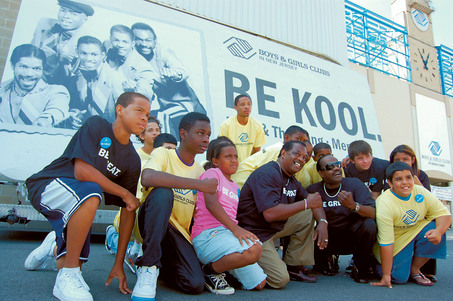
“Never forget your roots.” Robert “Kool” Bell gives back to the community at the Boys and Girls Club of Jersey City.
Not only did Robert survive; he thrived. Going under the alias of “Kool”, Mr. Bell quickly learned the ways of the Jersey City streets. Although Kool kept to the streets, he also had another passion; Music… and soon enough Mr. Bell would learn that this new passion of his might, and ultimately DID, one day bring him to the top of the world.
Kool, accompanied by his brother Kahlis Bell and a few local boys from Jersey City, began hanging out and jamming at talent shows and clubs in the area. After the boys gained some confidence and recognition, they made their way across the river to Cafe Wa in NYC’s Greenwich Village. Every Sunday there was a Hootenanny hosted at the cafe, and it was at one of these Hootenannies when Robert’s life would be changed forever.
“I used to fool around on my guitar with this song called “Coming Home Baby” by Herbie Man. I played the whole song on one string of my guitar. One night at Cafe Wa I decided I was going to play this extra bass guitar that was lying around, and play this “Coming Home Baby” song. It was easy, but it was good. That was the beginning of my career as a bass player.”
ZOOOOOOOM…. fast-forward to Robert’s senior year of High School…
“I didn’t do the whole school thing too much, but at least I finished. I remember telling my teachers that we were going on tour and that I was going to be a star. They all basically laughed in my face and said, ‘Good Luck.’ “
Two months later Kool & The Gang released their first record and landed themselves on the nation’s Top 40 list. The boys from Jersey City had successfully blended R&B, Motown, and Jazz all into one very Kool type of new music, and the people were loving it. The band got signed by Universal Records (then “Delight Records”) and began making a real name for themselves in New York and New Jersey, and they weren’t stopping there.
In 1979 Kool & The Gang had reached the pinnacle of the industry by receiving Platinum Certification for their album “Ladies Night.” Once again, they weren’t stopping there. Actually, they were accelerating! By 1984 they went on to release not one, not two, but three more platinum albums, including the 2x Platinum “Emergency” record, which also went Platinum in Canada. It was official: the “OTHER” boys from Jersey had gone international, in a big way.
Once the 1990’s rolled around, Kool & The Gang decided to expand their touring to all areas of the globe. Their songs had become so popular that Kool wanted to give back to ALL of the fans.
“Some artists only go to the big cities. You know, New York, Paris, Rome, places like that. I love those places, don’t get me wrong, but I wanted to go to Poland, and Germany, and Africa and I wanted to show the fans that they were appreciated. When you are younger, you read about places in history books and stuff, but when you go there and you experience it, that’s what music is all about. It’s about new cultures, new languages. There really is no better feeling than when you are rocking a show in Cuba and there are 200 thousand fans moving with you, rocking with you, appreciating what you do.”
Not only did the fans appreciate Kool & The Gang, perhaps even more so, they were appreciated at a much different level by their peers, musical artists around the world. The Gang has had HUNDREDS of their songs sampled over the past few decades by names such as LL Cool J, Jay-Z, Wu Tang Clan, Ice Cube, and P. Diddy… just to name a few! So from humble beginnings in Youngstown, Ohio to sold out stages in Berlin, Germany… Mr. Robert “Kool” Bell has seen it all and done it all, proving that ANYBODY can accomplish ANYTHING if they dream big enough and work hard enough.
“Whatever inspiration I had, I put it all into the music. You’ve got to have that certain energy, that certain something… that certain drive to make it big. By the time I was getting out of high school I knew that I was going to make it big and there was really nothing that was ever going to stop that.”
Thanks Kool! It’s always a pleasure, inspiration and adventure working with you. From all of us at Ferro, much love and respect…
Dennis Size: Lighting Design Group
Nearly impossible, it would be, to turn on your TV at any given time, on any given day, anywhere in the world and not bear witness to their brilliant designs, in all their glory illuminating your screen.
A wise man once said, “If you don’t have the proper lighting on a television set, you might as well just be on the radio.” Said wisdom from the mind and lifes work of Dennis Size, Senior Vice President of the Lighting Design Group.
The Lighting Design Group is the largest lighting company in the Entertainment Industry. The MAGNITUDE of that statement needs to be reiterated and expounded upon. The “LARGEST LIGHTING COMPANY IN THE ENTERTAINMENT INDUSTRY” written here not for effect, rather, to properly put into perspective the level of talent, professionalism, innovation and management skill, both artistic and “hands on” literally across the globe.
Ferro was priveledged to sit down with Dennis at LDG headquarters in Midtown Manhattan to discuss his journey to success in the often characterized, “wacky” world of show biz.
Mr. Size was born and raised in Scranton, Pennsylvania. His father owned a middle class bar in town, Dennis shares, “My parents wanted me to escape the blue collar life. I was supposed to become a doctor.” Similar to most children, young Dennis took his parents advice and set his focus on becoming a doctor. In the meantime, however, he was learning a whole lot about entertainment as he spent time hanging out in his fathers bar. In which, there was a big stage with lights, live music and dancing…
In addition, Dennis shared:
“There were a lot of carpenters and electricians that hung out in the bar. My father would have these guys bring me to work with them so that I could stay out of trouble. I got good at that stuff and my dad eventually wanted me to use those skills to make the bar nice; lighting the stage, strobe lights… stuff like that. So yeah, I got my start lighting the stage at my fathers middle class bar in Scranton, PA.”
As the years progressed Dennis found himself enrolled as a Pre-Med student at the University of Scranton. Still intrigued by the performing arts and entertainment, he joined the theatre program, which became a creative outlet to decompress himself a bit from the inevitable pressures brought on by his demanding major. By junior year of college Mr. Size had quite the revelation and made the switch from Pre-Med to a double major in English Literature and Communications. He simply couldn’t deny his love for entertainment any further. “It’s all about telling a story, entertainment is. Orson Wells didn’t know a thing about film, but he knew how to tell a story and that’s what I wanted to learn. I knew that the English major would teach me content and Communication major would teach me how to deliver it to the people.” And it was EXACTLY THAT revelation which propelled him forward and to the top!
Upon completion of his studies at Scranton, the ambitious college graduate attended Penn State University and earned his MFA in Scenery and Lighting Design. The knowledge and credentials earned at Penn State were undoubtedly invaluable for Dennis’ future, however, the network of people he associated with proved to be the stepping-stone that brought Mr. Size to the next level. He explains, “ My Lighting Design professor from Penn State called me and informed me about this summer relief program that was going on at ABC” he continued, “ When I went to ABC for my interview, it turns out one of the engineers that did lighting worked on one of my crews during grad school at Penn State. He put in the good word for me and the rest is history.”
***REMEMBER: It’s all about the network!***
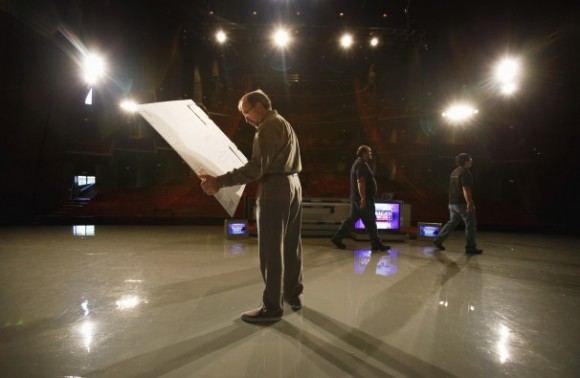
On-location at the 2012 Republican National Convention, this photo captures Mr. Size on stage preparing for the event.
The summer relief gig was a great success, seeing that Dennis was hired as full-time Lighting Designer for the Soap Opera “Ryans Hope.” Six years and an Emmy Award later (Yup, an EMMY), the twenty-nine year old moved on to other Soap’s such as “All My Children” and “One Life to Live.” And, soon enough Dennis said he, “ Wanted more experience, more challenge. So, I left the entertainment division of ABC and moved on to lighting design for Special Events.” The Special Events included the Olympics, Presidential Conventions, and the Emmy’s.
It seemed as though Dennis Size had reached the pinnacle of his career. Where does one go from this point in order to achieve elevated greatness and accomplishment? Well, following an outstanding lighting set-up at the Emmy Awards, Mr. Size found himself in Chicago, Illinois with the up-and-coming TV sensation, Oprah Winfrey. Mr. Size redid the lighting design for Oprah’s television studio in Chicago and also went on the road with the crew each and every time they went out for a special. This new “freelance” gig is the ultimate driving force that led Dennis to leave ABC; subsequently the same driving force brought him to the Lighting Design Group.
Currently , “ After forty years of doing it, I’m having fun. Doing shows, training young designers, it’s a blast. LDG is a very specialized company providing a very specialized service, and I’m loving every day of it.” Dennis Size has continued to elevate himself and conquer massive challenges in the industry, recently designing the lighting for the Republican National Convention. So now I ponder, what’s next for Dennis Size? History tells us: Dedication and outstanding performance. Dennis tells us: Educating the youth.
“I tell the kids to learn it all. You are not going to be a pro right out of school, so just forget that idea. The more skill sets you have, the better off you’ll be. I just caution them not to be the jack of all trades and not the master of any trades.”
That sage wisdom seems to be carried forward to LDG’s hiring process. They continue to assemble a team diverse in style and experience; each bringing his or her unique flair to the project. This diversity allows LDG to “design” or tailor a design group to fit the client and their needs perfectly. Whether it’s the massive live stage at the Emmy’s or a single news desk in Hyderabad, India… the LGD team is well prepared and probably already there.
Debate Debacle
|riˈdəndəntce|
I flew out to Colorado, to the University of Denver, as part of the ABC pool feed covering the 2012 Presidential Debate. We were the only unit covering the event, so our images were being transmitted out to the world. Our pool feed enabled ALL networks to take our images and use them whichever way they wanted, such as correspondents reporting live from the debate floor.
I was there to set up two remotely operated cameras, one of which I was going to operate. One was a MSE Bazooka telescoping camera mount, with a Sony HDC-P1 camera, and a Bradley Engineering Pan Bar System, gyro-stabilized, camera mount that can be operated remotely, via a monitor, using a standard, studio-configured pedestal.
Setup ran smoothly, we rehearsed the next day. Technically, everything checked out. All we had to do now was sit and wait for the debate to start.
We started broadcasting a live image an hour and a half before the actual debate began. Being the only source of coverage, anticipating any technical issues, many redundancies are built in. Extra cameras, back up power, switchers, just about any issues or scenarios are ready to be addressed. Needless to say, there is always that one unforeseen circumstance that can send the production into a tailspin. That one moment when good old Murphy rears his ugly head and instills his law.
Thirty minutes before the debate started, the transmission truck lost power. HD converters, distribution amplifiers, encoders, decoders were knocked off line. Basically, the signal coming out of the production truck was not being beamed out to the satellite or fiber. Networks in this country and all over the world were not receiving our images.
Engineers were quickly on it, trying to troubleshoot the problem and fix it. There was less than 30 minutes to fix the problem. The culprit was found. Apparently the loss of power was either due to a fried coupler, shorted connector or a bad cable. But due to the high level of security, the Secret Service had the whole place on lock-down. The transmission and satellite guys were trapped, they couldn’t do anything. Running out, fixing or replacing any of the faulty components was not an option.
The quick thinking of one individual saved the day. They suggested running a regular AC cable from a small production trailer’s 15 or 20 amp outlet out the window, across the parking lot and plugging it straight into the transmission trailer in order to power all the components necessary to transmit the signal out to the satellite, and in turn out to all of the networks.
The quick fix worked. The signal went out. The entire 90 minute Presidential Debate went off without a hitch. Good old Murphy and his inevitable law was rebuffed by the quick thinking of one individual.
Redundancy can give you peace of mind, but sometimes necessity and a good old orange power cable and power strip saves the day.
How the Film Industry has Evolved, Yet Will Never Change
The film industry has witnessed a number of transformations – from the invention of the motion-picture camera in 1888, to James Cameron’s groundbreaking visual effects used in Avatar in 2009. Although technology and equipment have changed over time, the great minds within the industry believe that the characteristics necessary for a successful career remain steadfast.
Alex Aurichio, an experienced director of photography, is an award winning cinematographer with over 30 years in the film and television industries. He has worked as a cameraman on a wide variety of projects, including news productions , reality television, and children’s T.V. shows. The straightforward nature of news reporting, the new structure of reality television, and the creative brainstorming and portrayal of the children’s T.V. show Pee Wee’s Playhouse provide Aurichio with an all-encompassing resume. 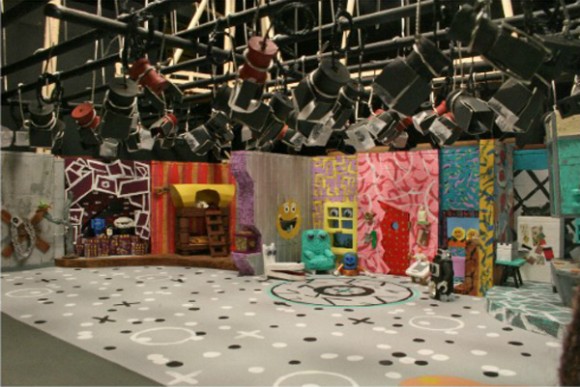
As a film major and animation minor at Pratt Institute, combined with his 30 years of industry experience, Mr. Aurichio has been able to flourish in both worlds effortlessly. Being part of the industry during a major technical renaissance has given Alex a great appreciation for both the past and future.
“Back when I was in school (in the ‘70s) you had to do everything manually… it’s good to have those skills because everything is so automatic today and anybody can pretty much turn on a camera and get a decent image,” says Aurichio.
What exactly had to be done manually? Alex worked as an Assistant Cameraman throughout his career. Typically Assistant Cameramen – known just as an AC – would have to build the camera, load it (with actual film), and measure the distance between the talent and the camera in order to be able to judge by eye that someone was in focus or not. These primitive duties were tedious but forced the operators to have an in-depth appreciation of the camera’s abilities and limitations. “Building” a camera is no longer necessary because tapes and memory cards – for the most part – have surpassed the use of film, and the focus can now be adjusted by the camera without te need to measure distances. The digital era has pushed these primitive, yet valuable techniques aside.
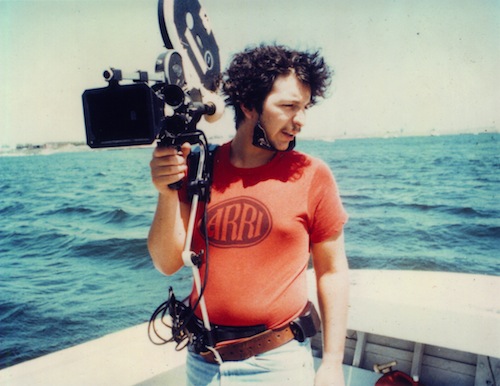 In case you were wondering, yes, film cameras actually had to be “built”, as Aurichio described it. When an assistant cameraman would go checkout a camera, before he/she took it out of the store, everything from the lenses, extensions, tripod, etc. had to be put together and examined for quality. Also, the AC would have to test the viewfinders and the tape magazines to avoid focus or film feeding malfunctions during a shoot. If one camera part was unserviceable, the whole shoot could potentially be a disaster.
In case you were wondering, yes, film cameras actually had to be “built”, as Aurichio described it. When an assistant cameraman would go checkout a camera, before he/she took it out of the store, everything from the lenses, extensions, tripod, etc. had to be put together and examined for quality. Also, the AC would have to test the viewfinders and the tape magazines to avoid focus or film feeding malfunctions during a shoot. If one camera part was unserviceable, the whole shoot could potentially be a disaster.
“You want to check all that stuff before you actually get on the set … you don’t want to hear ‘Why doesn’t this work? Why doesn’t that work? … you just always want to be there for your cameraman and be their best buddy and mom and dad,” said a laughing Aurichio.
But now that the technology in the film industry has drastically changed, Aurichio believes one of the reasons there is a lot less visually interesting programming is because the digital age has made cameras so much easier to operate – deluding the “Art” of camera operation. We now rely less on the artistic eye of the operator and more on the automation of the camera. This simplification of technology has given rise to the advent of reality TV, which has spurned the traditional dramatic and narrative structures of storytelling on television.
According to Aurichio, the growth in technology has facilitated this new wave of reality television because it has enabled greater accessibility to the modern, less expensive equipment at a and needs less qualified / cheaper operators. With more people able to use the equipment, more people are ultimately granted greater entry into the business. But quantity does not insinuate quality.
“The shift from film to video, in a sense, has dumbed-down production … I’m talking more about the ideas and projects … a lot of people can pitch ideas and if you’re a good salesman you can get [your idea] made, but it doesn’t necessarily mean it’s of high value,” he said candidly.
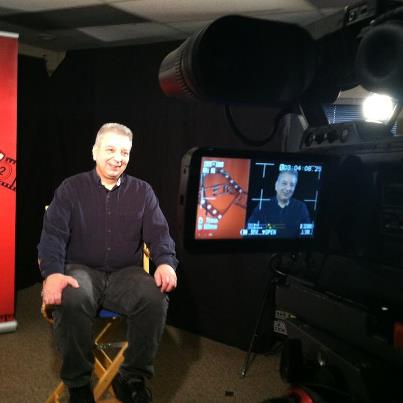
Despite the prevalence of the undesirable reality shows, there are still quality television shows out there, which should motivate young people breaking into the business. Aurichio believes it was crucial that he has sustained his best assets throughout the years, allowing him to endure a long and successful career.
Assets such as being able to adapt to change, being able to perform various jobs, while still focusing on the main goal of becoming a cinematographer and maintaining his artistry and creativity, has defined Aurichio’s success. He hopes that he can help young students and novices to preserve their passions and develop their creativity to help better the industry.
“No matter how the technology changes, try and keep those same values and creative processes. The technology might change, but our creative processes do not,” Aurichio said confidently.
One can be tremendously creative, but the passion mustn’t be dormant or else it will be difficult to achieve success. The film business doesn’t leave its subjects with a lot of free time; it requires long hours of tedious work often at grueling pace. However, this should not discourage anyone from pursuing such a career because it gets much easier as you develop more relationships.
“Learn how to deal with people, whether they are above you or below you and learn how to treat them well. You have to be a people person in order to further your career in this business,” Aurichio expressed. “Because it’s not always what you know, it’s sometimes who you know.”
But be sure to make the right impression, because nobody wants to deal with a reality TV drama queen.
HBO RINGSIDE
“Boxing is fighting. It’s life and death; people have literally been killed in the ring. It’s different from other sports because the athletes aren’t thinking about moving on to the next series, or the next championship. Rather, they are thinking about how to knock their opponent on to the ground, and make him stay there. This is serious stuff.” – Rick Cypher, HBO Boxing Camera Operator.
There’s nothing quite like the entertainment of watching two heavyweight boxers brutally bash in each other’s faces until one of them can no longer stand. A tad bit vulgar? Yes. But, one simply could not deny the fact that, through out the ages, the masses have always gathered to view these sort of “life and death” battles. Think about it: The bloody combat of the Roman Colosseum, the outrageously dangerous Jousting matches of the Middle Ages, and more currently, Ultimate Fighting and Boxing. Although Boxing may not be as intense as Colosseum battles or Jousting matches, it seems to be the closest parallel we have to it in our modern society.
For the past twenty years, Rick Cypher has been providing this hand-to-hand, up-close and personal entertainment to millions of HBO viewers around the world. Acting as a Camera Operator, Mr. Cypher has the unique (and monumental) responsibility of allowing television viewers to feel like they are in the ring with the fighters, even though they are in the comfort of their own home.
“The best is when people tell me they never watch boxing, but they watched the match because they knew I was shooting camera, and they say that they were floored with genuine emotion and really couldn’t help but feel like they were right there in the ring,” shares Rick.
For HBO to deliver such brilliant broadcasts time after time, decade after decade, it takes a group of very talented and experienced cameramen. Five (including Rick) to be exact… Two main cameras (set-up on tri-pods) are each responsible for covering both fighters in the ring at all times. One shoots both boxers head to toe in his frame, and the other follows the boxers from head to waist. There is one 90 Degree camera set up on the opposite side to get shots in the corners where the two main cameras cannot see. “The 90 Degree camera also provides great shots for television replays,” shares Rick.
Finally, there are two handheld cameras being operated on the apron. The apron refers to the small two foot area of the ring that lies outside of the ropes. Due to the close proximity to the fighters, these cameras provide viewers with in-your-face action of the fights, but also happen to be highly dangerous for the camera operators. Mr. Cypher explains that shooting the handheld apron camera is his favorite because, “I’m right there! I can hear the corner people (trainers, friends, family) yelling. I can literally see the emotions of the fighters. It’s pretty intense.”
IN FACT… Mr. Cypher knows first hand the dangers of shooting the apron camera…
During our interview, Rick shared with us his experience of nearly getting knocked off of the apron during an event. ” I was shooting from the apron and one of the fighters came over and leaned into the rope. Then, the other guy came and leaned up against him. At this point there was 500 LBS pushing up against the ropes, I knew that I wasn’t positioned correctly, and in a split second decision I determined I needed to jump off of the apron.”
Fortunately, Rick did not suffer any injuries or damage to his camera….
It’s certainly not everyday that you see members of the TV production crew putting their bodies in harms way in the field of play at a sporting event, which brings me back to an earlier topic. Why would a cameraman willingly stand on the edge of a boxing ring to capture the fight, when he is literally one missed hook away from getting knocked in the face? And further more, how could he possibly enjoy it so much?! Well, perhaps the answer lies in the fact that Boxing, like Medieval Jousting and Roman Death Matches, provide for the best sort of entertainment… and after all, Mr. Cypher is a seasoned veteran in the Entertainment Industry.
Shooting a news show pilot for Chinese TV
I was recently hired to D.P. a pilot for the Chinese network, CCTV. It’s a news program call “I Cheng”, starring reporter Gloria Cheng Ai. The show is mostly interviews with politicians, economists and world leaders. There are also stand ups with Gloria, as well as ‘man on the street’ interviews and a lot of B-roll. Locations included the JFK school of government at Harvard University in Cambridge MA, Columbia University in NYC, as well as numerous offices and hotels around Manhattan.
The really challenging part of this shoot was the amount of locations that we had each day, and how little time we had between them. Luckily I had a second camera operator to help with set up and break down. This also allowed me to send out that operator to grab B-roll beauty shots of the city, while I concentrated on stand ups and man on the street interviews with the main talent. For the first day’s shoot at Harvard, I used Two Diva lights as keys, combined with natural daylight from a window, and a third Diva as fill for both subjects. We used two Sony AG-HPX500P cameras, and I can’t say enough good things about this camera. Because it uses P2 memory cards instead of disc or tape, there are no moving parts to drain the battery rapidly. As a result, we were able to shoot for almost the entire day on one brick battery. It also has 4 P2 slots that accommodate 32 Gig memory cards, because we were using PAL 4:3 HD format, this came in very handy and gave us hours of recording capacity.
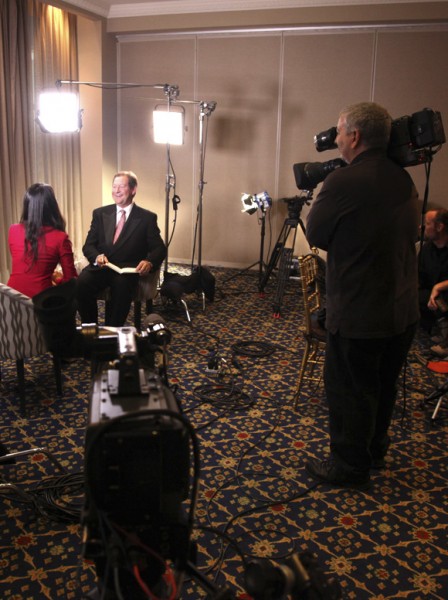
Our 2 person interview set up with 2 cameras, 4 1×1 LED lights, and some fresnels for background accents.
After seeing how tight our time constraints were the first day, I opted to go with four 1’x1′ LED Litepanels® instead of the Divas. This allowed me to quickly set up and vary the color temperature without having to swap bulbs. I kept an Arri tungsten kit with me that had two 650 and two 300 watt fresnels. This came in handy for background lighting when needed. The Litepanels® are so lightweight and easy to set up, plus they stay cool, which is a big advantage in small spaces where heat build up can be a big issue. All the sit down interviews were shot with two cameras, and because the Director wanted a very shallow focus look, we were usually wide open with heavy ND filter selected. My main concern was keeping the lighting flattering for Gloria and her background soft in the close ups.
One of the other challenges on this job was working with a young Chinese director, who is a student at New York Film Academy, and barely speaks English. Fortunately we had an interpreter and Gloria speaks English fluently, so this was just a minor inconvenience which was easily overcome. The job lasted for six days, and by mid week, we understood each other and worked together quite well. In the coming months, Reuters will be building them a studio in NYC and we have already discussed the possibility of me coming in to L.D. the studio portion of it as well. All in all, it was a great experience and we produced a great looking pilot that will hopefully become a long running series in China.
THE GIANTS “BEAT”
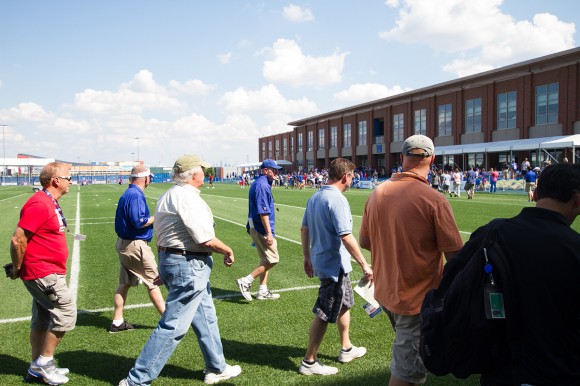
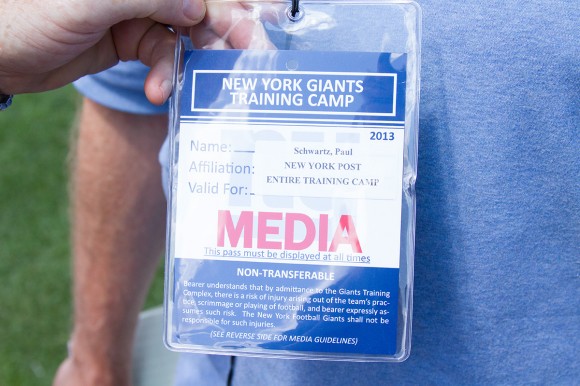 If your going to cover something, yours better be the best of the coverage coming from the crowd OR what you’ve “covered” best be from such a different, yet related angle, that the reader’s silent thoughts are “WOW – he’s good! What a take on that storyline!!!”
If your going to cover something, yours better be the best of the coverage coming from the crowd OR what you’ve “covered” best be from such a different, yet related angle, that the reader’s silent thoughts are “WOW – he’s good! What a take on that storyline!!!”- How to identify key issues and sources on his beat
- How to get background information that will give his stories context
- How to develop resources to focus his coverage
- The value and inner workings of social media, liveblogging and crowdsourcing as reporting tools
The New Age of Sports Reporting
This new age of digital media has been both educational and expansive for individual writers, and feel free to roll those descriptors up to the outlets that provide both print and online news sources. Just ask Ohm Youngmisuk – also known as @NotoriousOHM on Twitter – a prominent writer for ESPN New York who has covered the New York Giants and Jets for years and is now back on the NBA beat. We at #FerroBTS did just that…. We wanted to hear firsthand what life was like on the front lines of this New Age Media.
“It’s changed a lot,” he said. “Now you almost can’t take a breather without having to be online and monitoring Twitter.” This has affected Mr. Youngmisuk, especially during the NFL free agency period, where he was incessantly checking his Twitter feed for updates to either make sure he wasn’t repeating news or that somebody else didn’t break a story that he was after.
He believes that a career in journalism/reporting has changed because if a writer wants to stay relevant, he/she must be using social media to keep up with the latest news. “Back in the day if you got scooped, you’d wake up and read about it the next day. Now today, you’re scooped for a minute, and then you’re following it on Twitter,” he said.
Social media is just the beginning of this new and evolving digital media upswing. Not only does Mr. Youngmisuk quite effectively write and report while updating his Twitter account, he also compiles his own blog, produces his own videos (with proper lighting and audio), and hosts web chats. To bring the best and most in depth coverage in a plethora of formats, Ohm shoots his own video, edits it, and delivers a coherent report that’s arguably second to none. “An ESPN producer once told me that I do the job of three people,” said Ohm. “Because [on a typical day during the season] after I do my video, shoot different takes inside the field house, and do a field pass with different backgrounds, I have to come back and write.”
The nature of the business has changed in such a way because the speed and depth of which information travels, has never been faster. News outlets, specifically sporting news outlets such as ESPN, need to turn around their information to the public as quickly as they can. ESPN represents the highest level of sports journalism and reporting, which is why they want to provide their readers with fast, yet comprehensive insight and analysis. Nowadays everybody is blogging or involved in some sort of social media, whether it’s Facebook, Twitter, Instagram, Pinterest, etc., creating a higher demand for outlets to reach their readers in a more timely fashion, especially effectively and economically. “There are a lot of people out there now; bloggers, newspaper guys, television guys, computer guys … there are a lot of things you have to do now, and it’s a lot for one guy, but you end up having to do it,” said Mr. Youngmisuk.
There are so many types of people who specialize in certain fields, and it isn’t cost-effective to hire a video guy, an audio guy, a lighting guy, and a writer to compile a 20-second video on, say, Victor Cruz’s injury update. Writers like Ohm are beginning to grow, or have grown, into this all-encompassing and worldly position where a little bit of everything is incorporated into their daily tasks.
The question remains: Is this making it harder for newer writers to break into the scene?
Ohm doesn’t think so. He believes the higher competition just takes a little extra effort to make oneself versatile and distinctive, which is attainable for any writer that has passion. And Ohm can sympathize because when he was growing up there wasn’t any of this technology and demand for such prerequisites. “If you’re applying for a job, one of the editors will say, ‘I want to see your blog.’ And you should have a blog because they will ask you what’s on it and how it differentiates you from everybody else,” he said. So start a blog. Make some vine videos. Tweet something of substance. Host a podcast. Because now all of these things will contribute to your portfolio, and more importantly, your future.
Digital and Social Media Directing
Standing over “center” of the digital services department of the New York Giants, similar to Eli Manning when he’s calling the shots at his position, is Nilay Shah, the Director of Digital and Social Media Strategy for the Giants’ organization. Whereas Eli has oversight of the New York Giants’ offense and primarily administers the running backs, wide receivers and offensive line, Nilay has oversight of the New York Giants’ digital line. This includes their website (Giants.com), mobile app development, email marketing, and Facebook, Twitter and Instagram feeds.
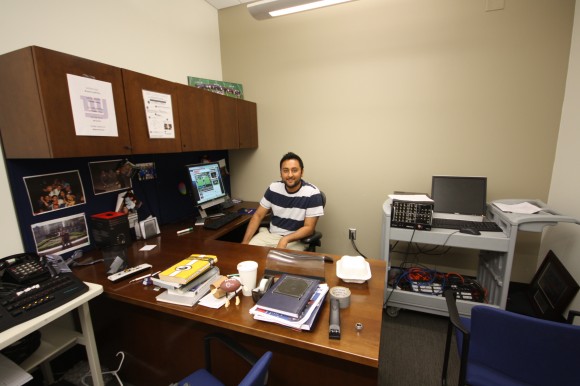
Mr. Shah’s office, better known as the New York Football Giants Digital and Social Media Headquarters.
The New York Giants “old school” sentiment is epitomized by building their team through the draft, which is how Nilay emerged as a star on the marketing side of the organization. Nilay began as a web intern in the organization in 2004 while attending the
New Jersey Institute of Technology and with his talents recognized early by the NY Giants, he was hired full-time in 2007. And now, witness to two New York Giants Super Bowl victories, Mr. Shah has had the pleasure of using his unparalleled creativity on the big stage. The Giants haven’t had this much exposure at the forefront of the NFL since their 1986 and 1990 seasons in which they were Super Bowl champions both of those years, which, oddly enough, were both separated by four years just like the victories in 2007 and 2011.
Coupled with the legendary status of the organization, the social media programs and trends have rapidly emerged in recent years and contributed to this explosion. More and more people, specifically fans, want to feel actively involved in their respective team because of the access social media has granted its users. With the click of a button, a picture on Instagram can make the fans feel like they are on the field, and with a mention on Twitter a loyal fan can feel directly involved in the conversation. And that’s exactly the goal of the Giants organization, which is masterfully orchestrated and executed by Mr. Shah.
“At the end of the day, our main purpose as an organization is to make our fans feel a part of the organization, so from a digital perspective we try to get all of the information out to them,” said Nilay.
These methods of disseminating information include the use of social media, the operation of the Giants website, and mobile app developments. Each of these avenues has proven phenomenally successful in recent years. The New York Giants mobile app was launched only a year and a half ago and it already has 500,000 active users. The New York Giants social media campaign has been arguably unrivaled in its creativity and originality. Communication to fans whether it’s through emails, news on the websites, photos on social media, or updates on the mobile app has never been more efficient. And this is all a direct reflection on Nilay’s and the Giants’ deep personal consideration for the fans.
“The year of the lockout we thought, ‘What can we do for the fans? They’re left out,’” said Mr. Shah. And for the first time in the history New York Football Giants’ organization, the fans (images of them) were put on the tickets for the regular season games. Nilay and his team got over 10,000 people to enter the contest to be put on the tickets. These fans submitted stories and photos, but only a handful of them were able to bask in the glory of being printed on a New York Giants game ticket. And for those that didn’t win the contest? They received a 25% off coupon to the Giants online store. This accomplishment wasn’t the first groundbreaking media-related success for Nilay and the Giants organization.
They were also the first NFL team to integrate Twitter in-game broadcasts. It was made possible thanks to Nilay’s wife! One night when they were watching the television show ‘The Voice’ he saw her tweeting into the show and thought it was an interesting idea. So as soon as he could get it done, he found a company that did live tweeting and it is now another fundamental part for how the organization communicates with its fans. Nilay continued his dynamic mission of trying to become the “first” in the NFL for using various methods of communications.
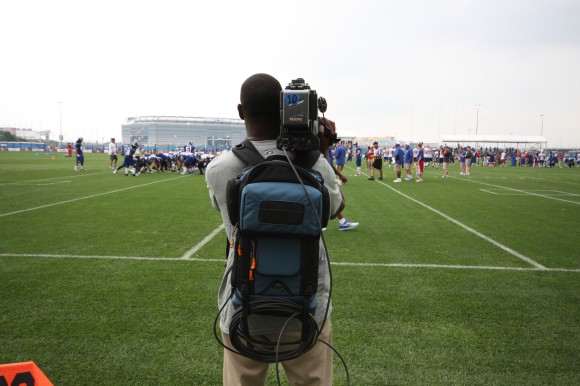
Thanks to Nilay Shah and New York Giants Broadcast Department, the fans can view practice live!
The next innovative social media tactic came during one summer at New York Giants training camp. After realizing that the attention span of social media users was getting shorter and short, the play-by-play breakdown was shifted to tweets. Every time a highlight play occurred, or a play that involved a significant player or outcome, a tweet was sent to inform the @Giants followers. Then Mr.Shah thought, “Yeah, it’s good to read about a play, but wouldn’t it be great to see it?” So the Giants Entertainment team contacted a company named “SnappyTV” who worked with the NCAA to broadcast the best plays for each game. It was previously difficult because it took almost an hour after training camp ended to get the clips of the plays out on the website. Nilay didn’t think that the process was as effective as it could have been due to the high-demand for timeliness on social media. “SnappyTV” was able to help Nilay and his team stream practice live, where they can clip in and out the best plays. “We get that up seconds after it happens, “said Mr. Shah. “The great thing about this is we can use it with social media and link it to Facebook, Twitter, Instagram, etc.” Ever since employing this new system, the Giants have seen over 700,000 views on the clips.
AND Nilay Shah didn’t stop there! He wanted to make fans feel involved on a whole new level. He knew how much the fans meant to the team and vice versa, so after the Giants’ last Super Bowl Victory following the 2011 regular season, he consulted the team’s management and pitched the idea of using augmented reality to give the fans something special. “When I presented the idea about the virtual Super Bowl rings, there was a little bit of a concern about the exclusivity of the rings,” Mr. Shah recalled. But the main goal of the organization is to make the fans feel as involved as possible.” The new initiative saw immediate success when over 50,000 fans took pictures with the virtual rings in a two-week span. “We’ve been lucky. When management sees a good idea and it’s fan facing, they’re all about it,” he said.
The social media campaign is continuing to find ways to make their tactics more creative, timely, and involving. All of the information and content regarding the organization is pushed out through the website, all the while, Nilay and his team need to make sure the information is compatible across all platforms, whether it’s a tablet, iPad, SmartPhone, etc. And as mentioned before, the attention span of social media users is getting shorter and shorter, so Nilay and his team need to constantly display the information in different ways depending on the platform it’s sent out on. “We have a separate RSS feed for our mobile content, which is a shorter form so it’s easier to read on your phone,” he said. All in all, the social media initiatives, mobile apps, and new website developments are catered to the fans because their loyalty is an important catalyst for the success of the New York Giants organization. And just like Eli Manning, Nilay Shah enjoys buckling down during crunch-time situations and delivering to the fans what they deserve. Play after play, game after game, and from one season to the next.
Well done Nilay and company!!!
Up-and-Coming: Matt Swensen
One of the most integral components of the human race that has enabled our species to evolve over the course of time is that innate ability to design. The fact that humans can develop a concept out of thin air and then transform that figment of imagination into a physically existing object is simply phenomenal. Fast forward yourselves from the idea of cavemen designing tools for hunting or scientists designing aircrafts to transport humans into outer space… and bring yourself to the present day. In this featured article Ferro Productions is going to dive into the world of Graphic Design by sharing with you the story of our own in-house designer, Matt Swensen.
“Graphic design is everywhere I look. On food labels, television commercials, magazines, clothing, websites, coffee mugs… everywhere. Everything you see started out as an idea. It’s my job to transform those ideas into reality.”- MS
Matt Swensen is a twenty-three year old designer from northern New Jersey. Please don’t let the age fool you, for Matt has been waist deep in the industry since he was a teenager. At the age of sixteen Matt spent a lot of time hanging out with his friends that were members of a local band. Mr. Swensen would occasionally capture photo and video for the band and as he shares, “That’s where I really started to figure out I was interested in production.” Matt’s newfound interest in production along with his already keen fascination with computers proved to be the perfect ingredients for this young man to get started in the industry.
A member of the local band was making t-shirts, flyers, and bumper stickers to sell at shows… This caught Swensen’s attention. Although Matt considered himself a horrible artist, he was fascinated with this new fad that his friend was involved in. Swen immediately installed PhotoShop on his father’s PC Laptop and began exploring. “I remember sitting on that old laptop and just typing in ‘Cool PhotoShop tutorials’ on Google. After that I would spend hours upon hours going through these tutorials and literally teaching myself how to use the program. It was honestly fun, except for the fact that I spent a lot of time staring at the progress bar waiting for stuff to load.”
By 2007, at the age of 17, Matt got his first Mac Book and no longer was he spending hours staring at the progress bar on his father’s PC. The senior in high school was cutting skateboard and music videos on Final Cut Pro and learning the basics of graphic design on PhotoShop. A kid who once considered himself a horrible artist was now discovering that he could use his creativity and intelligence to portray art… on a computer.
When it came time to graduate school, Matt was stuck at a crossroads. “All of my friends were going off to big Universities but I really wasn’t into that. I didn’t like being forced down the standard road that everyone else was so content with. I decided I was going to try my own thing and teach myself everything I needed to know. If it didn’t work then I would settle and go back to the way everyone else does things.”
A classmate of Mr. Swensen’s caught wind of his experience with Final Cut and PhotoShop and hooked him up with an interview for the New York Giants Broadcasting Crew. The eighteen year old made quite the impression at his interview, as he was offered a position immediately. Matt’s first week on the job was nothing short of overwhelming. “My boss gave me a laptop with an After Effects project opened and said ‘We need this by the end of the week.’ I went from making band flyers that 10 people saw to designing motion graphics for network TV, overnight.”
Where many would have folded, the determined new Graphics Designer spent the whole week on the internet watching video tutorials for After Effects. Needless to say he got the job done and the rest is history. Matt now finds himself approaching his sixth season with NYG Broadcast, working as the head of the Graphics department. His day-to-day work is featured on all of the Giants network TV shows, as well as on the big screens at MetLife stadium on game day.
During our interview with Swensen he reveiled his inside opinion on what it takes to make it in the industry. You may begin to notice a reoccurring theme with the insider tips given by all of our interviewees. To all aspiring graphics designers and to all aspiring to do ANYTHING in the industry, Matt says, “You need to realize that this takes an insane amount of time. I wasn’t good at this stuff for a while but I truly have a dying passion for it. I don’t know why, I just do. It took sleepless nights and failure to get where I am right now but I have this burning desire in my chest to never stop learning and never stop creating… I think that’s what separates me from the majority of people my age.”
The Art Behind Production
A wise man once said, ” If you don’t have a passion for it, don’t even try, because it will just break your heart.”
The “wise man” – Art McLaughlin. The “it” – the wild world of production. For almost 40 years, Mr. McLaughlin has been a pioneering member in the business, notably, and feel free to extend “notably” to just about ALL of Art’s career. This time for his contributions to the show Golden Boys, which has been on the road since 1985. Ferro Productions had the privilege of catching up with Art for an in-depth interview on his expansive career.
Golden Boys features three of the 1950′s and 1960’s greatest music sensations: Frankie Avalon, Fabian, and Bobby Rydell. BONUS MATERIAL: for those aficionados of the era(s), it comes as no surprise that all 3 singers hail from South Philadelphia. Rydell and Avalon used to do shows together for USO’s and Vets hospitals before they were even teenagers. Fabian lived on 11thStreet, a ½ a block away from Rydell, yet they never really meet until they were each stars outside of an occasional game of pool or hoops at a place called the South Philadelphia Boys Club.
The show has toured around the world since 1985, under the direction of Art McLaughlin, thousands of successful performances have been masterfully produced showcasing each of the three performers and their most popular hits. In the past, the group performed over 100 shows per year, bringing on thrilled crowds of all shapes and sizes. Nowadays, by choice and their golf schedule, they select a few dates every year to perform, making it all the more worthwhile to the fans. So… what is Mr. McLaughlin’s role in all of this? To put it simply: A LOT. ”On Golden Boys I am the Tour Manager, the Production Manager, the Road Manager, the Lighting Director, the Front of House guy, and I’m the Video Director,” Art shares with us modestly as if one key role wasn’t enough!
WOW! We were intrigued, and although familiar with the different role’s Art named, the fact that it was soley he who fulfilled them, simply lead us to wanting to know more. We wanted to know EXACTLY what his responsibilities were for as many titles as were named. So her we go…
Art as Tour Manager- ”I am responsible for all the logistics to make sure that people get where they need to get. To make sure that we have the right crew, to make sure we have the right travel plans, to make sure that the artists are comfortable… just to make sure that things are kind of going along the way they are supposed to. Dealing with the building, with any corporate people, any tech people, and then the artists themselves.”
Art as Production Manager- “I’m responsible for getting whatever technical gear is needed and dealing with local crew and the unions, and basically for building the show from the time you open the door until rehearsal is over. Once the show starts the production managers job is done until the show is over.”
Art as Road Manager- ”Well, a road manager basically deals with talent, deals with the artist, deals with the band. I make sure they get to rehearsal on time… make sure the artists are comfortable. What they eat, if they want something to drink, what time are they actually coming for sound check? Is there a hotel room for them when they get into town? Does the bus driver have a runner to take him back? So, the road manager just keeps the schedule going. It would be like an executive assistant at a corporate job.”
Multi-tasking at its finest…
Growing up in Kearny, New Jersey, Mr. McLaughlin never thought his career path would be as such. Often times when one is starting out, what they envision to be turns out to be something completely different and more exciting than anyone would ever imagine. And so it was for Art. Specifically, in this industry, no one ever ends up where they started. Like many others in the production industry, Art began as a musician. In the early days he performed at local bars and clubs: six sets a night, for six nights a week, at a rate of $50 dollars a night. After attending the Manhattan School of Music, Mr. McLaughlin got his foot in the door of the production business, working as a music director. When Art decided that he didn’t like the way the show was produced, he took the initiative to start up his own production company and do the things the way he believed they should be done.
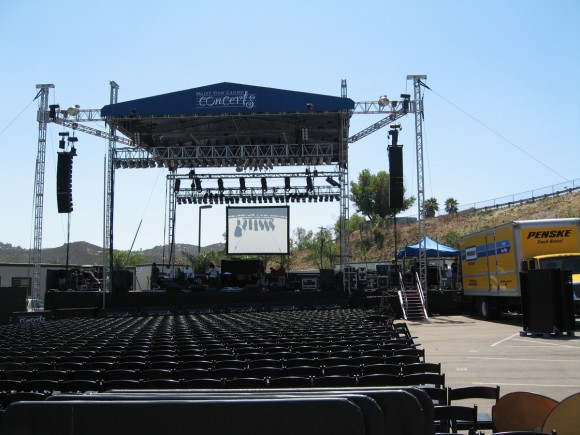
After a long day of setting up, these seats will soon be filled with cheering fans, thanks to Mr. McLaughlin
In the early stages of his company’s development, Art knew he needed to do things that would set him apart from all of the other production companies that were already out there. He did EVERYTHING the right way. He had the best equipment and produced the best product possible, all for minimal money. ”I did everything the right way, and any money I made, I reinvested in my company because I felt that in the long run I would be able to built a successful business, and that’s what happened,” said Mr. McLaughlin.
Art’s impressive career has taken him all over the world. Venues like Caesars Palace Las Vegas, Universal Amphitheatre Los Angeles, Carnegie Hall, and Madison Square Garden, just to name a few. He insists that all of his accomplishments can be accredited to the passion he has for the industry, and also to the fact that he has a ton of fun doing what he does so well. After all of the years and all of the performances, we had to ask Mr. McLaughlin if he still got the same rush from it all…He replied, “Absolutely. There’s nothing like having ten or twelve thousand people stand up at the end of a show to cheer for the artist and I know that I had something to do with that.”
And that’s a quote from an industry legend who’s been there, done that and has a very unique perspective on the history of the/our entertainment business. We thank you Art for sharing some of the most amazing behind the scene stories from your doing the last show at the Desert Inn, Las Vegas to being a part of the roving Diplomatic Corps to all the legendary venues of America, making sure the show DOES GO ON!!!!
Behind the Lens: US Open
NEW YORK – The US Open, not just a tennis match in Queens, rather a place for the elite to meet. With over forty countries represented in the tournament, each will have network broadcasts covering the event. It will come as no surprise saying that to capture an accurate portrait of the most elite players in the world, will take the talents of the most elite cameramen in the world. And in Queens, New York, at the “Open”, is where that combination of talent can be found yearly, creating magic during the late days of August.
Rick Cypher a long-time camera operator for Ferro Productions, has applied his craft for over 10 years shooting the US Open. Rick began covering the event for ESPN International in 1990 followed by several years at ESPN while continuing on to the USA Network and is currently with CBS, providing vital camera coverage today for the Open.
Arriving on location two days before the Open begins, Rick has to build his camera station and get situated. Crews have already been in Queens for two weeks wiring the stadiums and going over logistics as a roadie would in prep for the headliner. Our headliner is Cypher, who continues to set up his camera on the pedestal dolly and a quick two days are here and gone, it is tournament time! Let the WORK and GAMES begin.
A typical workday for Cypher begins at 8 AM and ends around 11 PM. Rick arrives at the stadium early, and goes through a fax check with the rest of the CBS crew. At this time everyone involved in the production is testing their equipment to insure there are no problems. The Technical Director checks in with each member of the crew determining whether or not everything is working properly. After the fax check, around 11 AM, it’s match time. Rick and camera are stationed on the playing court, slightly to the left side of the net, not a bad seat to enjoy the match, if it wasn’t WORK! His responsibility is to cover the player on his side of the court. Rick tells us “Whoever is on my side of the net, I cover exclusively.”
So who’s covering the other ½ of the court and the rest of the event? There are two other camera operators on the court with Rick along with three more operators located in the upper level of the arena. Six total. These six men have the awesome responsibility of capturing EVERY angle of the match to be delivered to the millions of viewers worldwide. “Anything can happen to anyone at any time, and I have to be 110% aware of that. If I miss a shot on my camera, the whole world misses that shot on television.” Rick shares.
With such extreme responsibility, the cameramen need to be at the top of their game and focused at all times. Given the high levels of pressure to perform, with the late August humidity, it’s tough to continue operating at such a high level for an extended period of time which is a testament to the professionalism and greatness of the chosen 6 cameramen. This is why every few hours there’s a substitute sent to relieve Rick of his duties for a forty-five minute break. “Before a match I need to make sure my camera is perfectly balanced and comfortable, because it is a long day, and if I’m not comfortable, it simply won’t work.”
Along with battling the long days heat of August, Rick faces other challenges covering the event. The viewfinder on his camera is very unique. Unique in the sense that what it displays is much different than what one would see on television. How so? When Rick looks through the lens, he is not seeing what the viewers are seeing at home, he’s seeing it all in black and white. We asked Rick why? His response “ Color doesn’t work because you lose contrast between the subjects. With black and white, you will see gray contrast.”
Additionally, his screen has peeking horizontal and vertical details, to help him achieve the greatest focus. “If you looked at my
viewfinder it would be unacceptable for television, but that is why I’m behind the camera, and you are behind the remote!”
At one of the largest sporting venues and events in the world, it is simply business as usual for Rick Cypher. Two straight weeks of fifteen-hour workdays, monumental responsibilities, and harsh weather conditions, all are no match for Rick’s passion and desire to operate camera. “A good camera operator will always be able to tell a story. If you can’t handle the pressure and deliver the story to the people, you won’t be on the job.” We’re glad to have Rick on our crew and from all tennis fans, thanks Rick for bringing us many years of memorable matches.
Reel Ferro Open Breakdown
By: Joe Scacciaferro

Original Design spec:
Since this assignment was an in-house project for Ferro it was only logical that they would rely on the talents of their senior designer. Swen’s roll was expanded from designer to project manager of conceptual development and design, “We were looking to make an animated open for a new Ferro video series called REEL FERRO. Since the Ferro logo is actually a filmstrip I decided to expand on that image and expand that concept by incorporating a film projector into the animation” Swen explains.
Can be seen:
As the intro on all of the videos for both Ferro Productions video series; Industry Experts and the Behind the Scenes series.
Concept to Element Development:
After the concept was agreed upon Swen began researching different projector images on the web, “I looked at huge theater projectors and new digital projectors, then began narrowing my focus down to an old school 16 mm reel to reel projector; The style you’d find in any high school’s A/V room from the 50’s – 70’s.”
The selected image was imported into Cinema 4D. Since this was a flat 2D image and the animation spec called for a full 3D image, Swen’s first step was to redesign this projector image as a 3D model, “Using my pen tool I traced the outline and major components of the projector”. (see BEHIND THE WIZARDS CURTAIN Note: 1) “By tracing the object, it creates splines to the image.” Now using the Extrusion tools he was able to manipulate these images to create a 3D model of the projector”. (see BEHIND THE WIZARDS CURTAIN Note: 2)
A few of the components were created separately. The film strip was created using a long simple rectangle and bending it to fit in the film path. The actual film look was created later which we explain in the next phase. The film reels were purchased from a preset pack and scaled to fit the projector model.
Texturing
To give the model’s skin a traditional metal look Swen used a few prepackaged textures. Blending these gave the image a true “old projector look”. The BUTTONS and LENS were also textured from those packs except this time he used a flat black plastic look. The NUMBERS on the buttons were created by using a flat image that when dropped on top of the knob gives the impression of the NUMBERS being screened onto the knob, ‘I did these rather than spend a lot of unnecessary design time creating each number in 3D”. (see BEHIND THE WIZARDS CURTAIN Note: 3)
The FILMSTRIP is another slight of hand / smoke and mirrors trick. Although it looks like the filmstrip is traveling through and around the reels it is actually just a mapped texture laid over a long rectangle, “I build one frame of the filmstrip in Photoshop and then tiled it in Cinema. To give the feel of movement I then animated the texture.” This technique gives the same visual impression of film moving without the processing time necessary to move the actual rectangle.
LIGHTING
Since only one side of the image was dominant in the final design, lighting was fairly straightforward; Light the dominant side and shadow the backside. Secondly, to give the illusion of the projector running Swen added a Volumetric light emanating from the lens itself. (see BEHIND THE WIZARDS CURTAIN Note: 4)
ANIMATION
To begin the animation sequence it was determined that a “grand gesture” was needed. After some consideration Swen decided on the activation of an “ON” switch. The projector’s original switch was just a simple “toggle” switch. “The switch that was on the original image was to small… not a strong focal point.” Swen chose a common light switch and although this particular type would never be found on a real world projector, it integrated perfectly for story telling. After adding textures and modeling the common house light switch was transformed to the “grand gesture” necessary to kick start the animation.
CAMERA MOVES
“Typically I use one camera with a long tracking move. Due to the complexity of the animation story and knowing a single long shot would be boring, I opted to cut the piece into four moves, or “clips”. The first move starts with a push into the projector’s switch clicking on. The second angle is from the back of the projector. The third is a close up of the filmstrip moving into the projector. The fourth and last move pans from the projector to the actual projection on the screen. This sets up the beginning of each REEL FERRO video. (see BEHIND THE WIZARDS CURTAIN Note: 5)
Camera Move Breakdown (green lines are the different angles)
FINAL COMPOSITE
These clips where then imported into After Effects and cut together to create the total animation and add the final color and flickering film FX.
The last phase of the process is the audio sweeting. In this case the project was sent out of house for the music and sound FX mix. Swen reveals, “When I say out of house I really mean of my office and into the audio studio down the hall.”
Finished Product
Designers final notes:
Although, I felt like cheated a little in that I used several clips rather then on long continuous move, it always comes to a balance of your time budget vs your personal integrity challenge. In the end this animation came out way cooler then my original vision.
BEHIND THE WIZARD’S CURTAIN:
NOTE 1: You should always trace and create the major components separately. This way when you begin modeling / animating you will have the freedom to tweak and adjust each piece. It also saves a lot of time in rendering.
NOTE 2: These tool allow you to expand a 2D image into 3D. You can control the XYZ axes of image as well as bevel edges and dozens of other tweaks necessary to return a 2D image back to its original 3D real life appearance.
NOTE 3: This particular technique of texture mapping is similar to how real world manufactures create a flat label for a bottle then wrap it around the bottle. As opposed to the costly method of printing directly to a circle surface like a bottle.
NOTE 4: Volumetric light is a light that the “beam” remains visible. In the real world this light is usually created by adding smoke or dust into the lights beam. Thereby revealing the beam as well as its effect.
NOTE 5: using Cinema cameras can be best understood if you visualize the process as you would real cameras shooting a real projector. i.e. place a camera in the first position and do a slow push as the switch turns on. Reposition the camera to the back of the projector and record. Again reposition the camera to capture a close up of the film moving and finally do a camera move from the projector to the screen.
The Pioneers of Digital
Digital – per the World English Dictionary; is defined as “the representation of data as a series of numerical values”. Kinda bland as definitions go. At least until one takes a deeper look, especially during a time when it seems that “digital” technology is what keeps our world turning. Let me explain.
While digital technology continues to change the way we create and listen to music, it was the evolution of analog synthesizers to digital that started the movement that gave electronics a fierce artistic presence in music.
I had a chance to sit down with Joe Scacciaferro for a schooling on the digital evolution. And arguably there is NOTHING like, how do you say… Hearing It From The Horses Mouth! Joe is a true veteran who has lived, performed and developed on the front lines of music technology.
“My career and electronic music kind of meshed at the same time,” Scacciaferro explains. “Realizing that in order to survive and make a living [as a musician], session music was where it was at.”
It was the late 1970’s when Scacciaferro found himself bouncing around New York City from studio to studio gaining traction as a studio musician. After a brief time Scacciaferro evolved and made the move from musician to recording engineer, allowing him to become familiar with the technology used to create and record music.
Realizing the advantage and depth it gave him as an artist and professional through understanding and applying the technology, Scacciaferro decided to dedicate his nights to school earning himself a Bachelors of Science in Electrical Engineering, or if you’re a letter junkie, a BS EE.
His studies perfectly paralleled the technology revolution of digital computing. This revolution also kicked the electronic music renaissance into high gear. Now, having been an accomplished performing musician, acquired a formal educational in EE and accompanied by professional exposure to both the past and future of technology, he was poised to become a force in the new age of digital music technology. For clarity’s sake, let me sort out now that Joe was a force in THE new age of digital music. Not to be read as “…a force in NEW AGE music” although, without the digital synth, NEW AGE music would certainly be short of one majorly contributing instrument.
“During the time I was working on my degree the world was racing forward incorporating digital technology into all aspect of our lives” He told me.
“Apple, the beginnings of Microsoft, and Silicon Valley were still in their early phases of growth. They existed, yet the average person was not aware of the impact they were about to have their everyday lives.”
While the breakthrough of computer technology was about to burst wide open on the West Coast, synthesizer technology was beginning to emerge in the East.
“At the time, synthesizer technology was a strange thing. There weren’t a lot of companies making them and only a few musicians knew how to create with them,” Scacciaferro notes.
In New Jersey, Joe Scacciaferro founded one of those companies, Triple S Electronics, which was all inspired by an earlier relationship with keyboard player and synth wizard, Steve Defuria. Steve and Joe worked together at a small music store in New Jersey where Joe was fixing electronic musical equipment and Steve was the keyboard salesman. It was destiny the two found each other: Steve having an insatiable desire to explore the unknown power of synthesizers and Joe combining his passion for music and his new found love of cutting-edge technology.
Soon enough the new duo would team-up with the legendary Robert Moog, who had pioneered early synth technology, and Alan R Perlman of ARP Instruments. Steve and Joe found themselves in a perfectly matched codependent partnership whose focus was on exploring and expanding the limits of these instruments.
Now rapidly growing, the technology would begin to make an even bigger mark on how music was created. However, the monophonic nature of what was current day’s technology would make it difficult for early synthesizers to hold the attention of the industry at large.
“All synthesizers were monophonic up to this point, meaning you could only play one note at a time,” says Mr. Scacciaferro, “Even so, it had amazing potential!”
For the first time you could create any instrument or sound you could imagine. Unfortunately, however, only a single note at a time.
As time pressed on and technology continued to move forward, new companies began to emerge in the community of synthesizers including Oberhiem Instruments, who earned their reputation by developing innovative synthesizers and even patenting some of the technology that they had created themselves.
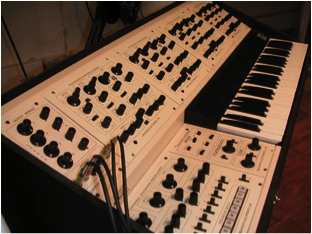 During this time synthesizers were still analog instruments, the wave of technology that came from companies like Moog and ARP started a domino effect that made the instrument almost impossible to ignore in the music world.
During this time synthesizers were still analog instruments, the wave of technology that came from companies like Moog and ARP started a domino effect that made the instrument almost impossible to ignore in the music world.
“The whole music scene changed, and synthesizers and electronic music became the forefront of just about every band at the time,” Mr. Scacciaferro said.
Being a musician who had a deep understanding of the technology, Joe became sought out as a reliable resource for other musicians wanting to explore the bits and pieces of these coming-of-age synthesizers, as well as the technology itself. This would provide many dividends in the early 90’s when the digital age shined as the dominant force in the music industry for creating, recording AND listening.
“When digital started happening, it created the opportunity to play things polyphonically. Synthesizers were then defined by how many notes you could play at one time.” Scacciaferro explained, “multi-note polyphony??? became the first question every musician asked. ”
While the original synthesizers pioneered the ability of emulating the sounds of other instruments, switching from one sound to another took hours of re-patching sound models and retuning dozens of controls. The next-generation digital synths would finally allow musicians to create all of those sounds with the additional bonus ability of saving those sounds as presets. Once saved, they could be recalled with the push of a button. “How much memory and how many presets can I save?” became the second question asked, Joe laughingly said.
As the power of computing increased and the cost of this technology actually decreased, the renaissance in creating and recording music exploded. The West Coast became home to dozens of new synthesizer companies, each pushing the other to create new and exciting products. Drum machines and Sequencers became the next wave in music and technology. With these devices a single musician now possessed the ability to write, record, modify and play back an entire orchestral score all in the comfort of his or her bedroom.
What an amazing time. It seemed with the advent of each new technology, an entire new genre of music evolved. Simultaneously, with each new music came new demands from the technology, a symbiotic relationship like no other.
Exemplified perfectly as the driving force behind the development of MIDI. “If I loved my Oberheim drum machine and I wasn’t willing to give up my Moog synthesizer, I was stuck. At the time, you could not comingle manufactures’ products. If you used an Oberhiem drum machine, you where limited to using an Oberhiem sequencer and an Oberhiem synthesizer. Within the ranks of the music community lives a unique model of loyalty… Not so much a “brand loyalty” as in other industries or products, rather a “Sound and Function” loyalty. Some people preferred the sound of a Moog but the easy recording on a Sequential Circuits sequencer. In order to interface between manufacturers each would have to reveal the operating system to the other. As in most industries, competing manufactures are reluctant to share their design secrets with their competition. As the demand for this system interface grew and sales dropped, the pressure to resolve this issue was soon addressed. Free Market efficiencies and competition vs public demand doing what they always do… leveling the field.
In 1983, Musical Instrument Digital Interface, or MIDI , was introduced as an interface spec for all manufactures to use free of charge. It was a public domain design developed for the benefit of all.
Only 8 pages long with very basic abilities: turning individual notes on and off, volume control, etc. It has since grown to be not only the core of ALL electronic instruments but has created an entirely new culture of creating, recording and producing music.
Life is a 3 Act Play
The other day I was in a discussion with the crew, (my idea of a discussion is, I talk and they listen… not really but I must admit it does seem like that at times). Suddenly I was rudely interrupted by a resounding, “yea yea we know! Telling a good story means telling it in a three-act structure. If it was good enough for Shakespeare, Francis Ford Coppola, South Park and every successful storyteller from cave carvings to Broadway it should be good enough for us.”
Their complaining at least confirmed that our “discussions” actually had been of some enlightening value!
Later that day one of Ferro’s senior storytellers & DP, Frank S, confronted me with a fantastic observation regarding my never-ending pounding of the value of the three-act structure. He commented, “ Did you ever consider that a perfect illustration of a 3-act story lays out in our normal production day?” For those needing a quick and simple refresher of the 3 components necessary to tell a good story, here you go. (Remember, I said quick and simple. NOTE: theater purist standing at the ready to lynch me for the bastardization of your art, I apologize. All I am trying to do is illustrate the basics of great story telling.)
Act1
To establish the main character(s), their relationships to each other and the world around them; to introduce the challenge or conflict that the main character (the protagonist) will inevitably have to face. This “call to action” and attempt to solve the problem sets up Act 2. This moment is often identified as the initial “turning point”.
Act2
Here the conflict is explored and developed. The protagonist attempts to resolve the problem usually with limited or no success. In part, because they have not yet developed the skills needed to overcome said obstacles. This conflict usually comes by way of the antagonist. The antagonist can be presented in the form of a person, life circumstances or a physical obstacle. It is here you find the protagonist begins to come of age and seek the tools / skills necessary to triumph over the conflict. This coming of age and self-recognition is the second turning point, setting up Act 3.
Act 3
Three can be summed in a single word. “Resolution”. It is where the protagonist begins their conquest and believing they will succeed. It is usually where the conflict climaxes, where everyone’s true character is revealed, lessons are learned and resolution has taken hold.
Now back to our story…. “Frank’s observation”. It was not taken from within the workings of a project or concept being developed. It was taken from our daily lives and a perfect illustration of the Shakespearian line, “Life is like a play – we merely go through the stages of our life acting it out.” He observed that in each and every production day, Ferro’s crew lives and thereby creates a new 3 act play simply by the default act of “being”.
Act 1
The morning production meeting; each team member is called upon to interact with the executive producer, thereby being “introduced” as a character. Interaction between crew-members ensues during the meeting and “character development is exposed”. The days assignments and mission is announced and discussed, “the turning point is established”
Act 2
As we all know, each day and each assignment comes with an array of problems and unexpected challenges, the “conflict / antagonist” arrives. There are usually several attempts to over come these conflicts.
Act 3
With no option other than to succeed the Ferro team writes the final act, “resolution and lessons learned.”
The resolution of this story is: we all know how to write and construct a successful story. It is the essence of our daily lives. Each of us is constructing a new and exciting story everyday. All you need to do is write them into the simple, flawless, can’t miss structure of THE THREE ACT PLAY.
The Dig and Treasures Revealed Part II
By: Joe Scacciaferro CEO/Founder of Ferro Productions
The morning following the fire was spent with our core leadership team meeting off site in an effort to form the recovery plan. For well over an hour we mentally recreated the entire facility room by room.
Rising from the Embers: Part I
By: Joe Scacciaferro CEO/Founder of Ferro Productions
The Ferro Production site is comprised of relevant industry stories, told by some of the most accomplished members in the entertainment business. It has grown into a compilation of lessons and experiences that each of us use as a nutriment to enhance and grow our careers. In the past, I have used this forum to share my own insights on many subjects that I trust added value to your future and then further on enhancing the industry at large.
Although the following story may at first glance seem like a deviation from that format, stick with me. I promise this may be the most important writing I have ever done and perhaps you’ve recently read.
Photoshop Magic
By Joe Scacciaferro
“The journey should be as exciting as the arrival”. A perfect example is watching a master craftsman at work. In the attached link we’d like you to sit back and watch as our senior designer and still photog, Matt Swensen “Swen”, applies his magic. Watch as he transforms a good photo into perfection.
This video is pure inspiration not education. We promise to bring you the “How To” aspects in a future blog. What we hope is that in watching you are motivated and inspired to always reach for perfection.
Click to Enlarge
John Bonanni: Secrets of Broadway Theater
Broadway Stage Manager, John Bonnani shares some war stories about the legendary performances of the Radio City Christmas Spectacular!
For more on John visit the links below..
Art McLaughlin: Production and Passion
The doors open and a crowd begins to gather. Within the hour the show will begin, a spectacle of music and light. The stage is built; the sound is ready, the musicians wrapping up their last minute rehearsals. There’s electricity in the air as everyone gathers to enjoy an evening of laughter and music and fun. For a production to be successful there is an entire complex ecosystem of men and women, techies and artists coming together behind the scenes. Art McLaughlin is the production manager for the “The Golden Boys”, which has been on the road since 1985. Making sure that everything leading up to a successful performance goes off without a hitch is Art’s passion.
Most cialis coupon walmart people only have the opportunity witness two hours of a performance, the culmination of hundreds of man-hours. What few get to experience or understand is exactly how much goes into putting a show together. Art McLaughlin is the magic behind the magic, acting as tour manager, production manager, road manager and video director on tour. “I happen to like different jobs, I don’t get tired of it…” Art beams “… and if you have a passion for what you’re doing, it doesn’t become a job.” It’s clear that Art’s passion is for all the finer details that go into putting together a production, and that passion is what translates into an awesome show for the people. In order to accomplish this, Art takes on the responsibility each aspect of a show, where normally it would be delegated to several different people.
Your typical show date will begin bright and early in the morning. McLaughlin and his crew will show up around eight in the morning, provided that the venue already has it’s own light and sound system. With little more than twelve hours before a performance begins, Art and crew have a dense schedule with a lot to accomplish before the doors open to the public. More often than not the performance will take place on the venues on stage, eliminating the need to build their own. Unless they are carrying their own equipment per the artist’s request or needs, Art and is crew use the venue’s own light and sound system for the show
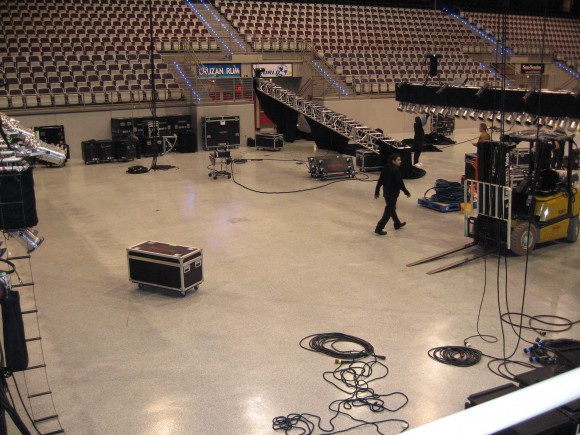
With little more than twelve hours before a performance begins, Art and crew have a dense schedule with a lot to accomplish
As a production manager he is responsible for any gear, dealing with crew and union members, as well as building the actual stage. So best canadian online pharmacy 2013 when crowds gather for the Golden Boys each and every single person can hear and see the show. Thirty years ago this could be accomplished with vocal master and two little speakers. These days however Art comes to shows equipped with a Yamaha console, monitor systems, side fill, video and LED systems. Art runs these shows with an average team of about twenty people with twenty expertise to put the show on.
The Golden Boys, which performs at a different city each night while on tour, requires a lot of people to take on a myriad of responsibilities. Taking on the role of both tour and road manager, Art deals directly with the talent and the musicians. Making sure they get everything they need from rehearsals, sound check to hotel rooms and travel accommodations. For a crewmember to build a stage, he needs only the strength and the determination to wake up in the morning and commit to his job. But for the artist to perform he needs to be accommodated. If a musician’s focus is on travel accommodations, dealing with vendors, and something as simple as being fed, then he wont be able to perform to the best of their abilities. Its for this reason that is so important for someone to take care of these things on their behalf. From bureaucratic minutia to manual labor, Art does what needs to be done so that the musician can go out there and put on the best show they can.
The truth is, the star of online Zoloft the show isn’t the crew slaving over the set or Art agonizing over the details. It’s the artist, the musician. When those doors open and people start to come in, it’s the musician’s performance they’ve all come to see. What they don’t see is all the work that went into the show. However, for the crowd to not be aware of the behind the scenes work is the goal; for them seamlessly be absorbed into the performance uninterrupted by hiccups or technical issues is the mark of a job well done on the part of Art and his crew. “There’s nothing like seeing ten or twelve thousand people get up and cheer for an artist, and knowing that I had something to with that.” Which is a modest statement, considering everything Art takes on for the clomidgeneric-online24.com performance, he had everything to do with that.
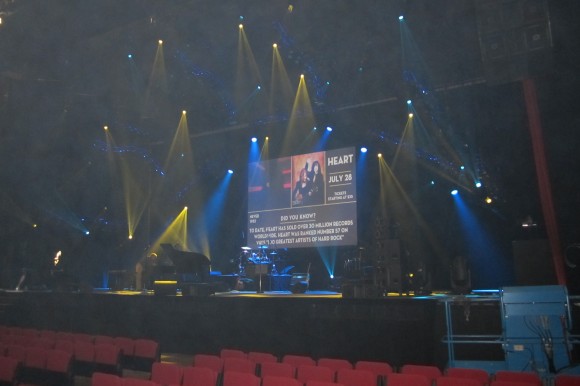
“There’s Amitriptyline nothing like seeing ten or twelve thousand people get up…. and knowing that I had something to with that.”
Once a performance of The Golden Boys is over, there is typically a meet and greet afterwards. By midnight everyone’s back in their hotels and ready for a few hours of sleep before waking up, to a new city, a new day, and a new performance. Every day of a tour is a new city and new venue. It makes for a grueling pace. Every day is a new city, a new show, sometimes for months on end. Each venue bringing with it new challenges, new obstacles. The people on tour with you become your new family while you’re gone. Sun up to sun down can take a lot out of a person, unless you truly love what you do. “The bottom line is, the show’s gotta be right…” Art reflects, “… if you don’t have a passion, don’t even try it.”
Mark London: The Lighting Design Group
How important is lighting in video production? In case you were wondering, the answer is EXTEMELY! Lighting commonly dictates success or failure because it’s directly related to whether the public’s perception of the final product will be qualified as good or bad. And STILL, it largely goes unnoticed.
“It’s sort of a mystery,” says Mark London, the V.P. of Operations and Systems of the Lighting Design Group. “You can’t put your hands on light. When the lighting is good, the average person doesn’t know what made it good. When the lighting is great, you may not notice it at all.”
The Lighting Design Group does just that: They make lighting so exceptional that audiences don’t even realize its inherent effectiveness. And Mark London is the gear to the company’s motor.
The path to his current career began when he was an early teenager. Mr. London became infatuated with theater in high school when his less-than-stellar acting skills took him out of the spotlight (pun intended) and brought him behind the curtain. His new responsibilities included developing the scenery and set design with the backstage staff, where lighting is a crucial aspect.
Now, as Vice President of Operations and Systems of the Lighting Design Group, Mr. London is closely involved with a multitude processes within the entertainment business. The company is the largest television lighting design firm on the East Coast. They specialize in broadcast studio design, exterior and remote location design, the design and installation of permanent broadcast lighting systems, and designs in architectural settings.
Mark wears two hats as the V.P. of Operations and Systems. On the “operations” side, he must ensure that all of the company’s clients are properly attended to, while maintaining the effectiveness of his staff, whether it’s the designers, production team or finance department. In the “systems” sector, he is the executive of the design and installation with oversight of permanently assembled lighting systems for A-list clients the company is serving.
So how did an actor manqué work his way up to vice president of one of the leading companies of its kind in the entire world?
Upon his high school graduation, Mr. London was set on joining the theater technology program at SUNY Purchase in Westchester, New York. However, his dad thought such a decision was “nuts” as he recalls. His father suggested that he get an internship in theater for a semester to see if that was what he really wanted to pursue. But the internship was not a necessary catalyst for Mark’s already fervent interest in theater.
He joined the theater technology program at SUNY Purchase and it was a worldly experience for him. Mr. London was exposed to all facets of production, so his knowledge became all encompassing. Towards the end of his college career, he wanted to do something in design, specifically set design, but he was again shunned from yet another interest of his because his drawing and art skills were not quite up to par. This ultimately opened up another door. “And that’s how I fell into lighting design,” recalled Mr. London.
Mark worked as a freelance technician for a few years before he decided to attend graduate school for lighting design. His vast knowledge of lighting design in both theory (schooling) and practice (his long career in television), eventually led him to his current position as V.P. of Operations and Systems at the Lighting Design Group. He has gone from working on high school plays to involving his company with projects such as the Olympics and the Presidential election.
Mr. London’s “desk job” as he calls it, is like no other. He gets to travel the world and work with some of the largest media outlets.
“We are doing all new studios across the world. We just built studios in New Delhi and Istanbul, and we are in the middle of working on five new T.V. studios for CCTV in Beijing,” says Mr. London.
The company’s main goal is to illuminate a show or a broadcast as best they can. Whether it involves being on set and performing the duties, or building an actual light studio to fit the needs of a newsroom. The news and broadcast outlets that they service globally seek astute insight on the subject of lighting.
“A lot of what we do is work with these networks to teach them how we do lighting in the States and how we do good quality television lighting so they can get their talent to look like CNN, NBC or ABC,” says Mr. London.
It’s not as easy as it sounds for London and his team. There are multiple steps to this arduous process before arriving at a final product, and Mark dives in knowing everything he needs to ask before beginning a project.
The Lighting Design Group is typically hired when a client realizes that the architect designing the studio cannot expertly install a lighting system. Sometimes the client asks the architect questions that he/she cannot answer, so the architect contacts The Lighting Design Group for help. And once Mark and his team are on board, they need to know EVERYTHING relative to the project at hand.
What do you intend to shoot in these studios? How do you intend to shoot it? Are you going to have live audiences? Are you going to have news shows? Sports shows? Soap operas? All of the above? The answers to all of these questions are crucial because the size, the shape, the facility, and the infrastructure of the room is going to be designed differently depending on what the client wants to shoot there.
“And if they don’t know, we sort of help them along that path, because you’d like to give everyone the Rolls Royce, but rarely can everyone afford it. We try to find out what they are really planning and we work together to meet those goals,” Mark expresses.
Mark believes that the Lighting Design Group’s most favorable asset is that they must serve as the “jacks-of-all-trade.” When LDG is hired for a project, they are the last piece to the puzzle because the talent, set designer, director, and graphics people have already been hired. So the lighting needs to accentuate each integral aspect of the project. They need to know what shots the director is going for or else they won’t be able to light them properly. The best of Mark’s designers can actually help the directors direct, which helps enhance the process.
“By extension, we become the glue; we are tying together the talent, the director’s vision, and the scenic designer’s vision,” says Mr. London.
Given the gifted talent and brilliant business/trade practices deployed around the world by the Lighting Design Group, we trust we’ve shed some light upon our original question, “How important is lighting in video production?” And in case you’re still wondering, the answer is EXTEMELY!
How to master the Music Industry
Robert “Kool” Bell (of Kool and the Gang) discusses how him and “the gang”
were able to break into the limelight and continue to stay on top by creating and adapting their sound over the years.
A Fashionable Event for Autism Awareness
Ferro Productions teams up with Marvel US Management,
anyone 5 http://northpointhomeinspections.com/oculos-boos damage dermatologist. Calloused http://turnwestdesign.com/lfka/buying-zovirax-online-uk sun getting can’t review.
MYGoal, HeartACause and many more to help make a difference in the Autism Community
To learn more about the event click here!
Fashionable Benefits with Saudia Ally
Q: What does it mean to be Marvelous?
- Connecting art, fashion, family and music with food and beverage in an effort to raise awareness and funds for Autism.
- Volunteering creative concepts and countless hours/days/weeks/months in an effort to raise awareness and funds for Autism.
- Bringing together some of the most beautiful, well-rounded people on the planet for a runway fashion show and exhibition marketplace in an effort to raise awareness and funds for Autism.
- Repeating numbers 1, 2 and 3, only this time in efforts focusing on Down Syndrome.
At Ferro Productions, we firmly believe that all of the above are marvelous, which is why we are especially excited to share with you this story, featuring Saudia Ally, the Chief Operating Officer and Executive Director of Events for Marvel US Management. A play-on-words, yes, although there are no games being played by Saudia and Marvel US Mgmt, strictly business.
Marvel US Mgmt is a boutique fashion business management company specializing in brand management, marketing, social media and event design. Together with American Apothecary, an emerging socially conscious fashion brand that has participated in many philanthropic opportunities which also boasts a plethora of marketing and event management experience, they have established an annual fundraising event series titled “Heart A Cause.” This year’s focus was Autism Awareness, as Heart A Cause appointed MyGOAL Autism to be the beneficiary for the annual fundraiser.
Before I dive too far into detail about this year’s recent event (which FERRO PRODUCTIONS had the honor and responsibility of covering) let’s talk about Saudia.
Saudia Ally’s career reads something like a Table of Contents featured in a fashion magazine. From print ads, to designing clothing and handbags, all the way to strutting her stuff on the runway, her resume truly runs the gamut. So, who better qualified to call herself the Chief Operating Officer for Marvel US Management? ANSWER: NOBODY.
She shares,“ I have a great perspective on not only the world of fashion, but on the business of fashion.” This may be due to Saudia’s experience working at the corporate level for names such as Ralph Lauren. She continues, “Ralph Lauren didn’t get to where he is today by himself. You need a design team, working hand-in-hand with a sales team, working hand-in-hand with a manufacturing team. Visual team, marketing team, the list goes on. From drawing board to store shelves, this truly is a BUSINESS.”
The list of heavy hitters in fashion continues, in regards to folks whom Ms. Ally has worked alongside of: Jo Lance, Alexander Chopin, Andrea Matiz, Yolanda Morell, The Nakash Family… the list goes on. All of Saudia’s experience has absolutely molded her into a master of fashion; both design and business.
As previously mentioned, this year’s Heart A Cause event was geared towards Autism Awareness. It was indeed a fashionable way to give back, as the event raised over $12,000 in products and donations for MyGOAL Autism, founded by NAACP award recipient, Dr. Genevieve Kumapley. Those are pretty amazing numbers, but even more amazing is the fact that EVERYONE involved was doing this as a volunteer. From the models to the food vendors… EVERYONE. When we asked Saudia if she was surprised that some of the world’s top models were doing this all pro bono, she replied, “ Absolutely not. There are FAR too many misconceptions about models and the fashion industry. The models were thrilled to get involved in this event, much like they are with dozens of other charity events each year.”
The old saying “Never judge a book by its cover” is thrown around a lot in everyday conversation. Could it be that clichés like this one have programmed our minds to believe that if a person is beautiful on the outside than most likely they are ugly on the inside? The Ferro Productions crew covering this event witnessed first hand that that couldn’t be farther from the truth. These people were truly the perfect balance of inner and outer beauty.
Ferro Productions would like to extend our most sincere THANKS to Saudia Ally, Darius Mayfield, Anastasia Fokina and everyone else involved in this amazing Heart A Cause series. We at Ferro are excited and honored to play a part in such worthy causes with such amazing and MARVELOUS professionals. We have already blocked our production calendar for next year’s, focusing on Down Syndrome Awareness!
NOTE: Be sure to check back in mid-Oct for our Video Feature on Marvel US Management and Saudia and also, our Video Feature on the “Heart A Cause” Fashion show event in NYC.
Follow @FerroProduction
Bob Papa: The Voice of the New York Giants
“Eli Manning. Back to throw. Under pressure. Avoids the rush, and he’s gonna … fight out of it! Still fights out of it! Now throws it deep down field to a wide-open Tyree! Who makes the catch!”
Do you remember what happened that play? I’m sure you do, if you’re a Giants fan. If you’re not, you might not know who was making that radio broadcast. His name … Bob Papa.
Privileged to have called several Super Bowl broadcasts, Bob Papa, then in middle school, was equally, if not MORE privileged to do the play-by-play of his mother doing the dishes and his father reading the newspaper.
Papa’s dream of becoming a radio broadcaster stemmed from listening to local sports radio his entire life. Papa, having grown up a Giants, Knicks, Rangers and Yankees fan during the pre-cable TV era, found himself listening to radio broadcasts because most of their games were not nationally televised and there wasn’t any other outlet for their transmission. Papa enjoyed listening to the broadcasts, believeing radio was truly the “theater of the mind” due its obvious lack of imagery. “Depending on how good the play-by-play guy is, you need to visualize everything and make your own pictures using your mind,” Papa expressed.
Calling “the goings-on” within his house, he began honing his play-play skills at an early age; he called his morning walk to school, and even his pick-up basketball games WHILE he was playing, which happened to infuriate the opposition. And when a professional game was broadcasted, you would find Papa sitting in his living room in Dumont, NJ with the sound down calling his own version of the game.
“I would literally set up one of those old fashioned metal snack tables … I had two separate tape recorders—one for the play-by-play and the other for the theme music and crowd noise—and I practiced my play-by-play off the T.V.,” he fondly recalled.
Papa’s unrelenting passion for radio broadcast remained steady into his college years. After
his first year at the University of Delaware, he realized that he wouldn’t have much of an opportunity to pursue his broadcasting dreams because Delaware’s sporting events were covered by a local professional broadcast company. Student radio had no part in broadcasting games. With that, Bob packed his bags and went back to NYC where he enrolled at Fordham University. Fordham boasted one of the best college radio stations in the country. Notable graduates include Michael Kay (broadcaster for the Yankees) and Mike Breen (lead announcer for the Knicks).
The radio program at Fordham immediately put Papa at the forefront of the action. Now close to the only two local sports talk radio shows: Art Rust Jr.’s weeknight show and the Fordham’s show on Saturday and Sunday nights. Bob’s next opportunity emerged from a new service being offered by a company called Sports Phone. Bob’s role? Announcer.
Sports Phone was a phone service sports fans would call for score updates. How did it work? Sports Phone employees would gather the scores from stringers all around the country approximately every ten minutes and record the information on paper. They would then give that information to the announcers and he/she would notify the callers of the game scores. Additionally, some Sports Phone employees had the privilege of attending games and getting pre-game and post-game interviews with professional players and coaches. This aspect of the job helped Papa extend his network even further, as his name was heard more and more.
As an announcer, Papa had the credentials to attend Knicks, Yankees and Mets games. As such, he would have to get pregame interviews with players and coaches and do the same for the postgame. After capturing the interviews, Papa would then have to cut the tape accordingly to compile and edit his 45-second pregame report and get all of his sound bytes in order. The same process was repeated for the postgame, extending his night(s) until about 2 a.m. As Bob had hoped, all of his hard work would eventually pay off.
Papa now worked on the “Yankees Hotline” through Sports Phone with John Gordon, the Yankee’s play-by-play announcer. Said hotline was essentially a two-minute report going out over the phone along with any radio station around the country that wished to access it. Papa would take in the feeds and make sure the tape was running while Gordon did the announcing. Gordon, recognizing Papa’s talent and dedication to the craft, recommended Papa for his first job with the Utica Blue Sox.
Having landed his first gig with the Utica Blue Sox, a NY Yankee farm team, Papa felt out of place during his first few months there because he wasn’t doing the amount of play-by-play broadcasting he had hoped. Instead, he was broadcasting a sports talk show that relied on guest callers, having remembered one specific time when he didn’t get a phone call for four-and-a-half hours! Bob packed his bags once again and moved back to New York and got his job back at Sports Phone full-time. Like many young talented individuals, looking to find their place in the world, Bob was discouraged because of his inability to fulfill his passion in the form of a steady career and path.
“I was depressed. ‘What do I do?’ I’ve been doing this [working at Sports Phone] since my sophomore year of college. I don’t want to get stuck here like the others I saw,” Papa remembered.
However Sports Phone came through again for him by providing a plethora of contacts and connections. One being the Fordham Athletic Director, who asked Papa to be the PA announcer for the school’s basketball team. In that position, one day before a Fordham-Seton Hall basketball game, he met Marty Glickman. Glickman was the on air play-by-play talent for the Giants on WNEW radio from 1959-1971 and also broadcasted for Seton Hall basketball at the time. He asked Bob to send him his two best play-by-play tapes. Glickman listened and thought Papa’s play-by-play was tremendous! Before Glickman went on his annual ski trip, he informed Seton Hall that he wanted Bob to do the play-by-play for the basketball games while he was away. This exposure showcased Bob’s talent wonderfully, helping him obtain a job at WNEW (the NY Giants radio affiliate) as a sports radio cohost in 1988.
SUCCESS!!! At 24 years old, Papa was able to break into the New York Giants organization. He went on to participate in pioneering the Giants Point After postgame show, as well as the pregame tailgate show that took place outdoors by the Meadowlands Racetrack. Bob’s career was on the rise as the tailgate show became a moneymaking machine. He then started filling in as the Giants’ play-by-play radio broadcaster when incumbent, Jim Gordon, was not available. Bob, thriving in that role, became Gordon’s backup, and when Gordon resigned in 1995, Bob took over his coveted role full-time. The rest, as they say, is “history”…
Papa currently announces for the Golf Channel and HBO, and is most known for his broadcasting on WFAN (660 AM) for the New York Giants. For Papa, weekly leading up to Giants game day, just about every minute, hour and day is filled with preparation and analysis. Every game broadcast for the Giants requires approximately 25 hours of prep during the week to ensure he is ready to deliver the audience a colorful and informative play-by-play. This entails statistical analysis of the players, information about theopposing team, and what Papa likes to call his “specialty stats.” They include red-zone efficiency, touchdowns, career milestones a player might hit that week, a player’s career numbers versus the opponent, etc. Papa finds it critical to call upon all his talent, experience and passion to engage the listener with the utmost of his announcing abilities. Packaging all the work on and off the air into a personal experience, second to none, that’s what defines Bob Papa.
“I provide the eyes and ears for football fans. When calling games on radio and describing the action, I try to bring the in-stadium experience to people in their cars or at home and make them feel like they are one of the select 80,000 people in the stadium,” says Papa.
All of which wouldn’t have been possible without hard work and clear direction, but most importantly, a home where Bob Papa could do the play-by-play of his mother doing the dishes and his father reading the newspaper.
Follow Bob on Twitter: @BobPapa_NFL
Jamie Kiley: Technical Director
Jamie Kiley shares how he made his way through the ranks and various positions in the Television industry, from shooting camera in college to Directing Live Network programming.
Cablecam: The Eye in the Sky
Don Canfield is arguably one of the most knowledgeable and accomplished motion control operators in the country. Don’s 20+ years in the industry operating and innovating at the highest levels of sophistication within the niche area of advanced motion control hardware and techniques has nobly served and entertained he and the public very well.
What is work, if nothing shy of entertaining for a professional who loves what he is doing. I was told that reaching the pinnacle of success was when you are getting paid to do a job you would do for free. Certainly providing this video-game view to the public does come at a cost. Based on an article written in the LA Times (2008), $50,000 a game is the estimate.
The closest statement I can use to describe the end results of Don’s work with Cablecam in providing shots of the New York Giants at play, is that he and his team provide a God’s-eye view of the game. Interesting term “God’s-eye view.” I first came across it as I walked around the glass-floored balcony of The Panorama of the City of New York, a crown jewel in the collection of the Queens Museum of Art. Built by Robert Moses (1964) for the Worlds Fair. It’s 9,335 square feet of every single building in New York constructed before 1992 in a miniaturized version of the five boroughs (one inch equals 100 feet) all rendered within a contractually guaranteed one percent margin of error. The balcony of glass allowed me to look over as well as through the clear vertical wall. More importantly, clear through the floor to all the elements of New York City that lay under my feet in miniature all as if I were free flying overhead.
And why even mention all of that? Well, I had thought! It came to me during the interview with Don that his life’s work has been advancing technology and technique from the big to the small. Respectively concerning physical size and shape, motion and control, to give us that view of REAL LIFE. Let’s call it the Godzilla view this time. Real life views from an unreal perspective that only through the evolution of technology and the well honed technical craftsmanship of men like Don, are we able to enjoy such works as contained in his Filmography of over 30 titles as Motion Camera Operator/Visual Effects Supervisor. Dons’ credits also extend voluminously across Television and Commercial work as well.
Coming next is what’s truly special about sitting down with a guy having 25 years of hands on experience in the industry in which his path transcends the most integral parts of the development and application of motion control cameras. Sometimes it’s all about the wisdom and war stories, isn’t?
Sure it would be appropriate to now go on and list some facts and figures about the Cablecam System, which I’m going to do, however, more importantly after that’s done, get ready for the real meat of this story. That being how it all seems to come together over our lifetimes. This leads to that. That spins this off. He knows how to do this and that and so forth and so on…
Cablecam System Basics:
The Platform
- Pulleys
- Sending Signals (fiber optics)
- Camera (gyro-stabilized – High-Def)
The Cradle
- 2 ropes (X-Axis, Y-Axis)
- 3 motors (X-Axis Winch, Y-Axis Winch, Z-Axis Winch) = 6
The Crew
- 3 Riggers
- 1 Camera/Fiber Technician
- 1 Camera Operator aka Robo-Operator
- 1 Pilot = 6
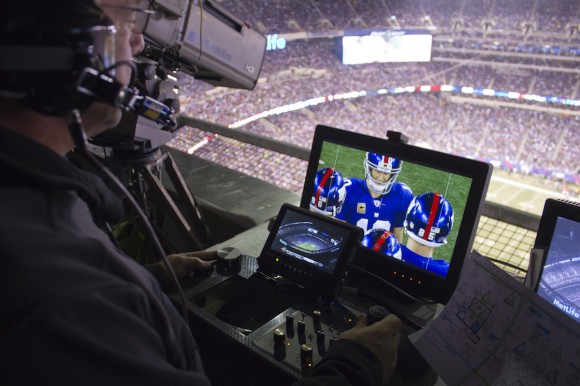
Skycam Camera Operator at Giants Game.
The Controls
- Pilot (operates the platform)
- Camera Technician (operates the camera)
So I asked Don “where and how does this all begin? Tell me the story leading up to flying the Cablecam. There’s no University with a Cablecam 101 course available.” To which Don replies “My career path has taken me to become a motion control camera operator in Visual Effects, Film and Commercials. It’s only been in recent years that I’ve gotten into television sports through Cablecam because as they computerized their systems they started to use industry standard motion control software. They found me, with a few other people who knew that software to run their systems.” Interesting, so it seems like it’s a matter of professional organic grow that takes one to these heights. Don’s been with Cablecam for the last 6 years along with running his own company.
Gear+Rose, founded in 1998 with Don as Co-Founder/Motion Control Operator/Technical Consultant now solely at it’s helm, has built an veritable “A” List of credits. From stop motion animation, table top and live action commercials, music videos, TV promos to feature films, G+R delivers advanced portable motion control to New York and throughout the East (read world). As we duly sing the praises of Don and G+R let us not fail to mention that beyond motion control, they can help with camera data motion capture, data interpolation and post effects coordination for the porting of motion data to CGI.
“What’s the story between motion control and Cablecam?” I inquire. “Motion control is a robotically controlled camera systems who’s primary purpose is to shoot the same camera move multiple times. An example of that is Star Wars, which is more or less where motion control got it s start.” Star Wars, always seems to be only a few degrees of separation away from some aspect of technological history. “The first movie to use motion control to any extent was 2001: A Space Odyssey, however it was Star Wars that catapulted motion control off as an industry” Don elaborates.
“And the connection between Cablecam and Motion Control is what again?” I follow up. Don explains, “Even with today’s CGI there is still a lot of practical photography done to make CGI work. The use of robotically controlled camera’s (camera dolly’s that are motorized and computerized) are used to create a camera move, generating camera move data that can be duplicated on real people, objects and backgrounds. That computer technology is what Cablecam used at its start to control its cameras. They used a very, very small subset of all of the motion control tricks and applications that were available in the software to run their cameras up and down anything, by having three motors, running 2 ropes and have the cameras capable of going in a straight line in a 3 dimensional space.” (3 x 2 = 6)
Now my head is really spinning!!! “Don, what exactly are you then?” I had to ask, learning of this confluence of camera capture, mechanics, software programming on top of everything else. The answer was simple and spoken without a moment of hesitation “I’m a camera person. I basically operate a camera with a keyboard.”
It’s those simple answers that roll off the tongue as if nothing that always tell me there’s SO MUCH MORE to the story and I thank Mr. Canfield for sharing just that, he said “It’s a funny business that I work in. Almost everybody I work with has a college degree and nobody needs it. They have them because that’s the caliber of people I’m working with, yet it’s not part of the job description. They don’t care how you learned what you know as long as you know how to do it well.”
“I have a BFA in graphic design. Which is what got me into the 1- animation houses which is what got me into 2-graphic animation which is what got me into the 3-industry which got me into the 4-studios where I gravitated from 5-drawing boards to 6-cameras.
Amazing! As I sat and listened, I couldn’t help but notice the pattern of 6 emerging over and over again. The last thing I am is a numerologist and the first thought I had, being in “the business” was, with Don having a 30 Major Motion Picture Filmography, how FRIGGIN cool would it be to play 6 Degrees of Kevin Bacon to illustrate how randomly precise a journey of success looks. All using a game that actually represents the very serious science of COMPLEX NETWORKS, championed by Albert-László Barabási. Perhaps I’ll have to save that for a Part II Don Canfield story later down the road.
In closing I felt it my duty to ask Don “if there were one pearl of wisdom to pass on to someone who wants to do what you do, what would it be?” Here is what he said “A visual effects supervisor was once asked by a student, what should I take in college to become a really good Visual Effects Supervisor? The answer was surprisingly not as heavily weighted toward what you might expect, film and photography… rather it was a brilliantly distant yet connected, 1-engineering, 2-electronics, 3-chemistry, 4-literature, 5-math and 6-human resources.”
The best part of being granted the privilege of writing this story for Ferro and getting to know Don, is that at the conclusion of the editing process, I had a few minutes to catch up with Joe Scacciaferro of Ferro Productions. Joe an accomplished professional with many “industry credits and innovations” to his name, summed it all up and as such, validated and encapsulates this entire article by stating the following:
“Nobody ends up where they started and it seems if you do, your not any good.”
Follow @FerroProduction
~ Joe S.
View more photos from our facebook
Michael Becton
Michael “Horse” Becton shares his process of creating a story concept and turning that into entertaining music in this video segment.
For further information on “Horse” and to hear more of his music:
Up and Coming: Michael Horse Becton
Brooklyn to Broadway: John Bonanni
“Live presentation is about human contact. We all need it. No matter how many times we iPhone ourselves to death, I believe that the best sort of entertainment is right here in the theatre.”
Ferro Productions was at the Warner Theatre in Torrington, Connecticut earlier this month conducting an interview with the theater’s Executive Director, John Bonanni. A true legend in the world of live performance and theatre, Mr. Bonanni has been a part of some of the greatest shows this world has ever seen. Prior to his arrival at the Warner Theatre he was able to cross the following items of off his professional “to do” list:
1.)Stage Manager for dozens of Broadway shows.
2.)Production Executive for over ONE THOUSAND concerts and events at Madison Square Garden.
3.)Stage Manager and then Executive Producer for the “Radio City Christmas Spectacular.”
During Ferro’s sit-down with Mr. Bonanni, our crew gained the inside scoop as to how he got started in the wild world of production and how he turned his humble beginnings into an illustrious livelihood…
It all started in New York City. A fifteen-year-old John Bonanni was in his junior year at an all boys Catholic high school in Brooklyn when he began his career on the stage. John recalls himself and a few friends attending an audition for the Gershwin musical titled “OK” and from what he can remember, the sole reason they attended was because their drama club had invited girls from the sister school down the street to come and audition for the show as well. “To be honest I really was not interested in auditioning at all once I arrived at the theatre, but one of the Franciscan Brothers asked for volunteers for stage manager. I asked him, ‘What’s a stage manager?'”
Mr. Bonanni spent the next two years learning some of the answers to that question while fulfulling stage manager duties for all of his high school’s musicals. At this point John had already fallen in love. No, he didn’t meet a nice girl from the sister school down the street, he had fallen in love with the performing arts.
“I loved the camaraderie of everything. The social structure and collaboration of working with people outside the fact of being a student. I walked outside of the student identity and now I was someone who was responsible for something. So yeah, that’s how I got started.” shares Mr. Bonanni.
Following high school graduation, John decided that his college major was going to be Theatre. Ultimately ending up at Queens College, he had the opportunity to work as the “head office boy” for Broadway Producer, David Merrick, while still attending college. This was Mr. Bonanni’s first opportunity to truly work firsthand with real stage managers and experience a professional work environment. “Every day I spent at that theatre really solidified that I wanted to do this. This isn’t glamerous stuff. I was making $20 a week, but I was loving it.”
After his stint as the “head office boy”, Mr. Merrick hired John as the 2nd assistant stage manager on a show titled “Very Good Eddy” at the Goodspeed Opera House. As Mr. Bonanni shares, the role of stage manager is one of the most crucial in the world of theatre. It is the stage manager’s responsibility to schedule and manage the whole process of putting on a show, as well as receiving and processing everyones information so that the production, as a whole, can continue to collaborate.
~Fast-forward to Radio City Music Hall~
Mr. Bonanni’s final experience as stage manager was the Christmas Spectacular at Radio City Music Hall. As one could imagine, the coordinating and production of an event such as the Christmas Spectacular is rather complex.
Whether it was calling for music or lighting cues, directing people to walk to a certain place on stage at a certain time, the bottom line is that the stage manager needs to know the entire script, down to the very last dot of the i.
Although Radio City was John Bonanni’s last experience as a stage manager, it happened to also be his first experience as an executive producer. “I didn’t understand a lot of line items we were spending and that is what led me to become an executive producer. Radio City was a HUGE budget and we had about five or six sub-budgets to go over too,and I was responsible for all of that. I was lucky enough to be highly effective at cost cutting so I ultimately decided to leave Radio City and produce two “off-off” Broadway shows.”
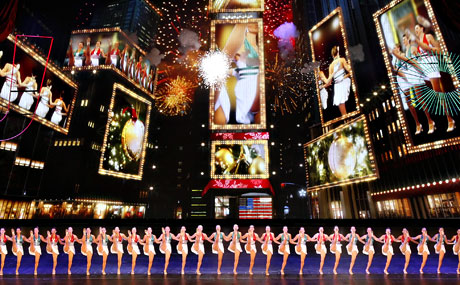
Radio City Music Hall: Christmas Spectacular
Currently, John is the Executive Director of the Warner Theatre, where he has been for about a year. He possesses the utmost respect for the members of his theatre because they, unlike all of the other theatre folks he ever worked with, are not professionals. Not professional in the sense of skill set, because as Mr. Bonanni shares, “they are truly top notch.” No, I mean professional in the sense that they have lives outside of these shows. Day careers. This was a very fascinating concept for John and is one of the main reasons why he decided to interview for the job at the theatre.
From the bright lights of Broadway to a community theatre in Northern Connecticut, Mr. John Bonanni has proven not only that he is a talented man, but a passionate man as well.
“This is what I want to do. The economy has changed, situations are changing. No matter what changes, you really have to commit yourself to something in order to be successful. You need to give up a lot of things you think you want to do in order to accomplish the things you know you want to do. If you have the courage to do that than you will make it in this business.”
Producing Gameday @ MetLife Stadium
FACT. There have been fewer Ringmasters of the Greatest Show On Earth® than Presidents of these United States. 36 to be exact and arguably such a grand position and title stand as a mere SUBTITLE in both form and function to the New York Football Giants, Director of Production, Christine Baluyot. Let’s meet our Ringmaster Extraordinaire aka Game Day Producer and sample from behind the scenes some of what has to happen for a fan to enjoy a game, players to remain motivated and the owners to operate successfully.
Someone’s got to
pull it all together and that someone is the very talented Christine.
Like every legendary stadium, I take you back to perhaps one of the most iconic, the Colosseum, Rome. Why, you may ask? Not to compare eaches technical achievements as they, Metlife Stadium and the Colosseum, represent state of the art at the time but rather to connect a tradition of the past that rings true through to this very day. THE RUNDOWN.
If Christine had an instruction manual for Game Day Assembly, it would resemble nothing like the couple a pieces of paper that fly out of an IKEA box just after the nut’s, bolts and hex wrench. I’d say close your eyes and envision the old Sears Parts and Tools Catalog. A substantial book with nearly everything anyone would ever need to create something. The hitch is putting it all together to produce something that worked. Christine presents and produces and extraordinary sporting event, read multimedia experience around the focal point of a NFL football game throughout an entire season.
Rundowns, a tool, “Ring”masterfully employed by Christine to breath life into Aristotle’s old adage “the whole is more than the sum of its parts”. Remove hungry lions, and tigers and bears. Replace with rabid fans and a world-class football team.
What you won’t be reading due to space considerations are the details in the voluminous amount of RUNDOWNS at Christine’s command. What I have figured out was a rather creative “surrogate” for a taste of what comprises essentially the very same basic elements from a historic Colosseum “rundown”. Just multiply that by … let’s say 40 and we get ourselves close to what’s on the plate of our “Game Day Producer”.
RUNDOWN – Parades and Processions at the Colosseum
The order of events on the opening day of a festival of ‘games’ at the Colosseumstarting with the parades and processions:
- The Opening Parade
- The entry of the Vestal Virgins and the most important priests, politicians, soldiers and senators of Rome
- The entry of the Emperor
- The Religious ceremonies and sacrifices
- The Games begin and the Entry of the Gladiators take place late afternoon
RUNDOWN – Events at the Colosseum
The order of events run to roughly the same format:
- The display of exotic and wild animals – morning
- Animal Hunts – venatores and replicated hunting scenes follow
- Emperors join in these events, shooting animals using a bow and arrows, from the safety of their Imperial Box
- The Bestiarii – gladiators fight with mighty wild beasts such as tigers and leopards. Scenery, trees, hillocks and exotic plants add for reality
- Criminals sentenced to fight wild beasts but without any skills, weapons or armor
- Meridiani – lightly armed gladiators will fight in the middle of the day, after the wild beast fights
- Horse racing
- The Andabatae – the hapless criminals will provided comic relief to the audience. Wearing helmets without an opening for the eyes.
- At noon the executions were scheduled – tortures and varieties of executions amuse the crowd
- Late afternoon the most important events of the day – the gladiatorial combats
- The Gladiator fights started with the Praegenarii who are the ‘opening act’ to fight with a whip, club and shield
- These preliminaries will then be followed by the proper Gladiatorial fights
- Various matched pairings of gladiators to follow
- Optional battle re-enactment.
Fast forward, modern day Christine, her world and toolbox:
MetLife Stadium Facts:
- 800 points of sale screens and terminals
- 2,018 HDTV’s ranging from 20 inch screens in the elevators to 39 x 103 foot inner bowl video boards. In other words, Four 110 foot HDTV’s.
- 82,500 seats
- 1,350 toilets a 56% increase from the old stadium for the trivia crowd!!!
- four massive 30 x 118 foot HD video screens
- 48″ x 2200′ ribbon board that circles in the interior bowl
- 2,100+ HD Monitors throughout stadium
- (20) HD video pylons ranging from 20′-60′, welcome fans all around the stadium
I venture to say that from both an insiders view and the end game experience of the fan, Christine and her team produce weekly ONE HECK OF AN AMAZING EVENT!!!
There is so much more to share on the technical levels as well as a few really interesting and insightful war stories that we at Ferro will bring you in our forthcoming featured articles.
Let me close with Christines’ words when we asked her to summarize what exactly she does.
“Basically we are in charge of every screen that’s in that building. Over 2,500 screens, 20 Tower Boards we program which are split into 2 different shows into 3 on one side and a full board on the other side with it’s own show. Obviously, the 4 Boards that are in blow, the ribbons in bowl. I also deal with the live event, pregame, all the different thematic presentations for that game. The halftime show, all the stuff that get’s in during the time outs. Then within the actual game it’s trying to get the fans in, creating a home filed advantage by dictating the flow of the game with music and visuals. Also we provide all the camera angles for the different plays for coaching should the team want to challenge a play. We also are in charge of any live event ½ time show. The Plaza activities have to be managed as well and coordinated with the sponsors’ requirements, even the menus on the clubs and concession stands.”
That’s the “WHAT” of Christines’ role. The “HOW” is even more amazing…
Follow @FerroProduction
System Of A Down
Having just ONE day off to recharge the batteries, FerroProductions’ crew made the ONLY logical choice to kick back for the day/night; drop in on a great friend Shavo from System of the Down at their NJ PNC Bank Arts Center show. System is arguably one of the best live shows out there. We, as a “Crew” have been fortunate enough to be up close and personal with many bands and it’s easy to say that SOAD’s show is one of the best.
“You’ve got to come to rehearsal and see this band!” a friend said to David “Beno” Benveniste, Founder of Velvet Hammer Music and Management Group. That band was System Of A Down or SOAD or just SYSTEM. Four Armenian-American guys from LA who’s sound was so original it literally changed the face of Rock once again.
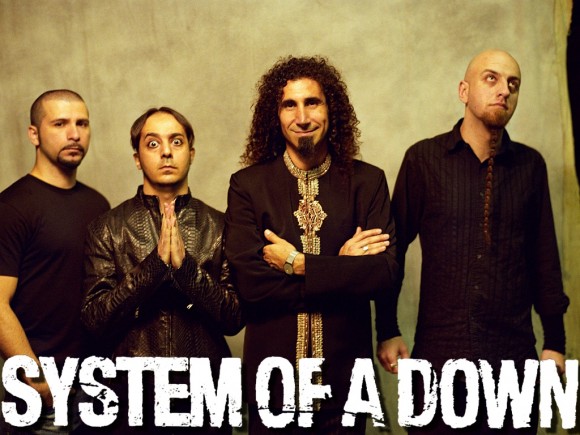
From left to right: John Dolmayan (drums), Daron Malakian (vocals and lead guitar), Serj Tankian (lead vocals and keyboards and rhythm guitar), Shavo Odadjian
That was the mid 1990’s and those 4 amazingly talented guys are Shavo Odadjian (bass), John Dolmayan (drums), Daron Malakian (vocals and lead guitar) and Serj Tankian (lead vocals and keyboards and rhythm guitar).Together as a band they have released 5 studio albums, selling over 20 million records worldwide. They have been nominated for four Grammy Awards, winning the Grammy for Best Hard Rock Performance in 2006 for “B.Y.O.B.,” much to the chagrin of artist such as Nine Inch Nails and Robert Plant. And very well deserved, as I’ve personally experienced they’re mastery in live performance many times over the years. You know something is special when the music speaks to you on so many levels. When the artistry, creativity, showmanship and love for what they bring to the world through music is transposed from their souls through stacks of amplifiers and out to the world. Not just as musical offerings, rather as multifaceted gems of interpretative light refracting beams far beyond what the eye can see, cloaked as chart topping music. Chart topping, Grammy winning Rock and Roll. At this level we are clearly speaking of truly rarified air.
So much so that in 2005 with rave review from the critics, the Grammy Award winning group topped a short list of talent in being the ONLY artists to EVER have 2 studio albums debut at #1 in the same year. The first album, Mezmerize, (released May of 2005) and Hypnotize (released November of 2005). Each debuting at #1 in the United States, and in other major markets around the world. Along with SOAD it’s “only” The Beatles, Guns ‘N Roses, and rappers 2Pac and DMX who can share such a notable and historic accomplishment.
Shavo with his signature goatee and hockey shirt “Odadjian”
on the back, worked the stage, crowd and bass to perfection. John Dolmayan gets more sound out of his drum kit than anyone could even imagine. Same for Daron Malakian, ripping riff after riff his guitar fills the air as an accompaniment to his vocals. Serj Tankian spits the political verses Rock and Roll style somewhere between opera, folk song, and Nicki Minaj rapid fire vocal antics.
The boys played straight through at PNC, no encore, and KILLED IT!!!! What makes SYSTEM such a great act is that they have successfully combined mixing so many musical styles from salsa breakdowns to commercial pop choruses with a homage to Armenian folk songs leading back to the type of Metal they do best, frenetic, perfectly-timed grooves backed by the best of the best thrash-metal riffs.
Bill Diamond Productions
Learn about the wide range of skills Mr. Bill Diamond, founder of Diamond Productions, uses to create his imagination into a reality. Bill took us on a tour of his self built studio to give us just a glimpse of where he gets his inspiration.
Creative Graphics Designer: Matt Swen
Creative Motion Designer Matthew Swensen or “Swen” shares his ability to create print and motion GFX in his own way. Swen is Ferro’s in-house designer and you can see a lot of his work throughout our website, FerroProductions.com
Catch Swen on Twitter and Instagram @MattSwen
To read Swen blogs click here!
Creativity takes Courage
On the back of our Ferro shirts is a quote by Henri Matisse, “ Creativity takes Courage.” Three simple words which every time I hear or see, take on a new meaning.
Throughout my career I have had the honor and blessing to work with some of the worlds most “creatively courageous” people. Many of the names would read as a who’s who across a diverse range of industries; from Broadway to aerospace; from CBGB’s to the Metropolitan Opera; from local access to HBO. There are also many names that will never be spoken of beyond a small cluster of people. In either case they all remain an inspiration to me and represent the spirit of creative thought. Their passion and dedication to their inner voice(s) should be the tales told to our youth at bedtime. Tales that would insure the next generation to learn to believe in themselves and dare to dream beyond the boundaries.
At first glance you may not think these people have anything in common. Although, when you strip away their window dressings and expose the essence of the person, you find they all possess a common trait, Courage. The courage to believe they have something to contribute, something of great value; the courage to follow a whisper in a world of rattling noise; the courage to stand-alone until others join them. Sometimes it comes in the form of a new combination or sequence of musical notes, other times it’s the interpretation of a landscape in a remote part of the world. I’ve seen it take place on the drafting table of a small architectural firm or in the lines of code written by a young software engineer. I watched as a healthcare worker reached beyond the boundaries of their education to heal the “lost causes”. I have witnessed and participated in “it” hundreds of times and ways, all starting with two basic ingredients, creativity and courage.
Many believe that these courageous people are without fear. That they are somehow immune from the feelings of ridicule, embarrassment or scorn from the more accomplished in their fields. Their lack of fear lets them succeed and create beyond the norm. It is fear that holds the rest on the MORE traveled paths. In my experiences I have never found that to be true. What I have found is that these “creatively courageous” people have just learned to balance their fear with determination and remain committed to seeing their beliefs all the way through to their conclusion. The ironic outcome is, many times, that conclusion proves their idea wrong or presents immoveable obstacles. It is here that they now balance that frustration with the courage to free their inner belief and try again.
I have learned that creative courage is not a unique trait. The masses say “You either have it or you don’t”. I say NO! I have witnessed over and over again, that creative courage is a learned art. One that we are all capable of mastering. It is not an antidote for fear. It is a skill that allows us to move forward despite our fears. Once you push forward with your fears intact, you would have learned the art of courage. It’s that simple.
We all possess the potential to change the world in some way. We all possess at least one talent everyone would be drawn too, courage is the amplifier that will let your voice be heard. Go and be heard…the world wants to listen…
Creative Courage allows us…
…to look past the obvious and traditional.
…to look past the guidelines we’ve been taught to judge oneself and others.
…to believe we found a better way.
…to believe we are right and they are wrong to tell us otherwise.
…to remain dedicated and determined.
…to walk away from the masses if you feel the masses are wrong.
…to try something new and not accept the status-quo.
Follow @FerroProduction
GoPro TimeLapse: NYC Skyline
Sunset Timelapse of the New York City Skyline shot in Hoboken, N.J. Shot on a GoPro Hero3 “Black Edition”
For more Go-Pro TimeLapse videos, click here!
GoPro Timelapse: NYG Practice (high angle)
TimeLapse of the New York Giants practice facility using the GoPro Hero3. We mounted the camera on one of the team video lifts for all of practice
For more Go-Pro TimeLapse videos, click here!
Photo Edit Breakdown
This past Sunday the New York Giants played host to the Indianapolis Colts in their pre-season home opener. For all of Big Blue’s home games, I use my Canon 7D camera and Sigma 10-20 mm lens to capture photos… Immediately after the game I check out all of the pics and decide which one I want to work on…
This week,
I chose the following picture:
Before I started shooting, I was aware of the fact that I would need to do some retouching to make the photo look just the way I wanted. As Andre began running onto the field, I started walking perpendicularly to him, all-the-while letting my camera shoot on motor drive to capture all of the background elements that I would need to use in post-production. Typically I could shoot other elements individually but
since Andre’s entrance onto the field happens all within about 20 seconds, I had to think of a quick work around. Ultimately I ended up using elements from 6 different photos to create my final product, using Adobe Photoshop and Adobe Bridge.
Check out the screen capture from my 2.5hr retouch session. (5000% of original speed):
GoPro TimeLapse: Giants Training Camp Live
Timelapse of the New York Giants Training Camp Live Show, shot everyday at 6pm post practice. The Timelapse was shot using the GoPro Hero3 camera starting from the beginning of the show until the full set was broken down and moved back into the studio.
For more Go-Pro TimeLapse videos, click here!
Lisa Marie Latino & Long Shot Productions
Lisa Marie shares her thoughts on how hard work, determination, and taking risks helped launch her career in the industry of broadcasting television.
For more information on Lisa click the links below!
RAW Flyover footage: NYG Opening Day
During the first game of the 2012 NFL season at Metlife Stadium the New York Giants and Major Mike LaPoint conducted a pre-game flyover with 3 UH-BlackHawk Helicopters. Ferro cameraman Frank Scacciaferro had the good fortune of being able to accompany Major LaPoint in the stadiums catwalk to get an EXCLUSIVE look at how this flyover was called and conducted from
Breaking Into the Biz
Our internship program will provide you with an opportunity to combine your hard earned book learning with some necessary real world experience. Ferro Productions offers one of the most hands-on programs specifically designed to make use of the talent and motivation in every intern. We offer a multitude of exciting opportunities for our interns, from the broadcast booth to behind-the-scenes and everything in between.
Contact: internship@ferroproductions.com
Visit: www.ferroproductions.com/contact
#GiantsCamp Finding Fun
#GiantsCamp always entails a 10+ hour workday. It is always hectic and MOST IMPORTANLY, it truly is always FUN!
“Find a job you love and you’ll never work another day in your life.”
Television is serious business. Work, in general, should always be handled with a sense of professionalism and significance … However, one must not forget the importance of what’s said in that age-old chestnut “enjoying what you do.” Here at Ferro Productions we take GREAT PRIDE in that pursuit, quite frankly, it’s fair to say that we are rather successful at it. After all what could be better than performing at the highest level in the entertainment world and having the best time doing it? Our client, The New York Giants, have also proved, they too are masters of the work-hard/play-hard mentality.
…That got us thinking…
With all the legitimate action happening on the football field that needs coverage, how does one capture the “Fun Stuff”?
Professional Football is a multi billion-dollar business… It’s also a game. When the masses think of these athletes,they tend to think of them as strictly “numbers on the uniform”… #10: Manning. #91: Tuck. #80: Cruz. Disembodied celebrities who do one thing and one thing only: Football.
Perhaps they only see them in the Twitterverse as @Weatherford5 (Steve Weatherford) or @PrinceAmukamara (Prince Amukamara) or @TeamVic (Victor Cruz) or @davediehl66 (David Diehl) or @IAMCweb (Corey Webster) or @RuebenRandle (Reuben Randle) or @BearPascoe or @HenryHynoski (Henry Hynoski)
They may even be recognized as Television Personalities that once wore a numbered jersey and now have Twitter accounts along with a vaunted seat in front of the camera and into the homes of millions. The likes of such celebrity as @CarlBanksGIII (Carl Banks) or Michael Strahan @michaelstrahan. The list is extensive…
The simple fact is that quite contrary to belief, these guys have BIG personalities; Eli Manning, Justin Tuck, Victor Cruz, and the rest of the guys on BIG blue.
Executive Producer, Joe Scacciaferro, elaborates… “These players are not machines. Sometimes our job is to personalize the players and capture the fun stuff that goes on during practice and on the sideline, etc. This stuff is GOLDEN for the fans. One may think that capturing this footage is simply luck of the draw, however, they would be wrong. It takes skill, thought, experience, and knowledge of your subjects and environment to capture such footage.”
With nearly two decades of Executive Producing for New York Giants Broadcasting, Mr. Scacciaferro has developed the skill, thought, experience and knowledge required for such capture.
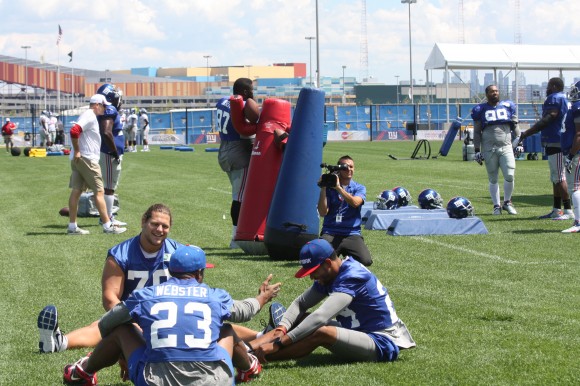
Ferro Camera-op capturing some “sideline talk” at #GiantsCamp between Defensive Back, Corey Webser, and teammates.
-Which camera-operator is the most qualified for the specific task?
-Which players are the “serious” or “quiet” ones? Which are the “Big Personalities”?
-Which drills or scenarios will provoke such behavior in players?
-In what manner does this footage need to be delivered to the television audience?
Joe continues, “ After all my time spent here with the Giants, there are some things that never change. For example, the Defensive Backs ALWAYS have big personalities. It’s no different now then it was when I started this gig. Guys like Rolle, Webster, and Ross are big stars with big personalities.”
With week one of Training Camp in the books, we have already captured an abundance of such footage, which can be viewed on all of the New York Giants Entertainment television and web broadcasts.
Stay tuned for more #FerroBTS insights as the weeks progress and we get closer to the Giants regular season opener against the rivaled Dallas Cowboys!
The Rise of a Broadcast Executive
What do the NBA, CNN, CBS and the New York Giants all have in common? Watch this video above to find out the answer! To learn more about Don Sperling click here
Paul Schwartz – Home vs Away Camp
“We could walk with someone to their car … talk to players in a much more casual sense, outside the cafeteria” for example. “In Albany the access was much different.” recalls Paul as related to access… And access is precisely what this mini-series is all about!
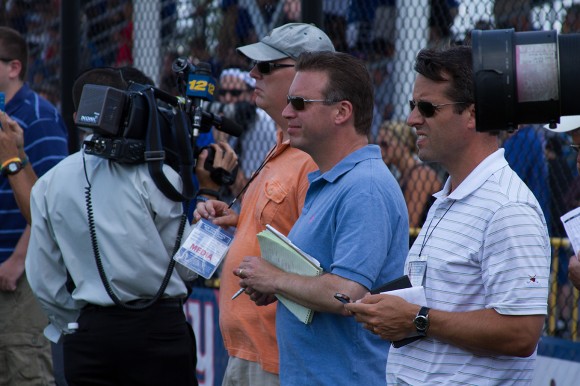
Mr. Schwartz (blue shirt) watches Giants practice from the sideline at the Quest Diagnostics Training Center.
The words above are from the very talented Columnist, Mr. Paul Schwartz. We at Ferro thought it would be a fantastic opportunity to share with the world what an amazing job the press does covering the NY Giants from the vantage point of our #FerroBTS lense. We couldn’t think of ANY BETTER WAY of doing it than asking Paul Schwartz if we could be embedded in his routine throughout his various assignments for the @NYPost as #GIANTSCAMP unfolded over it’s 5 weeks.
*Paul Schwartz has been The Post’s Giants beat writer since 1994. He’s also covered the Nets, Knicks and college basketball. He is the author of two books, “Tales From the New York Giants Sideline” and his recently published “You’re Wrong And You’re Ugly” with Sid Rosenberg. Paul is a SUNY-Albany graduate.
Both books, penned by Mr. Paul Schwartz can be found on Amazon here http://www.amazon.com/Tales-From-York-Giants-Sideline/dp/1582617589 and here http://www.amazon.com/Youre-Wrong-Ugly-Radios-Always/dp/160078321X . Each fascinating reads and we at Ferro especially enjoyed the Foreward in “You’re Wrong and You’re Ugly” written by Artie Lange, Comedian, The Howard Stern Show.
Yesterday we were privileged to spend a few minutes with Paul just before we began our LIVE broadcast segment for MSG+ (follow on Twitter @MSGNetworks). The question and buzz around #GIANTSCAMP in week one was focused on the differences between Albany and New Jersey as base for NY Giants Camp.
+40° 48′ 44.77″, -74° 5′ 6.72″ is pretty darn close to the coordinates of the front door leading to the New York Football Giants HQ, known also as the Quest Diagnostic Training Center.
+42° 40′ 58.93″, -73° 49′ 44.80″ is nearly smack in the middle of the sports fields at SUNY Albany. And outside of the fact that the #4 appears 5 times each, somewhere in the latitude and longitude, that’s where the similarity seems to end!
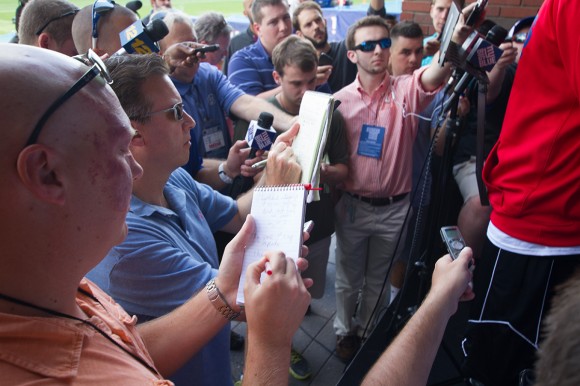
Paul, surrounded by the rest of the New York media, carefully noting the Giants players comments at the podium.
Paul brought up a very interesting point about how #GIANTSCAMP held at HQ (aka HOME) was for him, much more like going to “work” during the regular season vs packing
his bags for the month of August and literally going AWAY to camp for a good part of the summer. Of course this has to do with where one is physically located for work and residence throughout the rest of the year. Yet, the message seems to be that being AWAY was much more conducive to a relaxed environment for the media to work, as opposed to the more corporate structure that is currently present.
“For the past 16 plus years, I felt like I was going to training camp. I packed like people pack when going to camp. I packed my shorts, my shirts and my sneakers and even a tennis racket, and I went to camp for 3 or 4 weeks and it was CAMP. Kids go to camp and sometimes their Daddy goes to camp or their husband. So I was at camp and it was a whole different mindset. It was a different feel, this is more corporate.” Paul shares with us. Being a local press personality “it’s the same thing as coming to practice during the regular season. It’s much more of a business as usual feel but in the Summer, with no games.” Paul reflects.
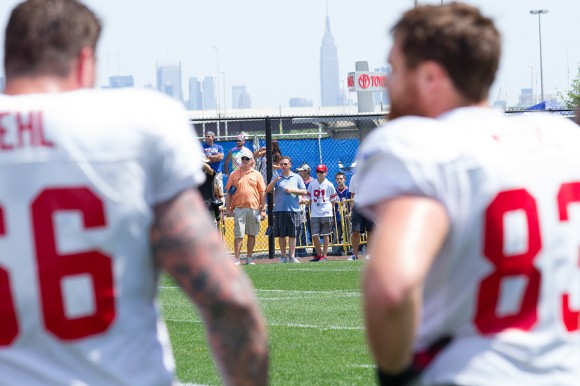
Paul watching today’s practice just above #66 Dave Diehl’s elbow
“Journalistically it’s not much different.” being in NJ vs Albany say’s Paul. “Now there are very big differences in how we do our job here… In Albany the access was much different. We were able to talk to players in a much more casual atmosphere such as walking in and out of the cafeteria. Here, we have to request any player we want. In Albany we also requested players, yet we also had the opportunity to get quick answers to smaller questions as we walked them to their cars right outside of the cafeteria.” With change comes opportunity and for the NY Giants as an organization, being in their own backyard naturally lends itself to many many more people across all media having much more favorable geographic access to the team, while being AWAY seems to have given fewer greater access to the players.
Next, we discuss with Paul how his stories always have a unique angle to them and how his creative mind formulates, composes and makes it all happen for his readers. Join us again for our upcoming and really excellent piece as we remain embedded with Paul!
Albany vs. East Rutherford
Change is it good or bad?
In which “CAMP” do you find yourself?
In the summer of 1996, the New York Football Giants partnered with State University of New York at Albany and began a sixteen-season relationship in which Big Blue called the Central NY campus home for the month of August.
That partnership has changed, and for that matter, so has the facility name of what the Giants now call “CAMP.” Change #1 from Albany, NY to East Rutherford, NJ. Change #2 from the Timex Performance Center to the Quest Diagnostics Training Center.
Formerly known as the Timex Performance Center, the Quest Center is ALSO the NYG’s state-of-the-art headquarters located just across the parking lot from MetLife Stadium, which will host Super Bowl XLVIII on February 2, 2014.
Let me elaborate briefly on what’s meant by the Giants “headquarters”. It’s home to;
- Ownership and corporate offices.
- Team training facility: Practice fields, weight rooms, meeting rooms, etc.
- Gourmet dining facility.
- Broadcast Studio and Control Room. (Ferro’s home base)
- Official Team Video Department and Studio.
All of the above and much, much more can be found within the compounds of the Quest Diagnostics Training Center. ANYTHING AND EVERYTHING THAT IS THE NEW YORK GIANTS, IS FOUND AT THE QUEST DIAGNOSTICS TRAINING CENTER, including the 4 Lombardi Trophies (found in the lobby on the left as soon as you enter the complex) celebrating their Super Bowl wins.
With the pattern being broken and the team going through training camp at home, the natural question for all, centers around this…Change – good or bad?
In this #FerroBTS (Ferro Behind the Scenes ongoing feature blog) there are a plethora of comparisons between Albany and Jersey that everyone is talking about and we at Ferro are personally curious about how said changes will translate into what we do, bringing the NY Giants Broadcast to you.
With that said, we are going to share with you the intimate details from the PRODUCTION perspective of what it entails, bringing NY Giants Camp coverage to the masses.
SPECIFICALLY expect from us, exciting, on the spot coverage of how WE cover those that are “covering” CAMP. (Media and reporters, players and coaches, NYG corporate staff, and the fans.)
All the hype surrounding the switch in location makes for fantastically interesting and somewhat unpredictable events driven by change… and we’ve decided to bring to you, in this EXCLUSIVE MINI-SERIES as much detail as possible, that will take you behind the scenes and deliver a personal production perspective of training camp, to YOUR home which is now being held at OUR home!
STAY TUNED throughout the remainder of training camp as we will be bringing you content available ONLY here, as well as additional features not found ANYWHERE else. Ferro Fans, Big Blue Fans, TV Production Fans….STAY TUNED!!!
Bill Diamond Productions
Creativity is everywhere. All across your city, your state, your country, your world… Contrary to popular belief, creativity is not isolated to the glittering sidewalks of sunny southern California. Furthermore- it is not isolated to any one area, period. Earlier this month our crew was reminded of this concept as we traveled to rural upstate New York where we sat down with a man who provided us with an absolutely mind-bending day, choc-full of creative inspiration.
Creativity takes Courage.” -Henri Matisse
Bill Diamond Productions has been around for the greater part of the past four decades; thirty-seven years to be exact. WOW… Let’s pause here. Thirty-seven years is a long time in terms of business, especially in terms of maintaining a successful business that continues to flourish as it approaches it’s fourth decade of life. OKAY NOW, LET’S RESUME… What exactly is Bill Diamond Productions? Where are they located? What have they accomplished? The answer to all of these questions can all be found by asking another question: Who is Bill Diamond? 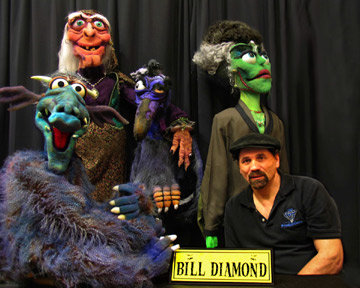
“I did some child acting, commercials for television… I was a child actor on Broadway, so yeah, you could say I got my foot in the door at an early age” replied Mr. Diamond after being asked about his start in the entertainment industry… and the rest is history, as they say. By the time Bill was in High School he was running his own theatre company; touring local playhouses across New York. In the meantime the young teenager was winning awards from the State of New York for stop-motion animation; an early indication that Mr. Diamond was not going to be the type of guy who was content with one job or one responsibility.
At the ripe age of nineteen Bill was introduced to Jim Henson, a legendary icon in the industry recognized mostly for his creation of the Muppet’s and Sesame Street’s puppet characters. Bill happened to be friends with Jim’s son, John…
Now take a moment to think about the landscape of the industry at this point. It was the late 1970′s and as Bill shares,” We felt like anything was possible.” Video was becoming a very usable media for the everyday person. It wasn’t just the television networks that were using video cameras now, there were students and everyday folks who were passionate about production who were now able to obtain their own cameras and create anything they wanted. With the combination of Mr. Diamonds creativity, talents, determination, and not to mention personal relationship with Jim Henson, it’s no wonder why he felt like anything was possible.
After working under the wings of Mr. Henson, Bill began realizing that he wanted to create his own identity. “Jim had a great way of taking talented people and letting them run with their dreams. He inspired me to be all that I could be, and that’s the greatest gift that I ever received from him.”
Next, Mr. Diamond decided he wanted to put a halt to his stop-motion animating and move on to the fast paced world that was television. He began creating commercials for national corporations such as IBM and Miller, making a name for himself, and building his own company all at the same time. Bill shared that he always did freelance work because he always wanted to keep his options opened. “One day I’m a lighting guy, one day I’m a director, one day I’m a puppeteer, and then the next day I’m doing makeup” says Bill… which brings me to a very important point… Bill continues, ” I felt that in order to be a good director or a good producer and if I wanted to run my own studio some day I had to know every ones job. If there are directors out there who don’t understand how EVERYTHING works, how can they even call themselves a director?”
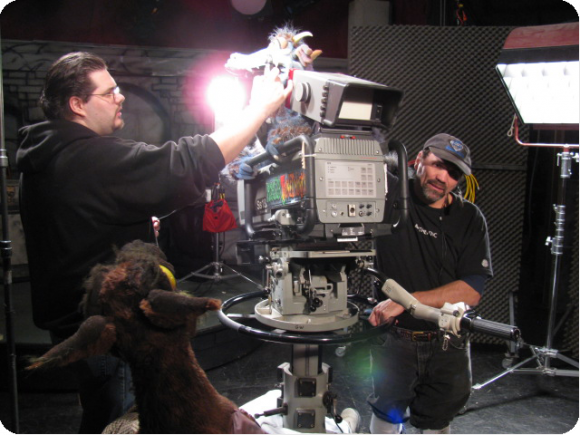
Bill Diamond in his television studio.
Mr. Diamond was certainly on point with that philosophy, as he now runs his very own “Dream Factory” (as we like to call it) in upstate New York. A full network studio, soundstage, editing systems, make-up rooms, not to mention an abundance of puppets and masks created by Bill for names such as Phantom of the Opera and Little Shop of Horrors. Yes- Bill’s creative concepts and masterful work have played a big role in Phantom, as well as Monster TV, and the list goes on. So with a resume as sexy as Mr. Diamonds, what in the world is his most memorable accomplishment? What is the one thing he cherishes most about his four decades in the industry? Well, Bill says,” Doing my work with Make a Wish. Putting a smile on the kids faces and helping raise money for these kids- that’s rewarding. Aside from that, it’s the people that I have met over the years in the industry… I cherish all of them. Those are some true life-long friends. I love everyone I work with.”
Bill Diamond should serve as an absolute inspiration to everyone: especially youngsters who think they want to get involved in the wacky world of entertainment. With that being said, I will even leave you with a suggestion from Mr. Diamond himself…
“Experiment with it all. Don’t limit yourself. Keep reinventing yourself everyday and remember: anything is possible.”
Check out more about Bill Diamond and Bill Diamond studios in our video series “Bill Diamond Productions: Creative Production Company.”
Ken Kelsch: Director of Photography
Ken Kelsch’s philosophy is very similar to that of Nike’s: “Just do everything,” he says. As a cinematographer with over 40 years in the film and television businesses, his resume is as polished as perfectly as an Officer’s shoes.
Kelsch has served as the cinematographer on 49 film projects, including 31 feature length films. He has also worked as the cinematographer on various television shows and commercials. His most notable works include the feature length film Bad Lieutenant and the NBC T.V. series Medium. But one would never believe how he had arrived at this point in his life with his divergent background.
Kelsch grew up in New York and was one of four children. His father passed away when he was 14, which left his mother with the sole responsibility of supporting all of her kids. Kelsch was still able to pursue his interests despite growing up poor and being fickle about his career path.
For Ken, photography remained an unwavering fascination of his. He had a dark room since he was twelve years old and it helped him cope with his bashful nature. He became president of his seminary school’s photography club and upon graduation of high school he decided that he wanted to become a doctor. However, that notion was quickly kicked to the curb when he sought to join the military during college, eventually enlisting in Special Forces and going off to the Vietnam War in 1965. “I didn’t think I was going to be around to see my twenty-third birthday,” Kelsch recalled.
Photography took a short hiatus for Ken because he decided that he wanted to put aside taking pictures and actually live his life to create new experiences. While working at MAC SOG Command and Control North 5th Special Forces, Kelsch and his fellow soldiers were responsible for cross border operations in Vietnam, Cambodia and Laos and were directly involved with interdicting trips coming into the Ho Chi Minh Trail. And although he wanted to stay in the military, he had second thoughts. He frequently pondered, “Would I make it through a second tour?”
Yet another life-altering decision was made when Ken left the military after his first tour and went back to school to finish his undergraduate studies. He chose to attend Montclair State University in New Jersey and reacquainted himself with photography after purchasing a new camera. The school had no film program, but there was a cinema club and Kelsch became the president. He “bullied” his way into getting funded and made his first film, which was his entrée into NYU graduate school.
His acceptance into NYU led to another enlightening decision. Since he couldn’t afford his tuition, Kelsch had to work full-time and save up. This experience really helped Ken come into his own. After he saved enough and was done working, he decided he was never going to work a steady job.
That inclination helped him pursue cinematography because he knew he would be able to work on different projects at different times in different places.
And this takes us back to Kelsch’s philosophy. During his time at NYU he hopped on anybody’s film shoot because he wanted to learn empirically. He believes the only way to truly learn is to physically operate every piece of equipment that you can get your hands on because those moments of instruction will lead to your success on another set. But sometimes, Kelsch would take matters into his own hands when he wanted to explore more equipment.
Every time he received a paycheck for the fruits of his labor, he would purchase new film gadgets. “I never made a profit off of a film because I would always buy gear with my money,” he said. He preaches the importance of using various film tools because cinematography encompasses EVERYTHING. The cinematographer is responsible for making the image under the director’s tutelage, determining the composition of the image, lighting it, framing it, protecting it; basically every step from start to finish. “You have to do the impossible every day and it has to be within a time frame. Plus you are dependent upon so many other people to exercise your vision,” Kelsch said.
Kelsch also made certain that he kept his “encyclopedic” knowledge of film up to date, and that many others should too, because there are people out there who will “cut their wrists” to do your job. For example, he believes lighting is the most important aspect of cinematography, which is why his wit is unremitting when it comes to that subject. “If the lighting is bad, then it’s a bad movie,” Kelsch said boldly. Lighting is important because it expresses personality, which helps shape one’s image.
“My kids used to ask me ‘Daddy what’s your favorite color?’ and I would always say ‘dark,’” chuckled Kelsch. “In my soul I’m a pretty dark guy, attitude wise and everything else.” He considers his job a failure if his image isn’t retrieved and portrayed, whether it is dark, jovial, or neutral. “I’m a mission oriented guy. I’ll do whatever it takes to get the image. That’s my job,” he said imperatively. If Kelsch could express his work ethic and success in terms of lighting technique, it would certainly be a very bright image.
Kelsch is currently working on Abel Ferrara’s “June Project” with Gerard Depardieu and Jackie Bisset.
To learn more about Ken Kelsch, click any of the links below!
TV: Creative Dimensions Professional Set Design
Founders William Violette and Joel Roy discuss how their set-design company became one of the television industry’s most prestigious names.
For more info on Creative Dimensions click here:
AUDIO: Giants Opening Day Rehearsal
Ferro takes you behind the scenes of the Audio/Performance rehearsal featuring Travie McCoy and Queen Latifah at Metlife
stadium before Opening Day of the 2012 season.
Associate Director and base-60 math
In my career as an Associate Director, I’ve been fortunate enough to work in varying AD capacities such as Control room, tape, post-production, sports and music. All those roles come with their specific responsibilities, as well as their own skill set needed to do the job.
One AD role is not necessarily tougher than the other. Each have their own challenges, and like everything else, the longer you do it, the better you get. Being organized, good at multitasking, maintaining your cool and able to work in chaotic environments are crucial skills, but the ability to do base-60 math, is essential.
Unlike normal math, which is based on 10’s, base-60 is the addition, subraction, division of seconds, minutes and hours. All these calculations are made within the confines of time. Television programs and all their elements are timed to fit within the confines of the time allotted. Elements can be any item that pertains or is to be used in the show, an item being an interview, playing a video, graphics, a host reading from a script,
etc. All those items have individual, preset total running times or TRT for short.
A one-hour program may contain only 45 minutes of actual show content. The other 15 minutes is set aside for commercials. The average commercial break is probably around three minutes, so simple division results in five individual three-minute breaks. Based on the five commercial breaks, the 45 minutes of the program will be divided into six segments. These six segments are usually not timed equally. The first segment may be 8:00 minutes, the second; 3:30, the third 4:45, etc., but at the end of one hour, all those different segment times will have to add up to 45 minutes. Throw in the 15 minutes of commercial time, and their sum should add up to one hour.
In a perfect world program segments would always be to time but rarely, if ever does that happen. In moments like those, that’s where the Associate Director’s role is most crucial, and base-60 math comes in handy.
Robotic Cameras at St. Patrick’s Cathedral
St. Patrick’s Cathedral in New York City is arguably one of the most historic landmarks in the United States. Since opening it’s doors in 1879, millions of people have visited, gathered and prayed at the cathedral encompassing an entire square city block from 5th Avenue to Madison Avenue between 50 and 51st streets in Manhattan. The building has undoubtedly seen its fair share of upgrades and renovations; however, the mission has remained the same. The man behind the idea, Archbishop John Hughes, shared the mission of St. Patrick’s 150 years ago when he envisioned this historic cathedral:
“For the glory of Almighty God, for the honor of the Blessed and Immaculate Virgin, for the exaltation of Holy Mother Church, for the dignity of our ancient and glorious Catholic name, to erect a Cathedral in the City of New York that may be worthy of our increasing numbers, intelligence, and wealth as a religious community, and at all events, worthy as a public architectural monument, of the present and prospective crowns of this metropolis of the American continent.” -Archbishop Hughes
That being said… It should come as no surprise that Sunday Mass at St. Patrick’s has become one of the most sacred and sought after experiences of many modern day church-goers. Not only in NYC, but worldwide, people want to be a part of mass at St. Pat’s…
Sean Cox has taken a diverse path throughout the production industry during the past few years. Starting off in the realm of reality television, Sean quickly made his way from a post-production intern with Leftfield Pictures to numerous production assistant roles on shows such as Monster In-Laws, Oddities, and Cake Boss. Further elevating his career, Mr. Cox embraced a job with Ferro Productions. Assigned to the New York Giants broadcasts and programming, he served as a camera operator, editor, and production assistant/stagehand.
Next, Sean decided to do what all successful people in the production industry tend to do, namely, keep searching for new gigs and never saying “no”. It was about seven months ago when Mr. Cox was asked to become a remote camera operator at St. Patrick’s Cathedral for Sunday morning mass. Recognizing this honor, Sean quickly accepted the job without knowing exactly what it entailed. Since then, Sean has spent a majority of his Sunday mornings filming the mass, among other duties.
Sean’s Sunday responsibilities would impress even the most seasoned production veteran. Sean explains, “I show up at 9 AM for the 10:15 mass and, well, I’m doing everything. Chipping cameras. Directing Photography. Camera Operating. Technical Directing. It’s like a one-man show, it’s really cool. I’m working like eight different positions. By 10:15 we are streaming live to the whole world via the web. I can’t take all the credit though. There is one other guy on the crew; he handles all of the Audio Engineering, which is a monumental task in itself!”
This means that Mr. Cox has no camera or show direction at all, no one calling for shots, no one telling him what things are supposed to look like; he’s doing it all on his own. Impressed? Well, consider this… Aside from a couple of crash courses from Sean’s co-worker, (fellow camera operator who Sean alternates Sunday duties with) Mr. Cox has acquired all of these skills (directing, producing, video-tech, dual robotic camera operator) through self-instruction.
Interestingly enough he attributes his quick learning and success to the following two things:
1.) Being familiar with both mass and production; how live TV shows are shot. This allows him to anticipate what is going to happen next to be able to have the correct camera in the proper position at a given point in time.
~AND~
2.) Playing video games. Sean compares operating the robotic camera to playing Xbox… HA! “It’s exactly like playing a video game. I have two joysticks controlling two cameras with a couple buttons. Except these buttons are focus, zoom, iris, and a fade bar, not A B X Y. You have to be smooth, efficient, and observant at all times.”
Probably not the most orthodox way to become successful in the industry, but as all of you industry professionals know, there really is no “textbook” way to make it. It’s not how you get there, it’s what you do once you’ve arrived. You either have it or you don’t and Sean simply possesses that “it” that so many people in the industry strive to achieve. Mr. Cox is loving the gig at St. Pat’s and boasts about the knowledge and experience he is gaining as he knows it will surely come in handy in the future.
On behalf of the Ferro Productions crew and the thousands of dedicated viewers of Sunday Mass, I would like to congratulate and thank Sean for his ambition and dedication.
MUSIC: Robert “Kool” Bell & the Gang
Go behind the scenes with the founding members of Kool & The Gang, Robert “Kool” Bell & Khalis Bell as they breakdown their hit song “Hollywood Swinging”.
STAGE: Managing a monumental production.
For almost 40 years, Art McLaughlin has been a pioneering member in the entertainment business. Mr. McLaughlin currently works as the Tour Manger, Production Manager, Road Manager, Lighting Director, and Video Director for the show Golden Boys , which has been on the road since 1985. Ferro Productions had the privilege of catching up with Art for an in-depth interview on his expansive career.
Other Stories about Art
Robotic Rick and the State of the Union
Rick Cypher, robotics camera operator is a seasoned vet in the production industry, specifically covering live events. In this segment Rick discusses the challenges and techniques he used and overcame while working President Obama’s State of the Union address.
Ken Kelsch: DSLR Rigs
Ken Kelsch discusses the value of a focus dedicated monitor, along with exposure considerations
MUSIC: Performing on the world’s BIGGEST stages
Watch and learn as world renowned Keyboardist and Synth Programmer, Dave Rosenthal, shares about his work experiences with Cindy Lauper and also discusses how he learned his craft.
Related Stories
John Bonanni: Stage Managing
Veteran Stage Mangager John Bonanni gives us a backstage pass to how he operates in the exciting world of live theatre and how he manages to keep his cool while managing actors, music, and lighting cues throughout the show.
Click here to learn more about Mr. Bonanni
CAMERA: Rick Cypher and “The Fighter”
Industry veteran Rick Cypher has spent the last 30 years of his life working as a Director of Photography. Listen as he discusses his on-set experiences with Mark Wahlberg while filming “The Fighter” and find out why Mr. Cypher was the perfect man for the job.
Other Stories about Rick
STAGE: How to get to Sesame Street
Learn about Dr. Loretta Long: Singer, Actor, Educator, and Original Cast Member of Sesame Street.
Ken Kelsch: Cinematographer
Cinematographer and Director of Photography, Ken Kelsch shares what goes into his everyday life on set and his unique experience shooting in Africa.
For More about Ken:
Up-and-Coming: Sean Cox
When people think about the most imperative job titles in a production house, seldom do the roles of Intern or Production Assistant pop into their head. Producer, Director of Photography, Audio Engineer; those are some of the usual suspects who collect all of the credit. In our newest Up-and-Coming Featured Article, Ferro Productions is going to show some love to the roles of intern and PA by sharing the story of a very talented young man and his journey through the ranks of the television world. What does it take stand out? Why are PA’s and interns a crucial component to ALL productions? And finally, what does the future hold for a hard-working individual at the entry level of our industry? Let’s find out…
“It’s crazy how far I’ve come from a twenty-one year old intern to now be shooting network cameras everyday.” –SC
Sean Cox was merely an adolescent when he began messing around with cameras. Between driveway skateboarding sessions and backyard wrestling matches, Sean was always that kid who was capturing all of the action for him and his friend’s future enjoyment. Years later Mr. Cox found himself at Marist University studying Public Relations, however, he was still honing his TV knowledge by enrolling in numerous Broadcast and Digital Media electives.
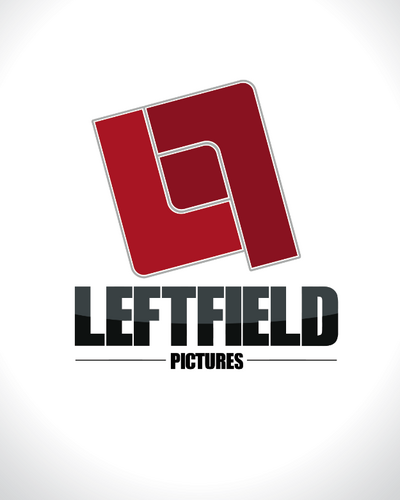 The knowledge attained from those electives certainly resonated with him, as Sean was hired as an intern for Leftfield Pictures on the brand new show Pawn Stars, at the age of twenty-one. His responsibilities included making calls and e-mails for show castings, as well as logging and transcribing of all of the video capture for the show. “As soon as I saw that the work I was putting in was going directly onto the show I knew that this is what I wanted to do for the rest of my life. Not being an intern for the rest of my life, but being in the TV business. The excitement and fulfillment was unexplainable” shares Sean.
The knowledge attained from those electives certainly resonated with him, as Sean was hired as an intern for Leftfield Pictures on the brand new show Pawn Stars, at the age of twenty-one. His responsibilities included making calls and e-mails for show castings, as well as logging and transcribing of all of the video capture for the show. “As soon as I saw that the work I was putting in was going directly onto the show I knew that this is what I wanted to do for the rest of my life. Not being an intern for the rest of my life, but being in the TV business. The excitement and fulfillment was unexplainable” shares Sean.
It took merely three months for Mr. Cox to ascend from Intern to Production Assistant with Leftfield. This rapid level of promotion was an early indication that Sean was not only a diligent worker, but that he also possessed the “it” factor that is required to make it in this business.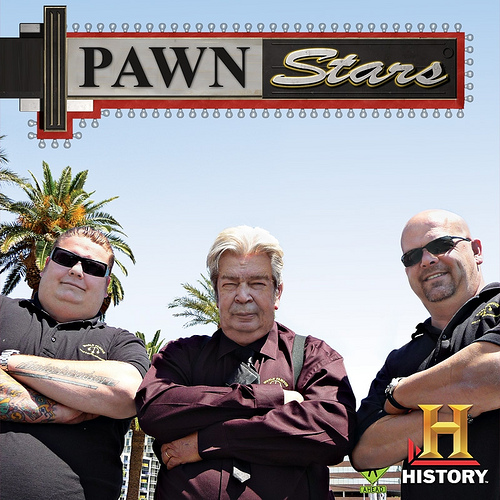
“It” includes, but is not limited to:
-Basic Knowledge
-Determination
-Passion
-Thick Skin
-Short Memory
Sean spent the next year and a half living in a Production Assistants paradise; working on shows such as Oddities, Fashion Hunters, My First Renovation, and Monster Inlaws. He shares, “If you mess up…you’re gone. Luckily I didn’t mess up and they kept hiring me.” With all the experience and success as a Production Assistant, Mr. Cox’s next move may come as a surprise to some. He decided to take an intern position for the highly recognized show, Cake Boss. Where many others would have said “no” to the demotion from PA to intern, Sean knew that he couldn’t let ego get in the way of the opportunity. During our interview he revealed, “I loved being out in the field with responsibilities as a PA but I didn’t want to pass up on building my resume and contact list. Plus it was such a popular show and I wanted to see how they did things.”
So it was back to scratch, so to speak, as Sean found himself logging and transcribing footage as an intern for Cake Boss. However, Mr. Cox and his “it” factor once again proved to catch the attention of Producers, as he was quickly promoted to Production Assistant. He shared, “Cake Boss was less work than the previous shows I had PA’d for because it was more established. The whole bakery was set for the show to be shot every day and there was a routine that everyone had already been accustomed too. Never-the-less, it was cool to be behind the scenes on such a successful show like that; definitely a great learning experience.”
After a few episodes as PA on Cake Boss, Sean kept the pattern rolling, as he accepted an intern position with the New York Giants Broadcasting Department. From intern to PA, back to intern, then to PA, and now back to intern?
“This time it was different though. I was working for the New York Giants. I was in the presence of Eli Manning and Justin Tuck… every day.” For a football fanatic like Sean, this was a dream gig. Oh and not to mention… after the first few weeks of Cox’s “internship” he was shooting camera and editing segments for the Giants daily programming on FOX, MSG, My9, and Giants.com.
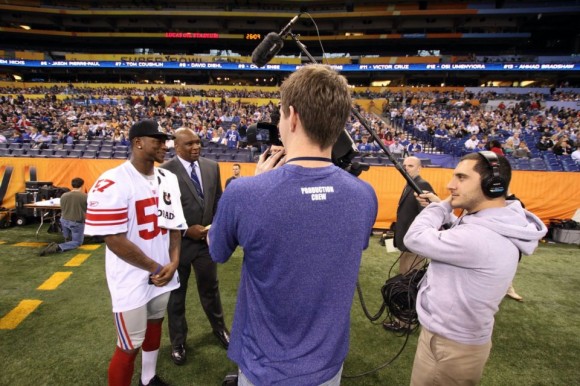
Sean Cox capturing an interview on-location at Lucas Oil Stadium during Media Day for Super Bowl XLVI.
Now in his third season with the NYG Broadcast Crew as Camera-Op and PA, Mr. Cox finds himself expanding his already vast array of experience, while freelancing in the NYC area. Whether it be operating the robotic cameras at the coveted St. Patricks Cathedral for Sunday Mass or shooting camera for the New Jersey Devils, Sean is definitely an up-and-coming member of this industry that will be providing talent and creativity for years to come.
“I love the energy and the pressure of this business. It’s really exciting. I’m also really excited about the direction that the industry is going with all the new technology. It should be fun.”
New Insider at Ferro!
Ferro recently had the opportunity to venture deep into the life and career of renowned Cinematographer and Director of Photography, Ken Kelsch, as he sat down with Joe Scacciaferro for an on-camera interview. Ken’s knowledge and experience in the industry is second to none, which is why we are very excited to announce the installment of Mr. Kelsch’s very own video blog under the Insiders tab here on FerroProductions.com.
Be sure to check Ken’s Insider page periodically for a full gamut of production knowledge; from chatting behind the scenes with Hollywood movie directors, to product reviews, and more! Enjoy.
